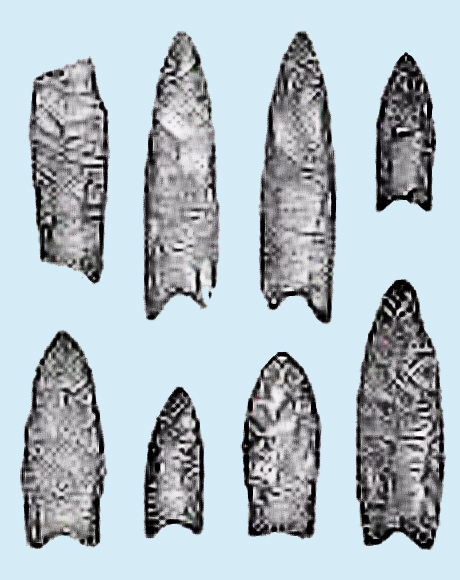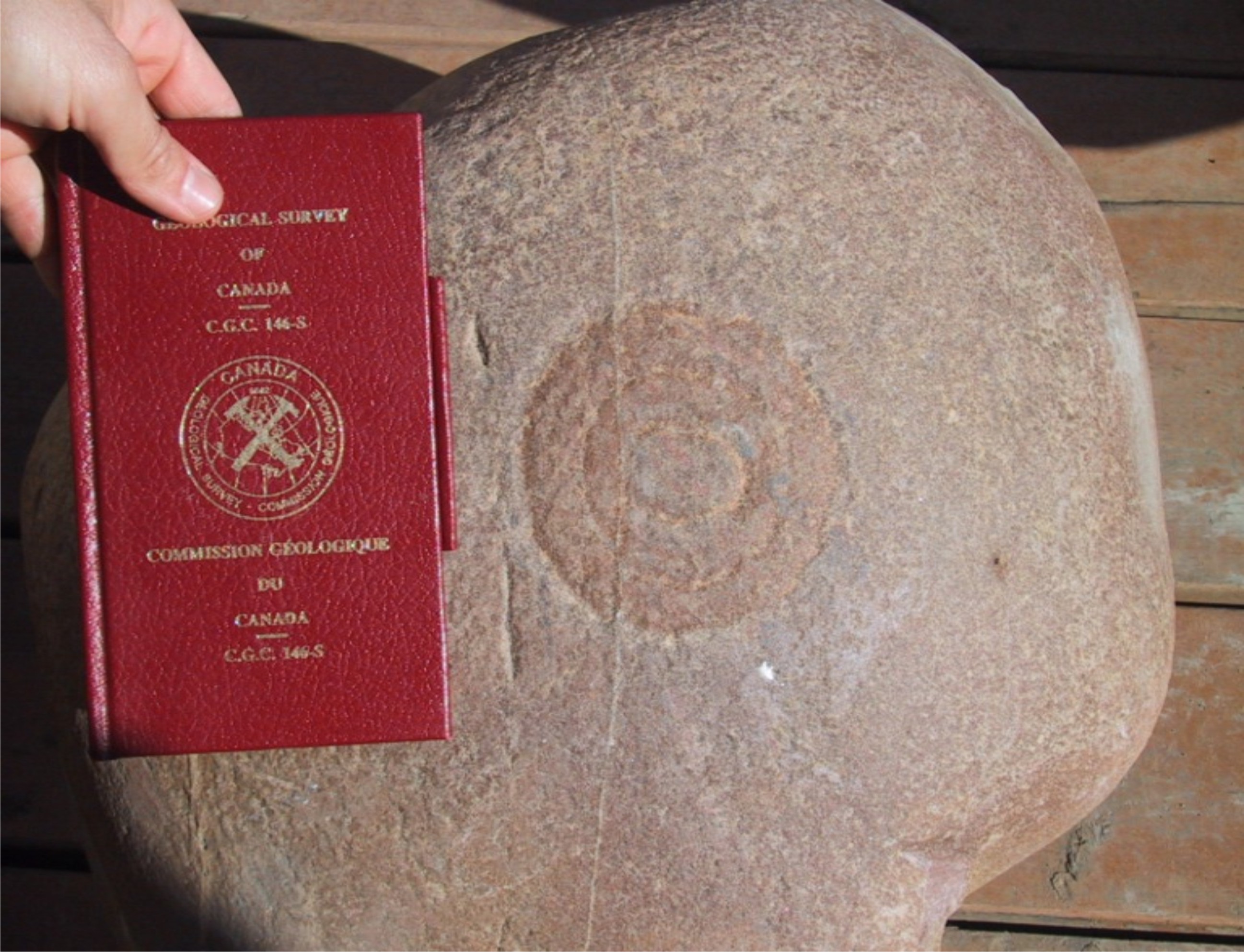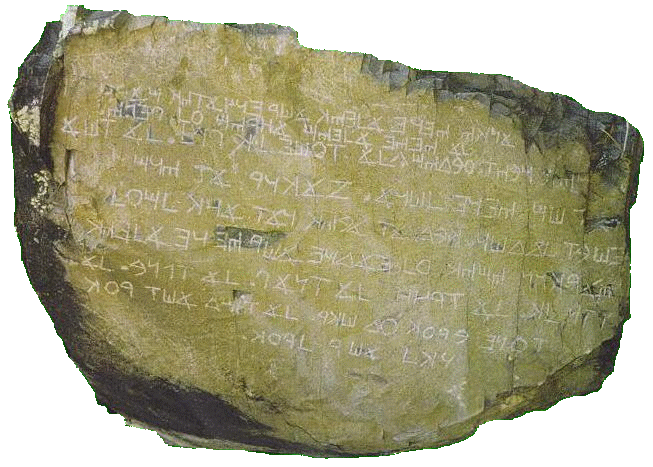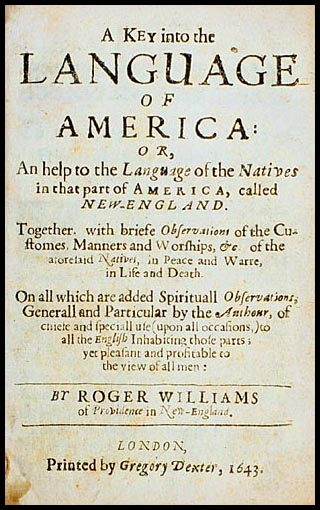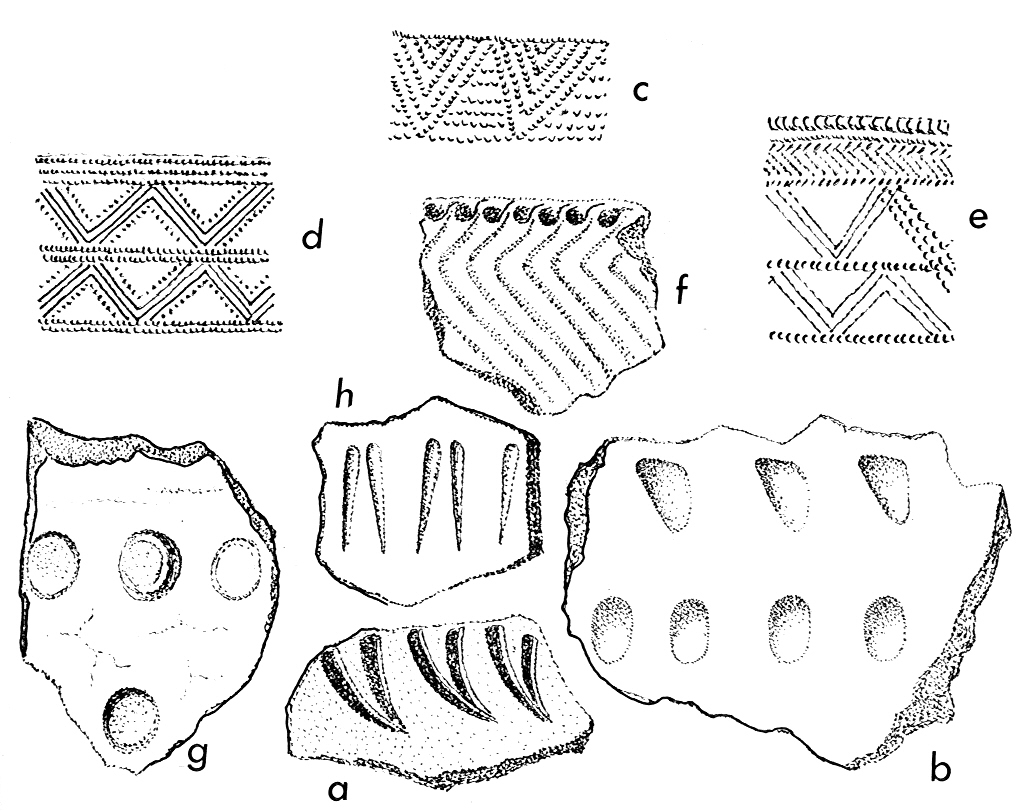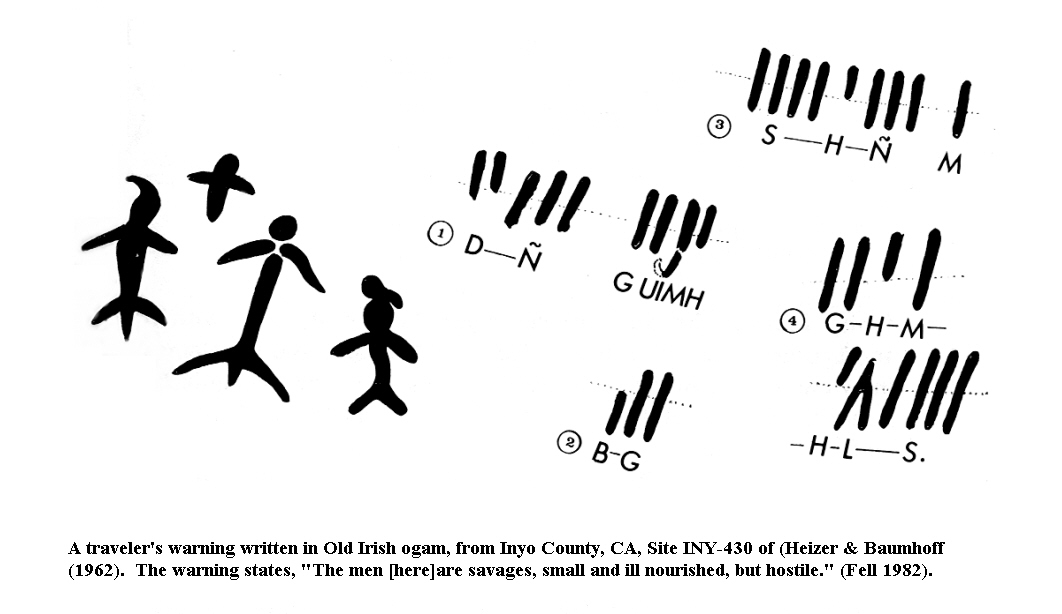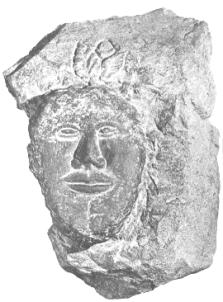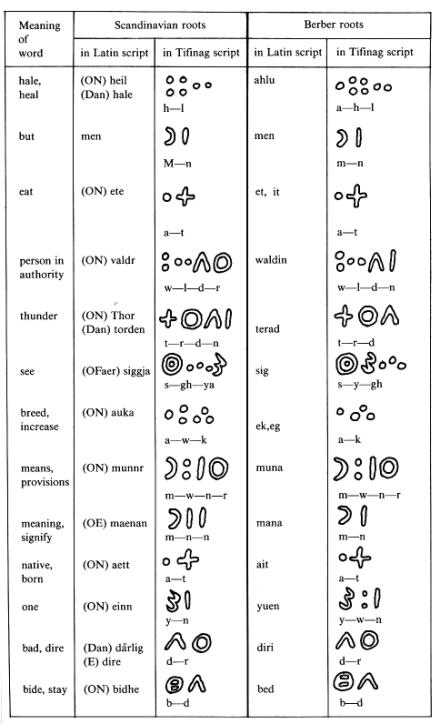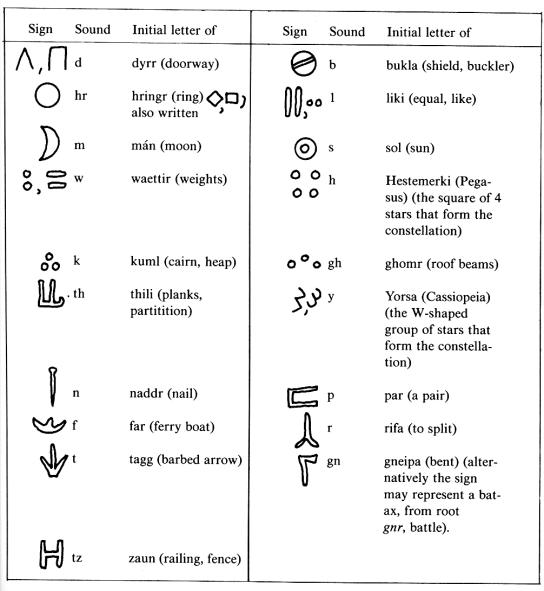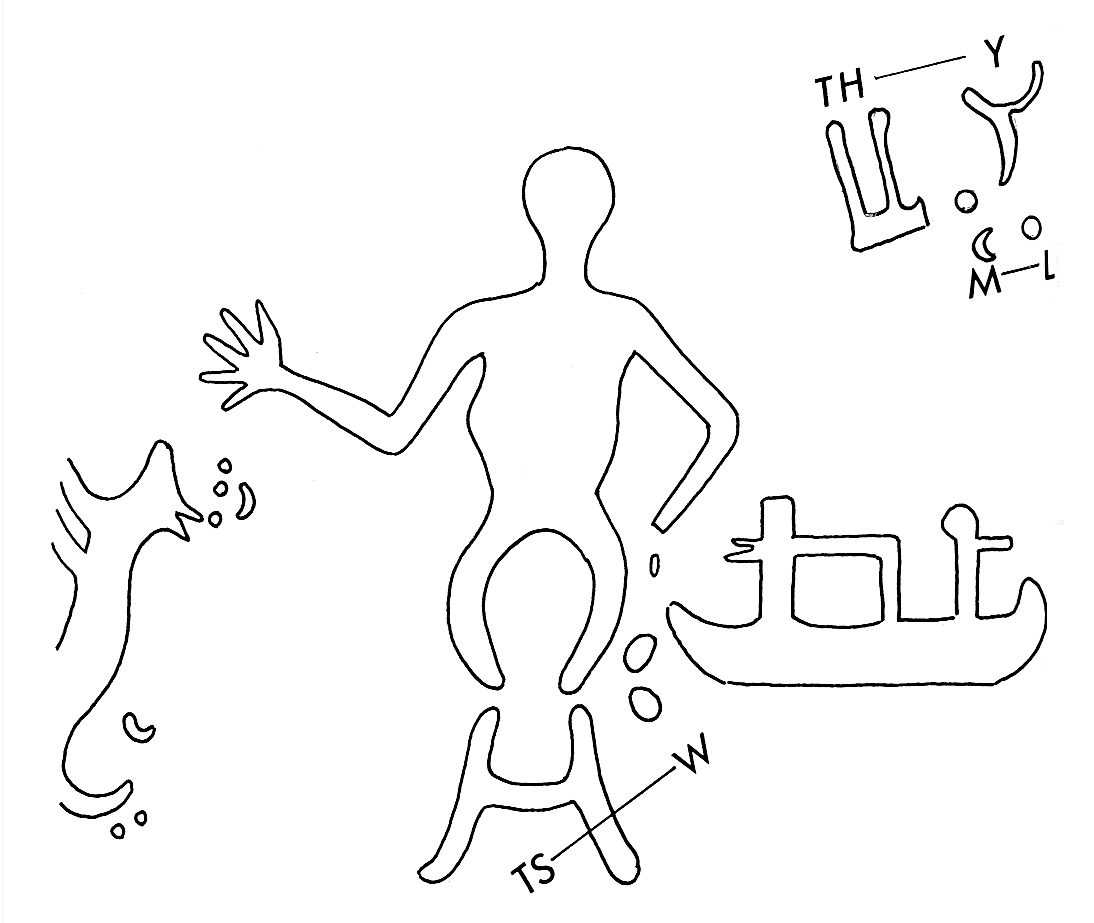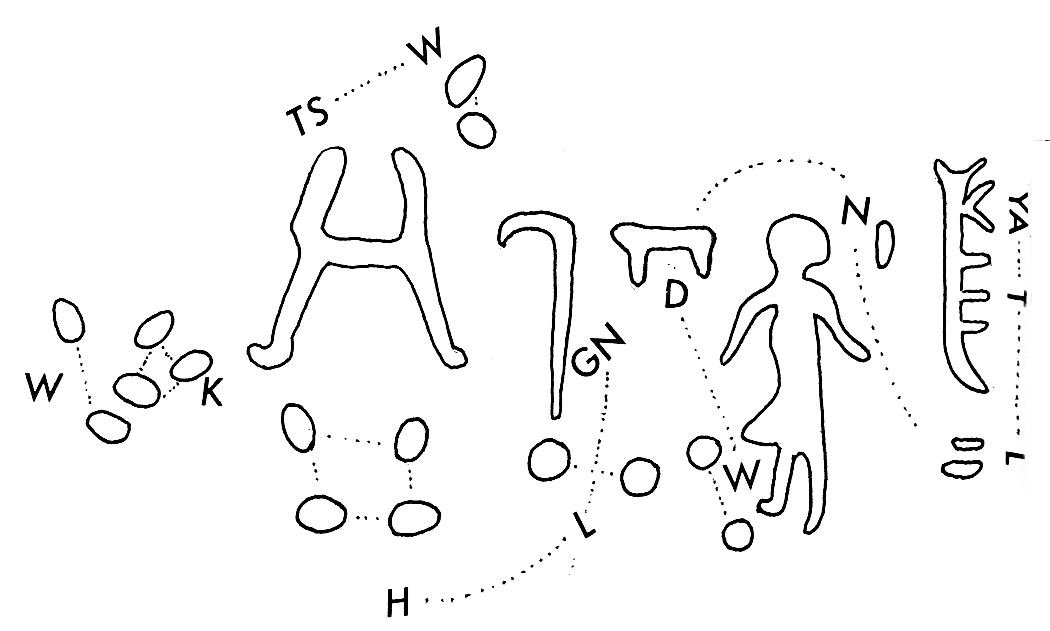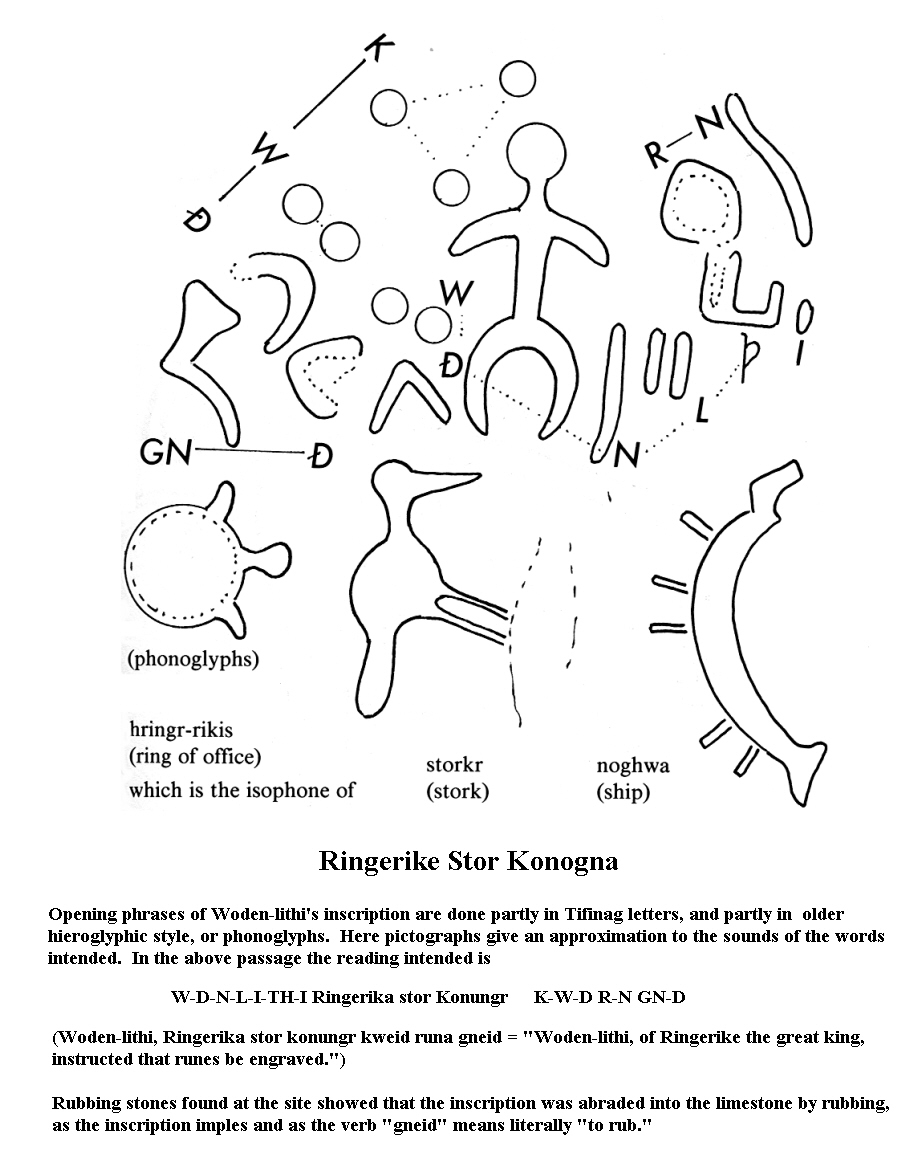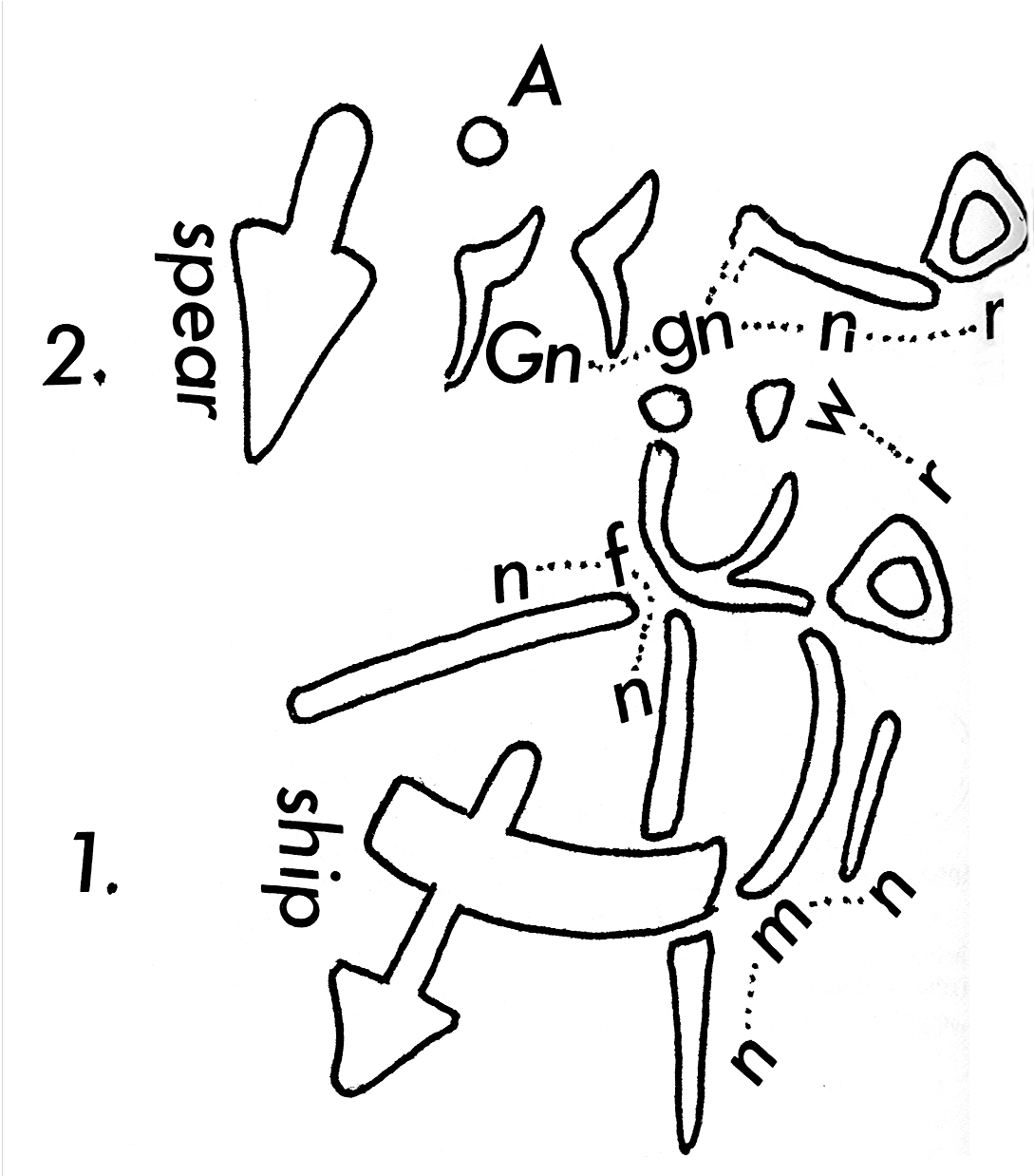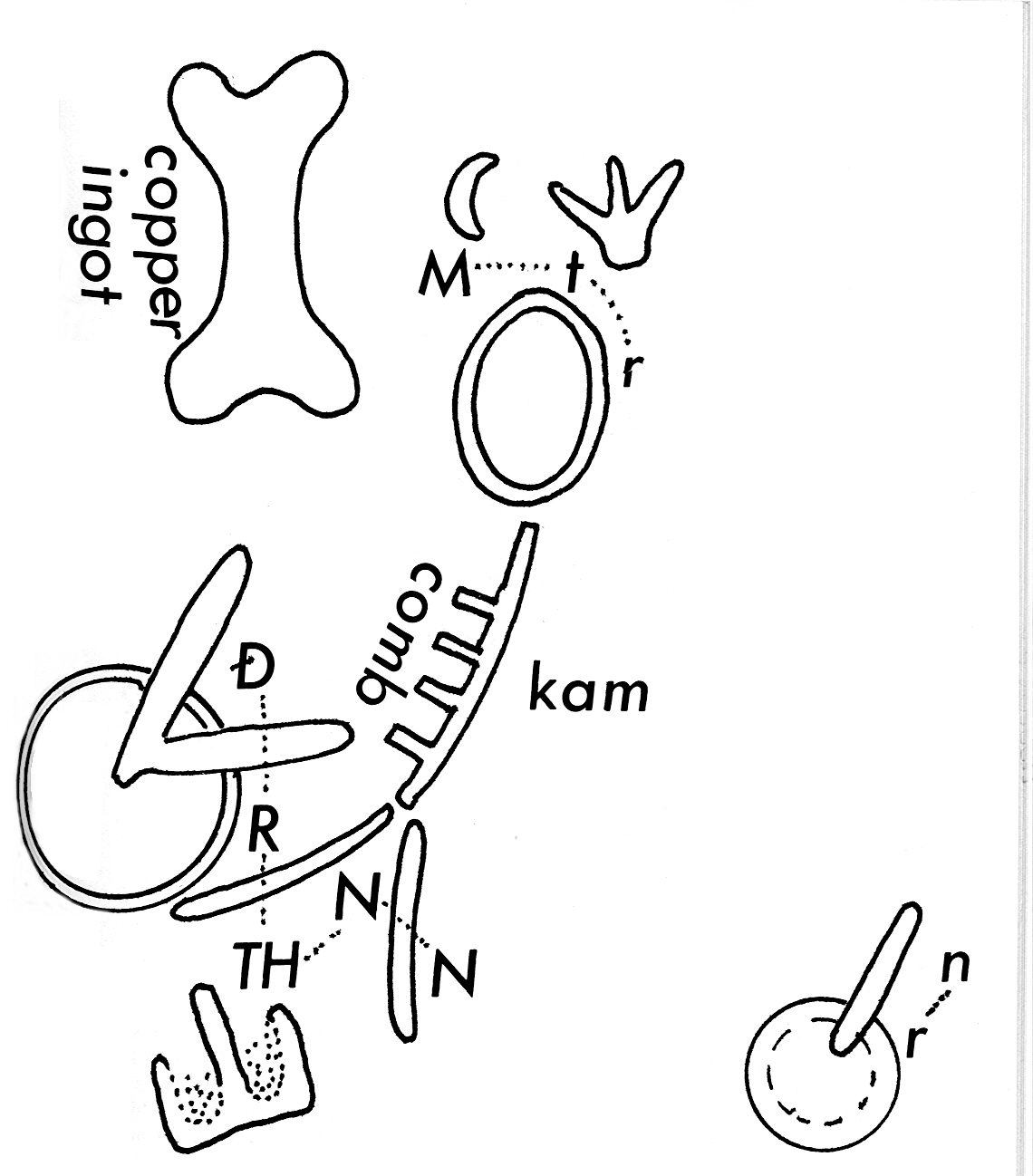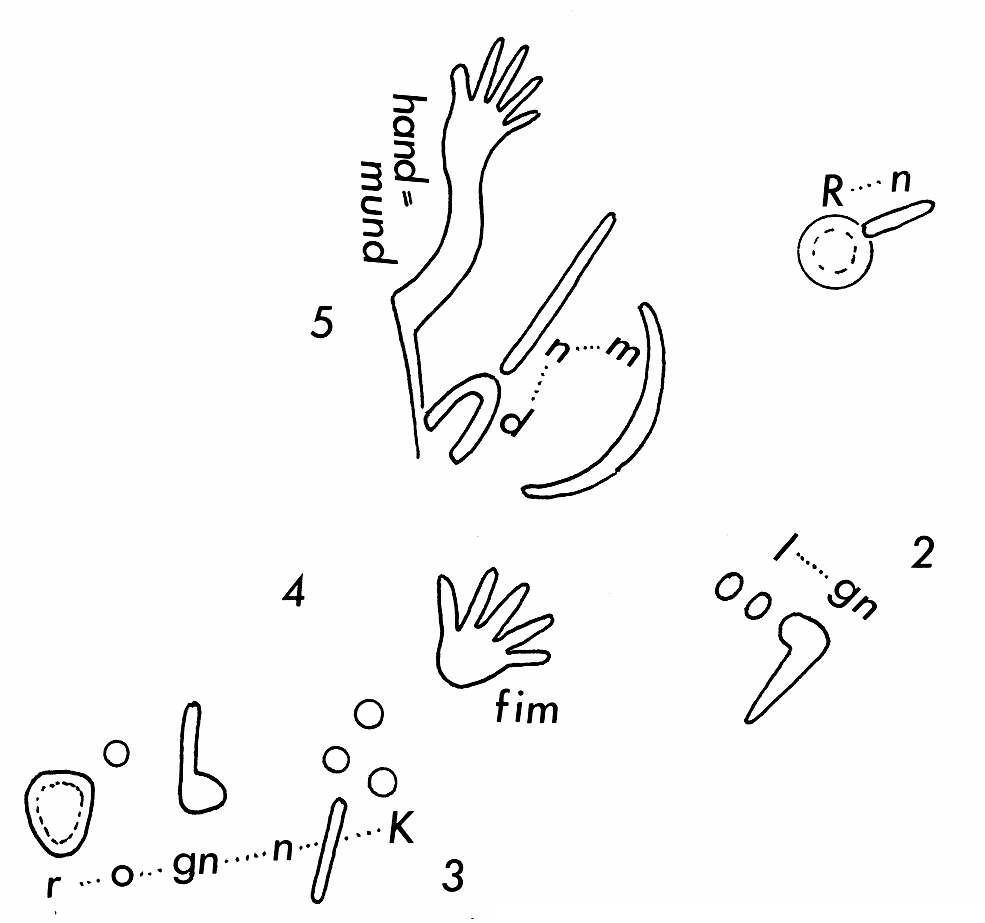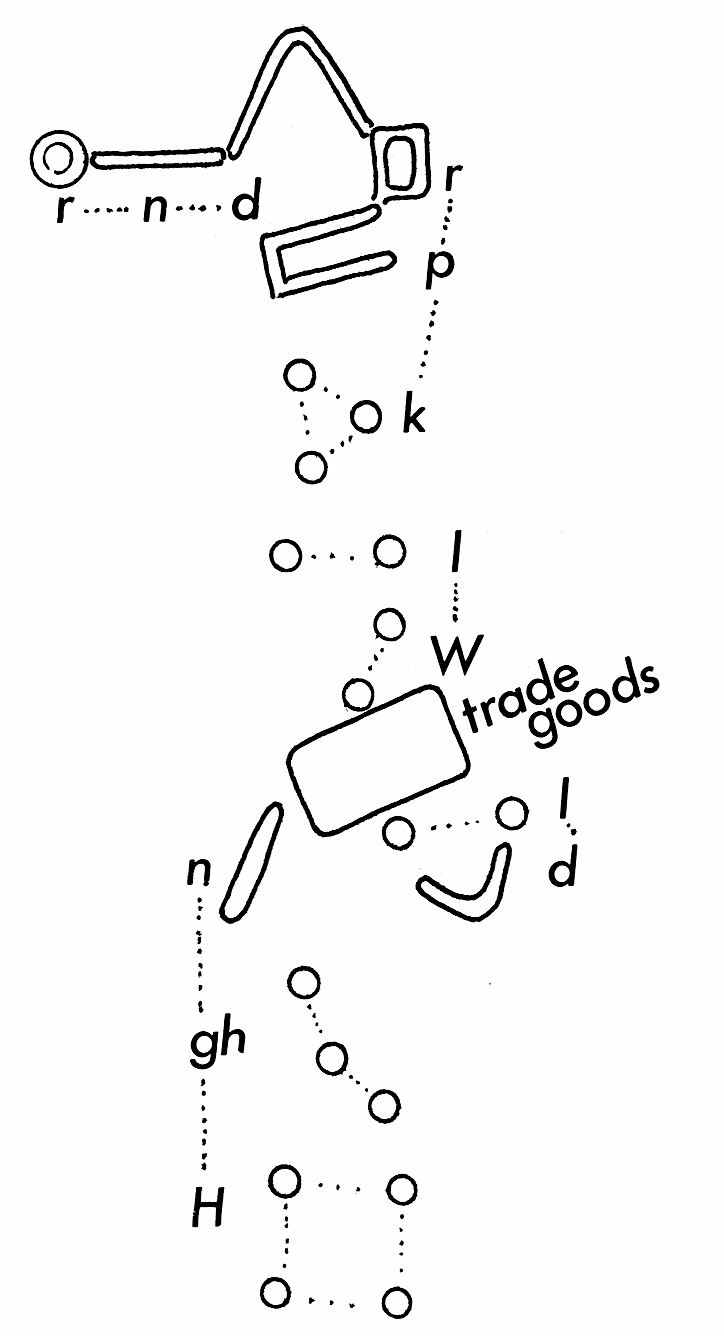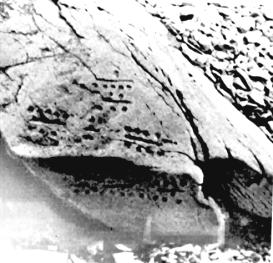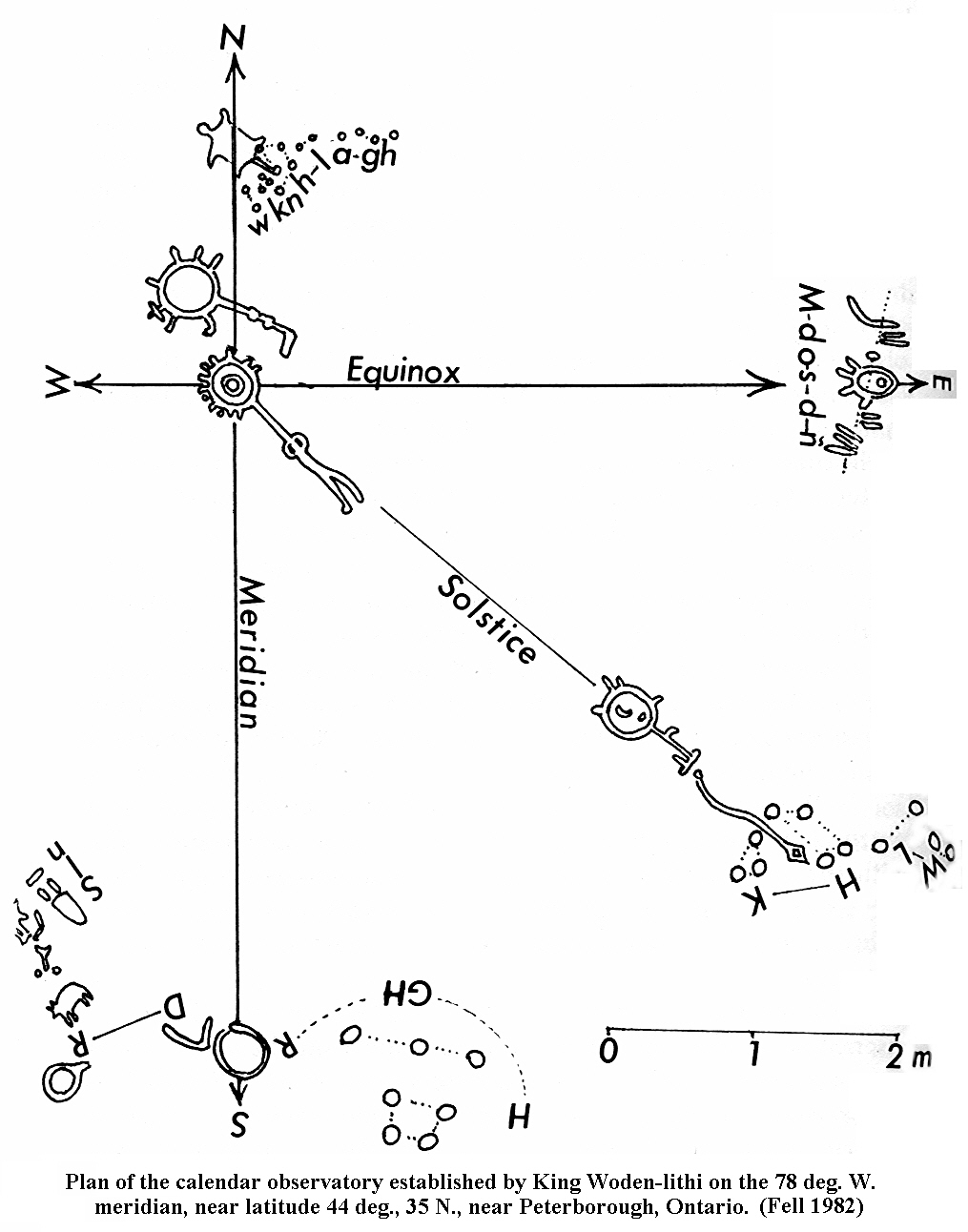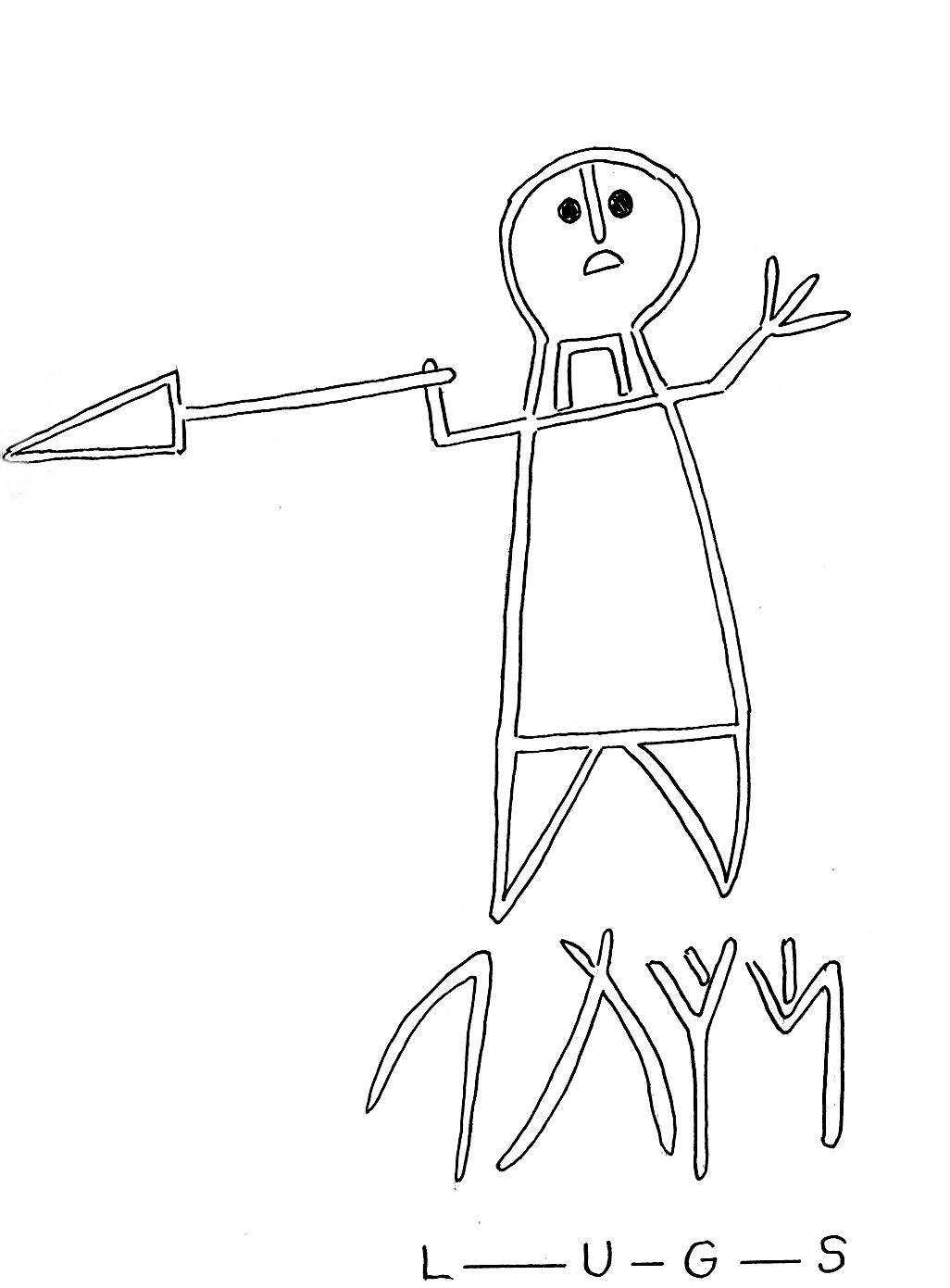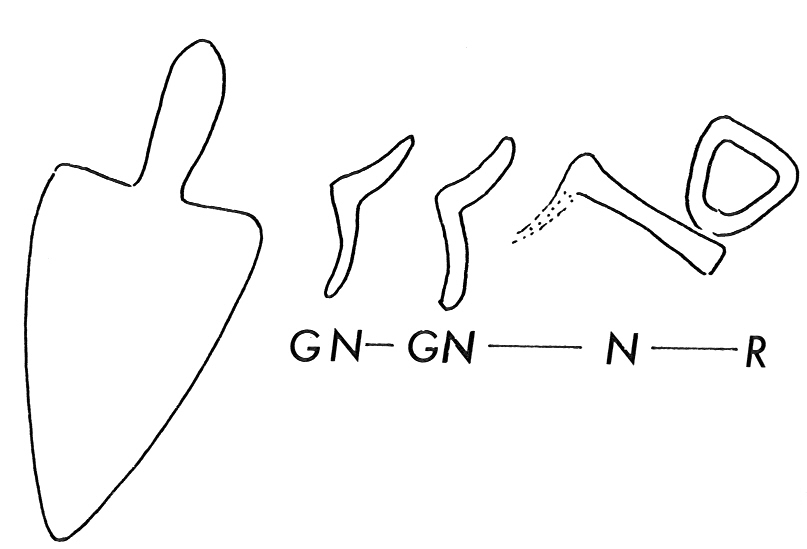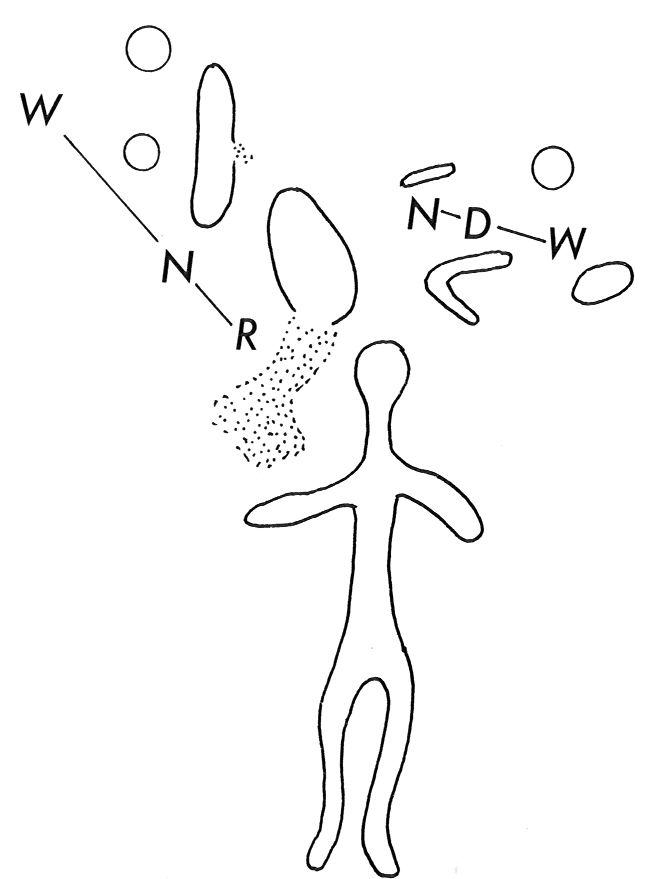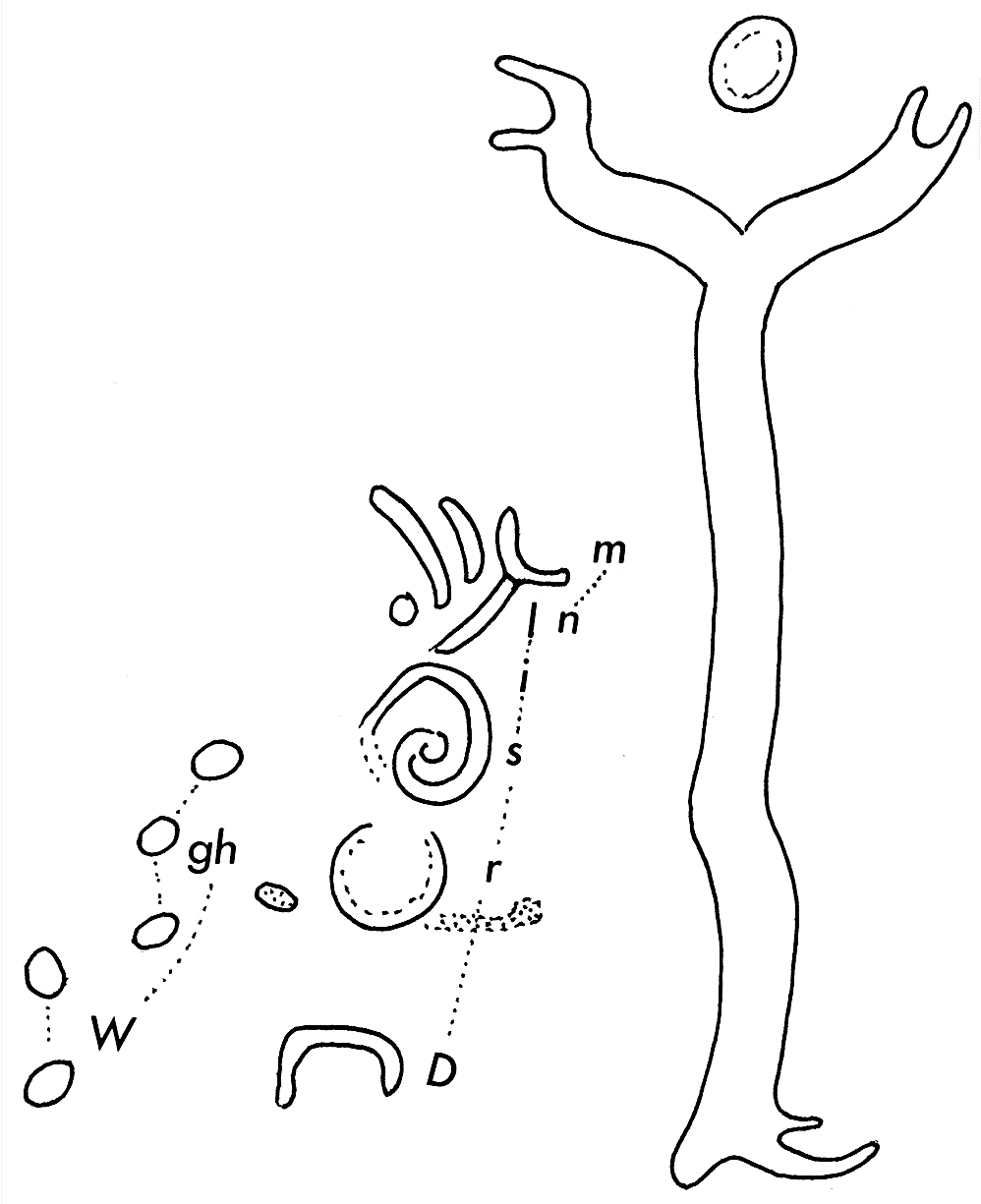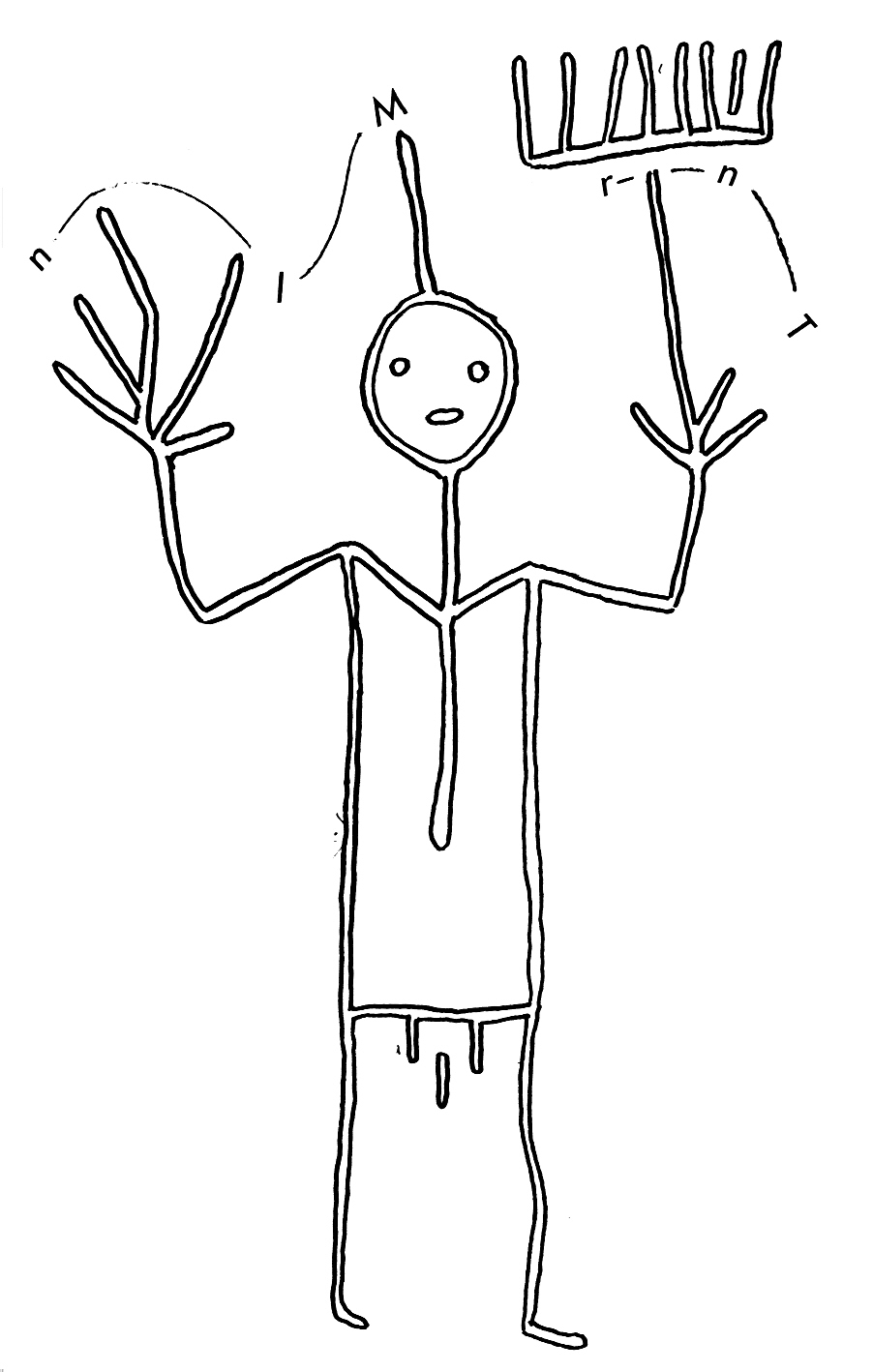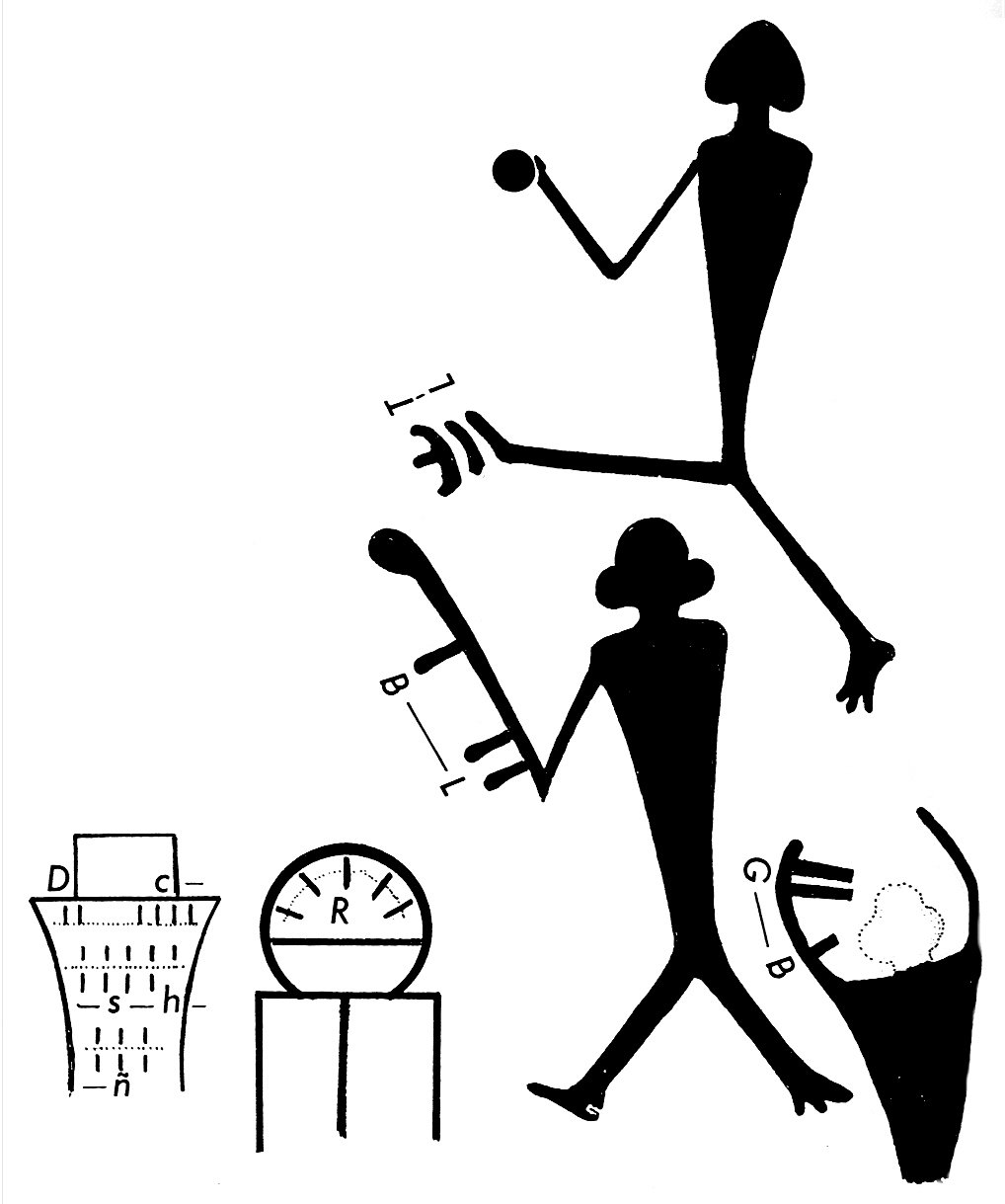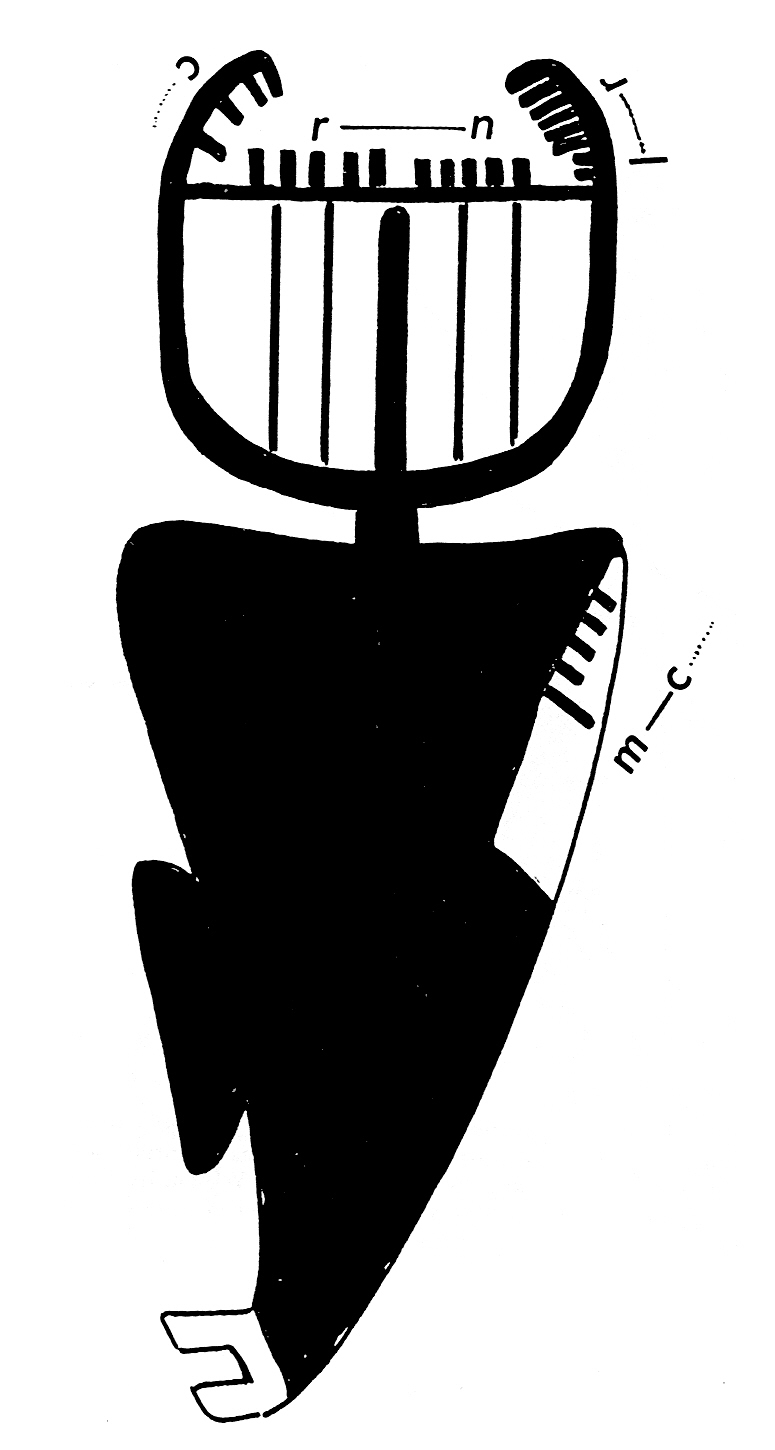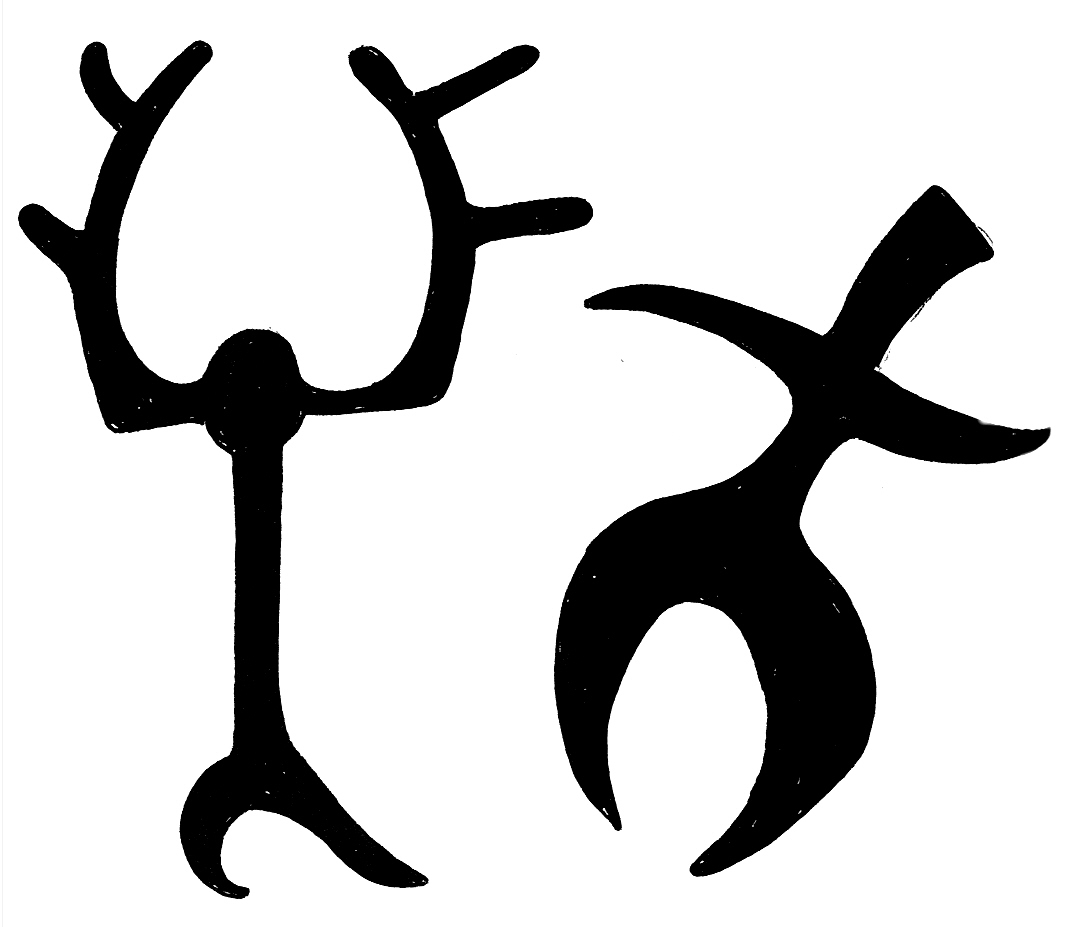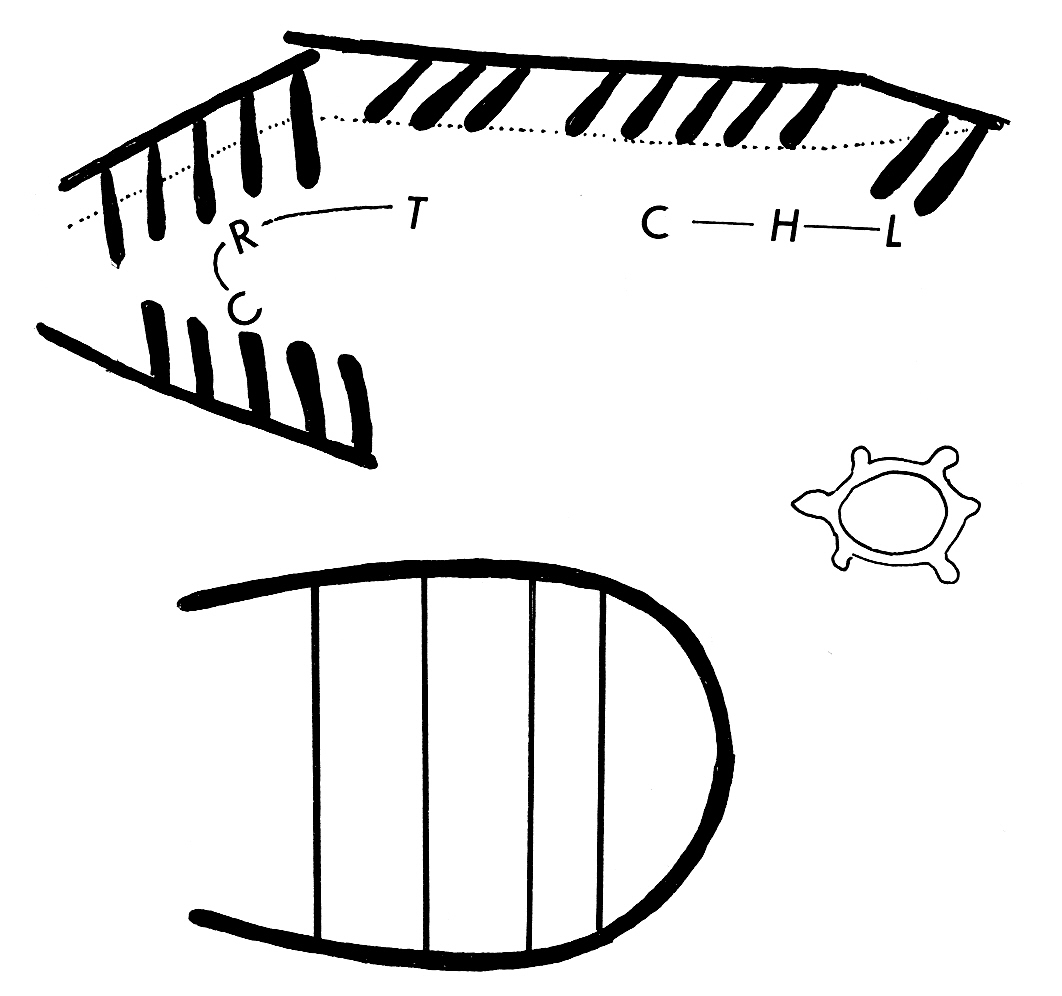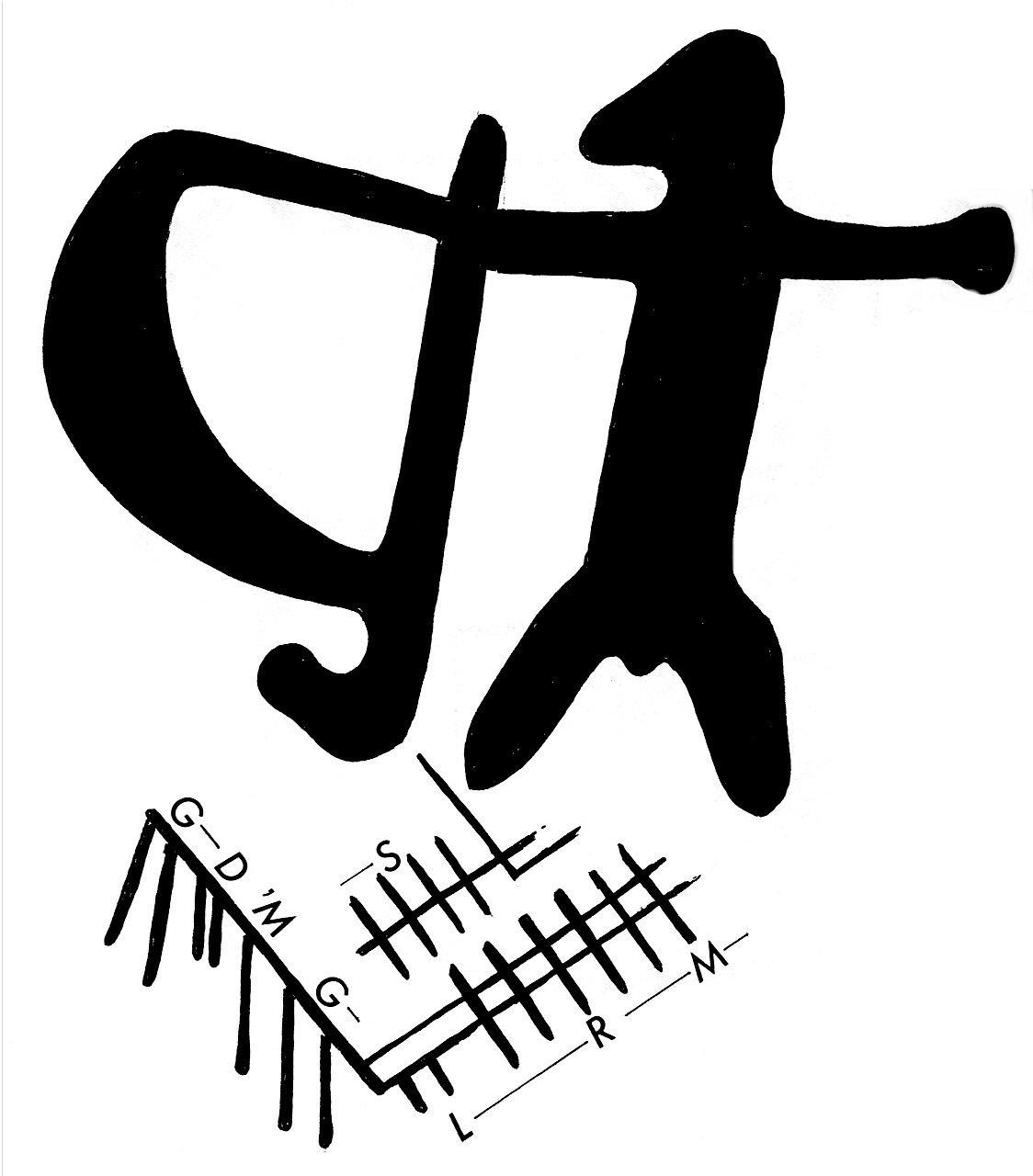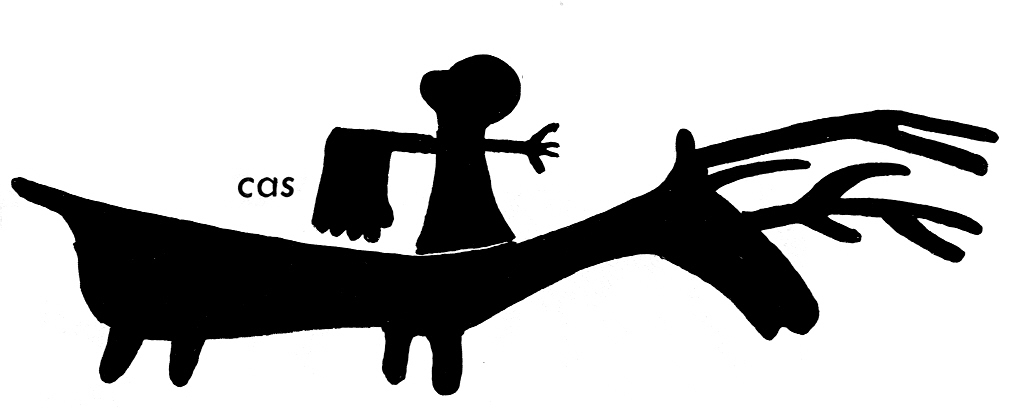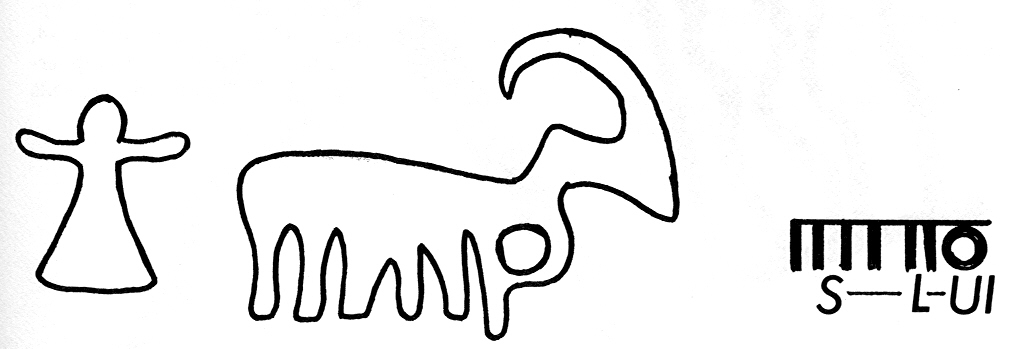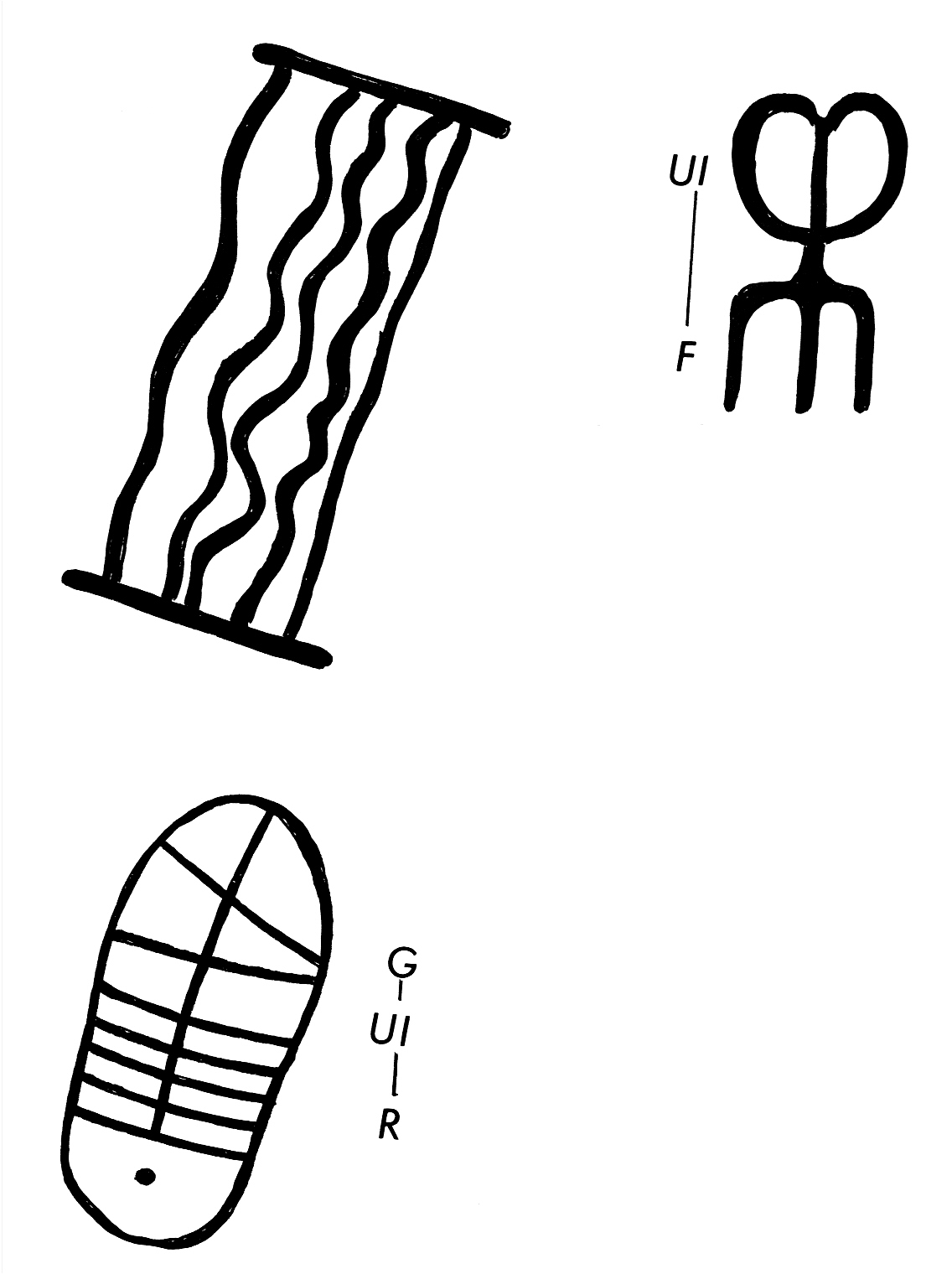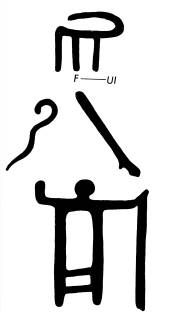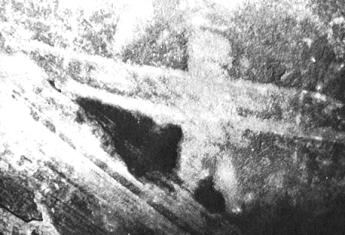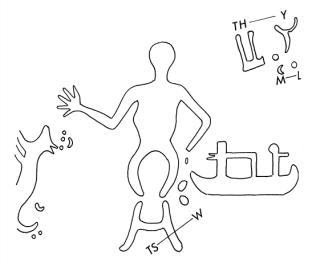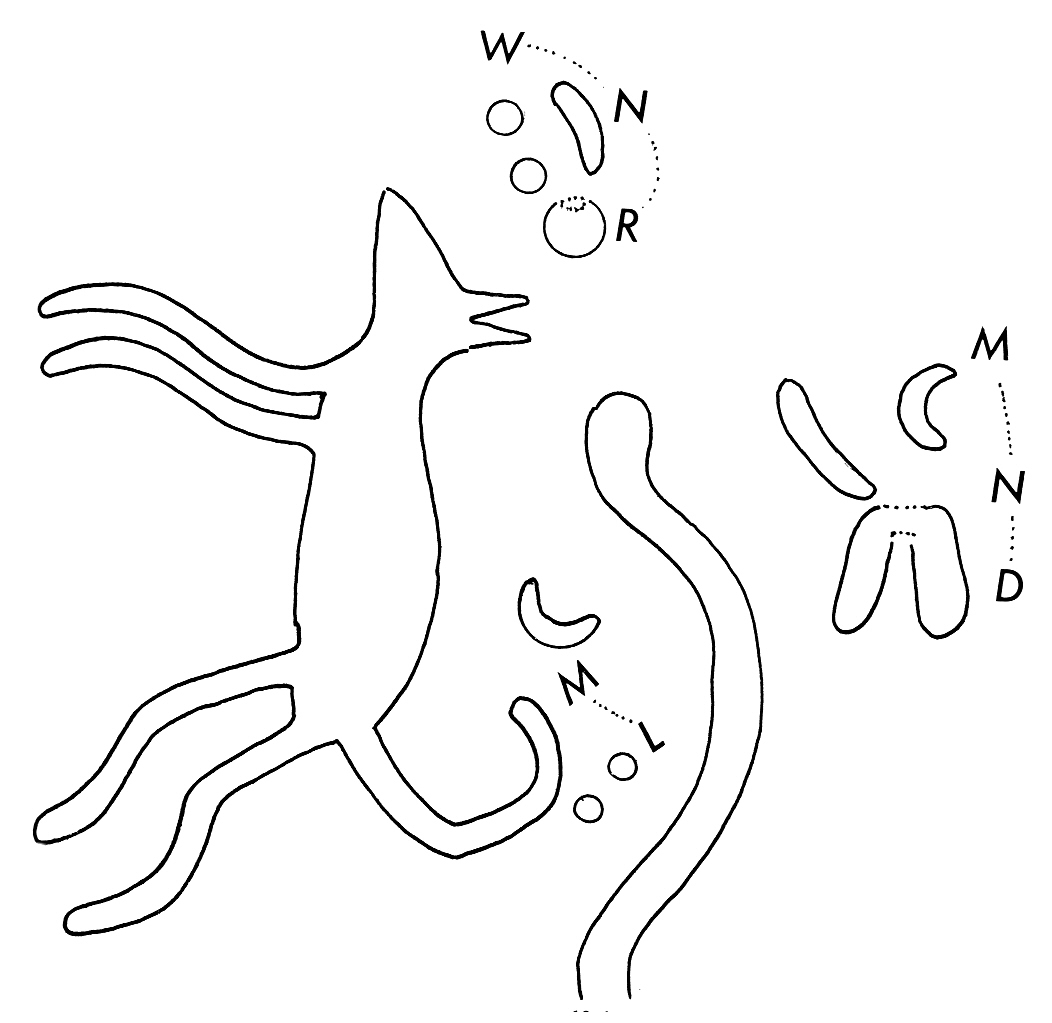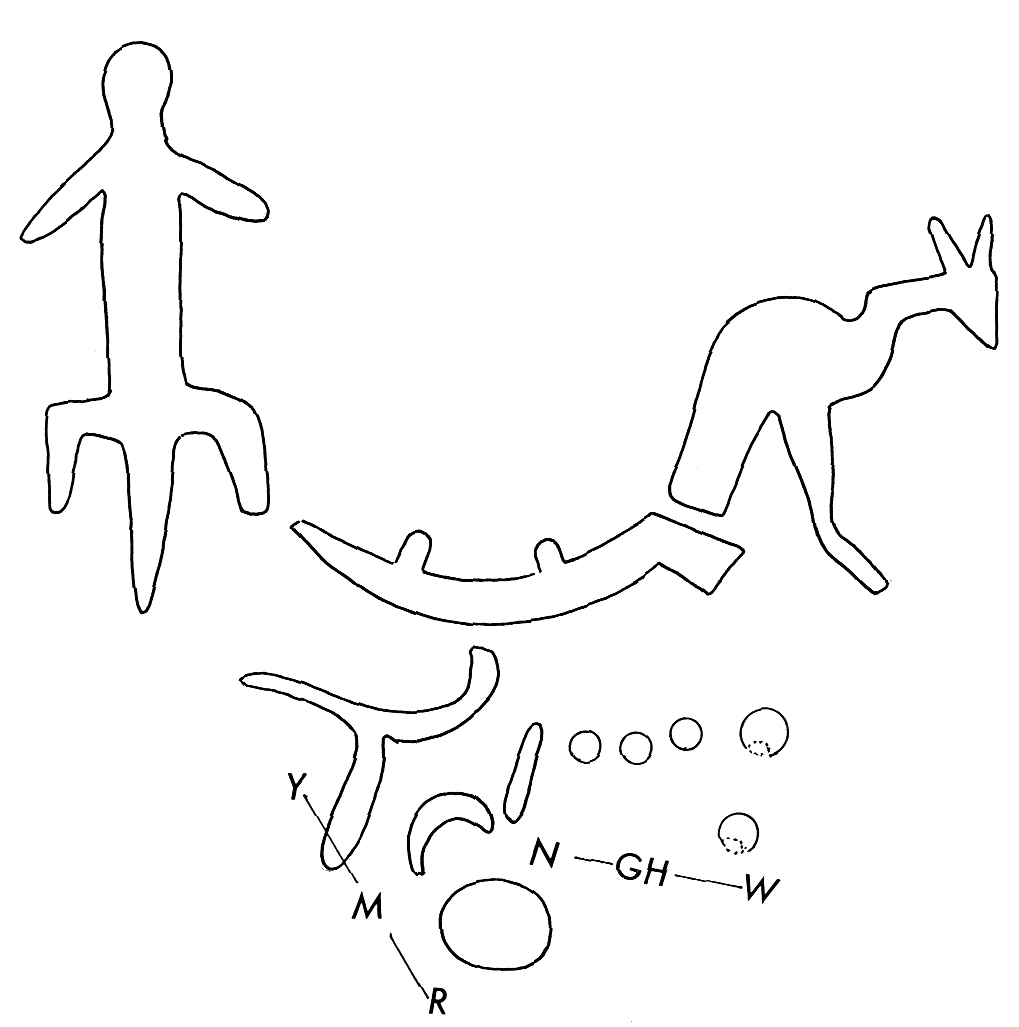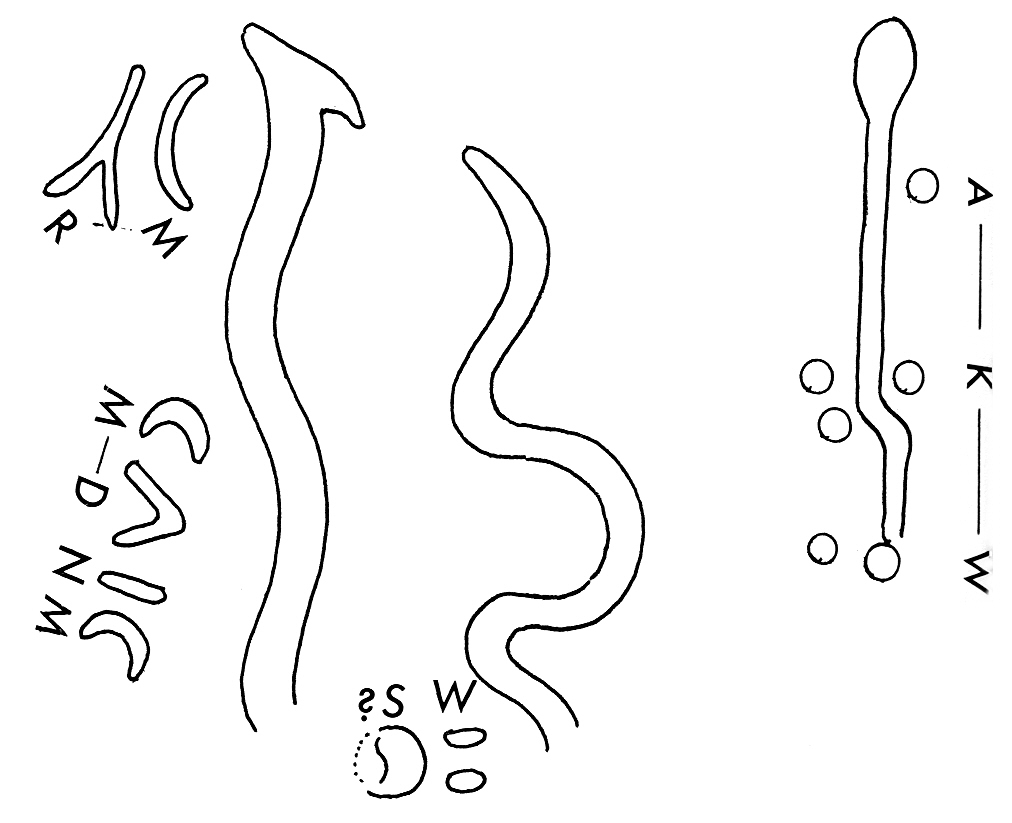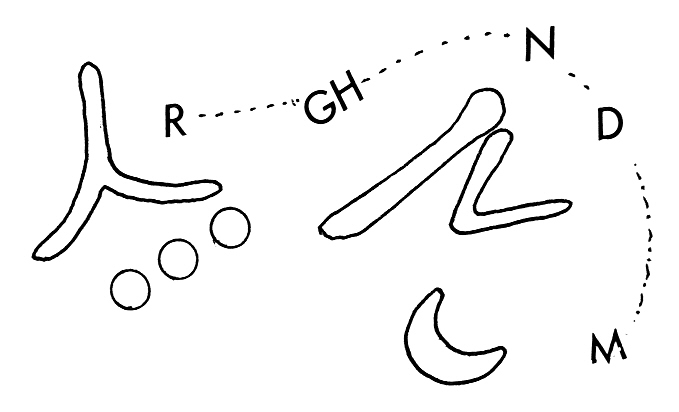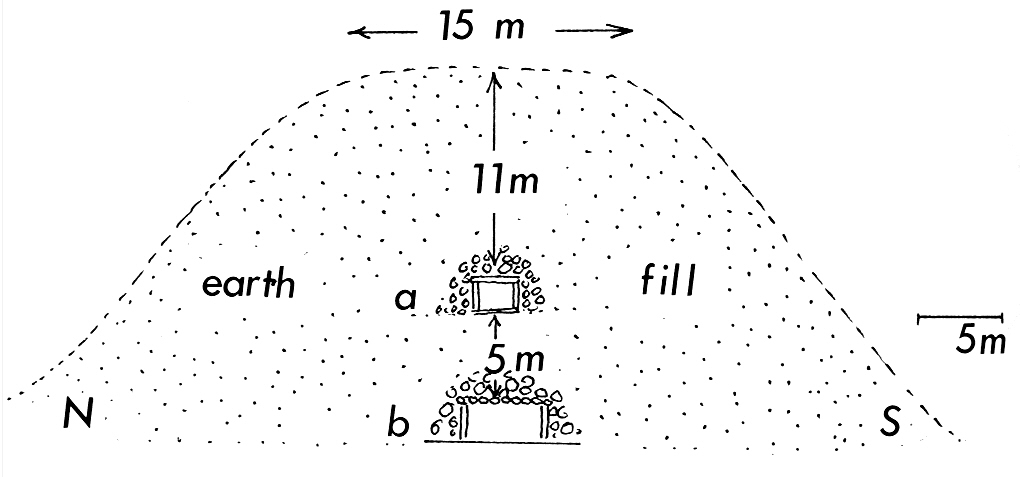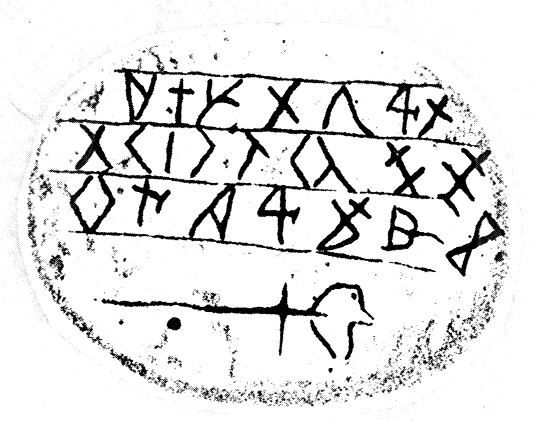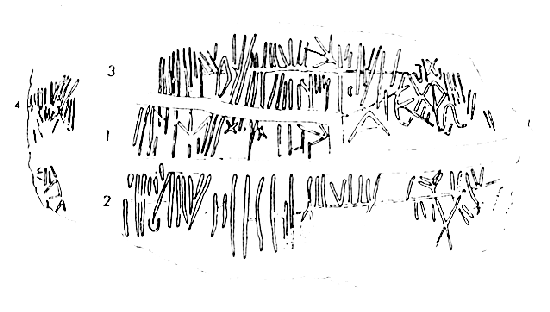File: <archaic.htm> Subjects Archeology
Index <Pre-Columbian Exploration>
ARCHAIC MIGRATIONS TO NORTH AMERICA
A Summary of Salient Events
----Please CLICK on underlined categories and pictures for detail [to
search for Subject Matter, depress Ctrl/F ]:
|
Puratoire River Valley,
Colorado |
Canada-Ogam Script &
Nordic Scripts |
|
For many years it was postulated that the
earliest cultural ‘insurgents’ were paleo-indigenous people in North America,
with an origin in Siberia ( possibly from the Ket region ). Since the discovery of Clovis points
there has been a radical change in how we
consider who were the earliest incumbents of non-indigenous origin.
With so much lithic evidence discovered in both Canada and in the United
States we can now see how a East to West migration during the European
interstadial Glacial Age has given rise to proof of an original European
based earlier culture than that of earlier suppossed Beringian origins of the
Clovis Hunters. Clovis Points All over the Americas, and especially in the
North is evidence of early explorers searching for additional sources of
copper at the end of the Bronze Age. In
recent years paleography has revealed traces of this European based culture
This has put a new light upon the origin of the Clovis points. It is now conclusive that the Clovis
ponts , the most advanced projectiles ever produced in America, originated in
southwestern Europe (France, Portugal and in Spain) Migrations to America appear to have
begun at least 13,000 years ago when the North Atlantic had a bridge of
glaciers. Within the interstadial periods the climate was such as to afford a
pathway westward to the Americas. In recent years new light has been
shed on these early Europeans by
lithic evidence they left us of Ogam inscriptions, further, the
inscriptions indicate that they spoke in a language that is akin to Old Norse
The Clovis people by Archaeologists'
most precise determinations at present suggest that this radiocarbon age
(11,500 RCYBP (radiocarbon years before present) or is equal to roughly 13,500 to 13,000 calendar years ago. It has also been argued that Clovis
ended in a very abrupt fashion.Whether the Clovis culture drove the mammoth,
and other species, to extinction via overhunting – the so-called Pleistocene
overkill hypothesis – is still an open, and controversial, question. Another
possibility is that climate change coupled with human predation, disease, and
additional pressures from newly arrived herbivores (competition) and
carnivores (predation) and isolation made it impossible for many species to
reproduce and survive. Another factor has been hypothesized
that the Clovis culture saw its
decline in the wake of the Younger Dryas cold phase. This 'cold shock',
lasting roughly 1,500 years, affected many parts of the world, including
North America. It appears to have been triggered by a vast meltwater lake –
Lake Agassiz – emptying into the North Atlantic, disrupting the thermohaline
circulation. The
Clovis tool complex was excavated between 1932 and 1937 in New Mexico, by a crew under the direction
of Edgar Billings Howard from the Philadelphia Academy of Natural
Sciences/University of Pennsylvania. Howard's crew left their excavation in
Burnet Cave, New Mexico (truly the
first professionally excavated Clovis site in August, 1932 and visited
Whiteman and his Blackwater Draw site. In November, Howard was back at
Blackwater Draw to investigate additional finds from a construction project. SOURCES
The American Journal of Archaeology (January-March, 1932 V36 #1, E.
B. Howard in Burnet Cave, the discovery of a "Folsom type"
below a Basketmaker burial.
Brief mention of the Clovis point found in place predates any work at
Dent, Colorado. First report from at
the Blackwater Draw Clovis site,
November 25, 1932 Science News Refers
to an earlier article on
Burnet Cave in the University Museum
Bulletin of November, 1931. Note [1] The Dent Site, in Weld County,
Colorado, was simply a fossil mammoth excavation in 1932. The first Dent Clovis point was found November
5, 1932 and the in situ point was found July 7, 1933. The in situ Clovis
point from Burnet Cave was excavated in late August, 1931 and reported early
in 1932. E. B. Howard brought the Burnet Cave point to the 3rd Pecos
Conference, September 1931 and showed it around to several archaeologists. From recent discoveries, a Solutrean hypothesis was
proposed by Smithsonian
archaeologist Dennis Stanford in 1999 ( also
Stanford and Bradley 2002) suggesting that the Clovis techology appears to
have an origin in southern Europe 21,000-15,000 years ago this was the period
of the first Stone Age and of art work in southern France. The European link to Clovis is
evident from the similarity in
technology between the projectile points of the Solutreans and those of Clovis people. The model envisions these
people making the crossing in small watercraft via the edge of the pack ice
in the North Atlantic Ocean that then extended to the Atlantic coast of
France, using skills similar to those of the modern Inuit people. Supporters
of this hypothesis suggest that stone tools found at Cactus Hill (an early
American site in Virginia), are knapped in a style between Clovis and
Solutrean. Other scholars such as Emerson F.
Greenman and Remy Cottevieille-Giraudet have also suggested a Northern Atlantic point of entry,
citing toolmaking similarities between Clovis and Solutrean-era artifacts. New evidence in the last 4-5 years has demonstrated
that the Laurentide Ice-Sheet has been the only continental glacier to reach
N.W. Canada and this happened during the Late Pleistocene (30 ka). A site in the Smoking Hills (near the
Arctic Coast) in the N.W.T. has yielded multiple tills with lithologies of
local origin with the exception of the upper lag containing granites from the
Canadian Shield (Duk-Rodkin et al., 1010). This further indicates that there
was only one continental glacier that reached N.W. Canada. As well, several C14
ages obtained from southern Mackenzie Mountains indicate that the Laurentide
ice was present close to 9000 y B.P. just south of Keele River latitude. This
coincides with ages obtained for the drainage of glacial Lake Mackenzie in
the same area ca. 9ka. No archaeological sites have been found
in the Mackenzie Mountains or in its foothills except Holocene. In my mapping
research in the area between Nahanni and Keele rivers near their confluence
with the Mackenzie River a petroglyph was found on the flood plain of the
Mackenzie River (see below). This petroglyph was carved in a quartzite
boulder. Canadian Arctic Coast Petroglyph Sources: *Aa-5, 2010. Duk-Rodkin
A., Barendregt R.W., and White J. An extensive Terrestrial record of multiple
glaciations preserved in the Tintina Trench of west-central Yukon: stratigraphy,
paleomagnetism, paleosols and pollen. Canadian Journal of Earth Sciences
(July 2010). 2004. Barendregt
R.W. and Alejandra Duk-Rodkin. Chronology and
extent of Late Cenozoic ice sheets in North America: A magnetostratigraphic
assessment. In Quaternary Glaciations - Extent and Chronology, Part
II: North America, Editors J. Ehlers and P.L.Gibbard. Developments in
Quaternary Science 2 series editor: Jim Rose. 1996. Duk-Rodkin
A., Barendregt R.W. Tarnocai C. and Phillips F.M. Late Tertiary to late Quaternary record in the Mackenzie
Mountains, Northwest Territories, Canada: stratigraphy, paleosols,
paleomagnetism, and chlorine-36. Canadian Journal of Earth Sciences vol 33:
875-895. SEMETIC VISITORS - New Mexico c. 700 BCE Los Lunas
Inscriptions, New Mexico
The above inscription is very unique for
several reasons. First, it is written
in an ancient Hebrew script. Second it is located near the small town of
Los Lunas in the State of New Mexico, USA. Third, the inscription is of the
"Ten Commandments".
Is this inscription is original this proves
that a Semitic people, probably Hebrews, arrived in the Americas long before Columbus or the Vikings. in
Newfoundland.
The above inscription cannot be a fake for the
following reasons. The actual time of discovery of the inscription is not known
but was known by the locals as far back as the 1850's. At that time, the
script of the text was unknown and therefore undecipherable. It was not until the last century that the ancient Hebrew (Paleo-Hebrew)
script was discovered in the Near East.Once this
ancient script was discovered the Los Lunas inscription could be deciphered
and was found to be a copy of the "Ten Commandments". It was an
undisturbed site. In 1925 a prospector in the area came upon the stone and
mentioned it appeared extremely old and at that time it was covered in lichen
and moss The Los Lunas Hebrew Inscription - Middle Semitic Script
Source: Ancient Hebrew Research Center Jeff
A. Benner
The Sumerians [Shem] were in the Americas almost from the very
beginning of colonization there There
is a translation of the cuneiform in a section of the Fuente Magna [a votive
clay water trough]. "The translation is: ‘The L-rd of Serenity with the
light gathers and herds together the large animals and the goats and the kids
(weakened by lack of fodder, or wandering in search of food) to the open
fields for rest.’ (In this context, "rest" appears to mean
slaughter, for sacrifice or butchery, and to convert their hides to leather
for apparel)." "Inference: The central idea of all the
scripts of the Fuente Magna is apparently didactic. It seems that Sumerians,
or a person or people employing Sumerian script, wished to serve as a guide
to the people of the Altiplano to teach them new skills (how to herd goats
and guanaco, to tan and manufacture leather, and so forth), to become their
spiritual leaders, themselves adopting the role of teachers and priests. If
this interpretation is correct, then it would seem that Sumerians were the
first rulers and religious leaders of an American people.
.
"In this context it is relevant to recall that the Inca Garcilaso
de la Vega tells us that the first Inca, Manco Capac, and his spouse, Mama
Oello Huaco, instructed the aboriginal people over whom they held sway the
arts of cultivating grain and how to tame and domesticate wild animals. This
program of instruction was initiated, so Inca Garcilaso declares, as soon as
the first Inca entered his South American domain."
The Sumerian influence and colonization of the areas of Central
America must be explored too. The Maya-Olmec Long Count Calendar in Central
America began on August 31, 3114 BCE. Its accuracy reflects knowledge of
years, seasons, and events that only a people like the ancient Sumerians
could possess. The similarity of Mexican, Colombian, and Egyptian pyramids is
interesting . The royal tomb of the Mexican pyramid at Palenque shows the
same basic relationship to the overlying pyramid as occurs in the Egyptian
pyramids, [1]which pyramid-building knowledge was brought to Egypt from
Sumeria. Note [1] The Mastaba of Faraoun, at Saqqara ( a step
pyramid)
In Genesis 11:4, we find that the expression, "a city and a
tower, whose top may reach unto heaven," can refer to a tower with an
idolatrous "temple for heaven" on its top. The Temple of Kukulcan,
known as El Castillo, "The Castle," which looks almost identical to
some of the pyramids of Sumeria, is just one of many that fits this
description quite well. The origin of
maize is intriguing.
Walter Baucom has indicated that researcher Michael Coe has studied
this grain and remarked that it has no
wild form. Speculation as to its origins places it in New Mexico about
2500 BCE. It is not known if the wild teosinte plant became maize [the source
of all corn] from a single mutation or if maize became teosinte the same way.
With all the agricultural firsts of the Sumerians, especially of their
hybridization of wheat in the Tigris-Euphrates area, and added to this their
far reaching trading proclivities, it would not be unrealistic to consider
the possibilty that they would introduce through trading this valuable food
source into the America’s which would have been a major agricultural
innovations, though this remains to be proven.
Coe stated that although no wild maize appeared in Mexico until the
Early Preclassic period (1800 — 1200 BCE), tiny popcorn with pod corn
characteristics has been found there showing an age of 3000 to 2200 BCE. This
early date fits the time of Sumerian expansion and diffusion to other
continents.
Another writer gives a further
hint of Sumerian influence. I learned from 22 expeditions to the Cuna
Indians, on the offshore San Blas Islands of Eastern Panama, that this tribe
has a Turning Tree of Life religion similar to that of ancient Sumeria 3400
BCE. Like Ishtar, the Cuna Earthmother bears in her womb a Tree of Life on
which grow plants, animals, and man. It also bears the Golden Apples of
Immortality. One must obtain permission from the Cuna Earthmother to pick the
apples. The Tree is guarded by a dog, corresponding to Cerberus, that must be
appeased before the Golden Apples (Olo Wini) can be picked.
As in Sumeria, Ishtar had to carry a leafy
branch from the Tree of Life (the Golden Bough) in order to be able to return
to the surface of the earth, so the Cuna High Priest (Kantule) must break off
for protection a golden branch so freshly developed that it has no
chlorophyll (‘so freshly developed, say the Cunas, that no bird has yet sat
upon it’). [The Babylonians inherited the Sumerians’ civilization and
injected their pagan religion into it.]
"But did the ancient Sumerians really ever get to America? Sargon
of Agade, his son Menes, and his grandson Naram Sin all wrote on clay tablets
that they had sailed to the Sunset Land, and there founded colonies. The
Fuente Magna [1] was found near the
Bolivian shore of Lake Titicaca, bearing an invocation to the gods in ancient
Sumerian. "The Cunas originally lived in Columbia that borders on Peru.
Evidence also comes from 74 words of native Peruvian that have identical or
similar sounds and meanings with words in Sumerian. A list of 42 cultural
identities or similarities in culture have been described for Peruvian and
Sumerian.
"Tracing Cuna relgious symbols such as the placental spirit
guardian dog, the itinerary of the Soul Boat, the labyrinth of the
Underworld, the Amniotic Water of Life, the small Tree of Life symbol, the
swastika, and the snake-entwined medicine cane, lead back to Sumeria, Troy,
Knossus, Egypt, and Mohenjo Daro."
Many coins found in North America and South America show pre-Columbian
visitations by many peoples. "But vastly more impressive than even the
numismatic evidence is that which has begun to accumulate in the epigraphic
field. For whereas our sporadic coin finds inferred the pre-Columbian
presence of Phoenicians and Hebrews, inscriptions have already added Berbers,
Arabs, Basques, Celts, Scandinavians, Hindus, and, most recently, Sumerians. Tesla mentioned other discoveries that
would indicate Sumerian influence or settlement in Central and South America.
"Fell’s researches have proved beyond doubt that Old World cultural
diffusion is not merely a side-issue in Native American studies, but a
relentless and ubiquitous phenomenon. The discovery at Huace Prieta of cotton
hybridized from the Old World variety would push back its beginnings at least
to 2,900 BCE (rectified carbon-14 date), and from this it is not much of a
jump to the first, tentative shoots of civilization (3,300-3,200 BCE) in
Colombia and Ecuador." Dr. Barry Fell was recognizably the
world’s foremost epigrapher before his death.
Note [1] The Fuente Magna, also known as the Fuente Bowl, is a large stone vessel,
resembling a libation bowl. It is asserted to have been found in the 1950s by
a worker from the CHUA Hacienda near Tiwanaku, west of La Paz, Bolivia. The
inscription has been claimed to contain Sumerian writing, and is said to
resemble that on the later found Pokotia Monolith.It resides in a small
museum in Calle Jaén, La Paz, Bolivia; Museo de metales preciosos
"Museo de Oro Sumerians in Central and
South America? The Sumerians settled or influenced many early
cultures all over the earth, their earliest probably being India
[Mohenjo-Daro] and Egypt. "However, it is from the 26th century
BCE that our archaeological picture really becomes interesting. The epicenter
of this civilizing earthquake is along the central and North central coast of
Peru. Among archaeologists it is
called simply Pre-Ceramic 6, with an originating date (by rectified
carbon-14 dating) of about 2,500 BCE. For us, its significance lies not in
the label, but in the suddenness of its spectacular developments, and their
obvious parallels with contemporaneous civilization in the Near East.
Civilizations, when they are not imported,
proceed by formative, developmental, and classical stages. Thus, the absence
of earlier stages preparing the way for the stunning achievements of
Pre-Ceramic 6 is in itself quite extraordinary. (Not only that, but) in the
temple of Kotosh, the natural order of things is actually reversed: we not
only lack earlier stages, but find a technological regression with the
additions of subsequent centuries. "Besides building temples, the people
of Pre-Ceramic-6 raised numerous step pyramids and undertook monumental
earthworks.
At Ceulebras, they terraced an entire hillside and fitted it with
stone block facings. And all this has been confidently attributed to a simple
fishing community which had no prior training in architecture and even
preferred to use old gourd vessels rather than make pots of its own."
Note that 2,500 BCE is right after the Flood. Shem-ites [Sumerians]
Japheth-ites, and Ham-ites, including Nimrod’s empire, spread out to
different parts of the earth. Who, then, were these first people? Maybe these
were early Hamites or Japhethites who had migrated there before Nimrod began his
[world] kingdom.
Whenever we read that later peoples brought instant higher civilizing
influences with them and often became ruling classes, could not these just as
likely have been Sumerians sent by Shem to neutralize the pagan religious
influences on these people? Living near Shem and the great Sumerian
civilization, these Hamite and Japhethite peoples could have copied the
advanced cultural, astronomical, navigational skills of the Sumerians, but
added their own heathen religion to them. Shem, who chased down and killed
Nimrod, the arch rebel against the Almighty, could have sent his people to
these indoctrinated peoples to re-educate them to the truth of the Creator.
Do we have any proof of this? Tesla continues. "Poma de Avala, a 16th century native
historian (of Peru), credited the founding of Peruvian civilization to
bearded Caucasian instructors from across the sea, and Sarmiento, in his Historia
Indica, quotes a Quipo historian as dating this event at 3,519 years
prior to the onset of the Incan age. Archaeologists date the onset of the
Incan Empire from about 1,200 CE, but native tradition reckons it at
somewhere between 550 and 750 CE. Now if we use the mean date of 650 CE, we
would backdate the arrival of Old World culture-bearers to 2,869 BCE, just
about the time when Old World cotton makes its appearance in Peru.
"The people at this time were still ignorant and uncivilized.
They dressed in leaves and straw, and lived in caves and among the rocks. The
Ayar brothers founded the Pir-huan dynasty. They taught the people
agriculture and the building of houses.
"Traditions also speak of a controversy between Vira Cocha, the
(Egyptian?) [more likely Sumerian] founding father, and his flock, on the subject
of sacrifices. ‘Vira Cocha…(quoting Poma de Avala) his skin was white, the
color of foam, or like pale gold.
He was a bearded man…and wore a robe down to his feet, and a mantle.
He taught a doctrine of love. Seeing a human sacrifice to an idol shaped like
a woman on a hill, he threw down the idol and destroyed the hill. Vira Cocha
found a loyal disciple in a chief named Apo Tampo, and through him he taught
husbandry and left a gold scepter inscribed with seven laws. But the majority
of the people would not listen and so he returned across the sea whence he
had come.’ "…to which Poma de Avala adds: ‘The people of the first age
(i.e., the first period of Peruvian civilization) were born of white men from
overseas and native Indian women." Berlitz says, "In the vicinity of
the village of Ocucaje and Ica, in Peru, a collection of rounded stones
totaling perhaps 16,000 and weighing from five pounds up to huge boulders of
800 pounds, has been amassed by Dr. Javier Cabrera, who has about 11,000 of
them in his museum. What is unusual about these ‘stones of Ica’ is that they
are covered with incised drawings ostensibly made by carvers of past
civilizations.
The engraved drawings show people, extant and extinct animals, star
maps, the star rings of the zodiac, and maps of unidentified land areas.
People are shown using telescopes,
looking at the stars, and performing surgery." No date is given for
the above paragraph, but early Spanish reports tell that some of these stones
were sent back to Spain by Spanish explorers in 1562, proof that they are not
of recent age.
What are we to make of all this, especially as pertaining to the
Sumerians? To speculate, some backward and "heathen" people were
settled in Peru almost immediately after the Flood in approximately 2400 BCE.
This would conform to the above dates if indeed the archaeologists’ dating
method rather than the native tradition were accurate. The native date of
3,519 years before the onset of the Incan age [1200 CE according to
archaeologists] would be about 2,319 BCE, a date which also squares with the
supposed date of the Flood
Since it was Shem through whom YHWH gave His laws and Covenants, we
can suppose that Hamites and Japhethites were the original and very backward
peoples that inhabited that area. The Vira Cocha person who brought the
doctrine of love, and who did away with human sacrifice [a very heathen
thing], would strongly appear to be a Shemite [Sumerian]. This supposition
would agree with our understanding of the very advanced civilization the
Sumerians brought with them to many parts of the earth.
Dankenbring, quoting from the same source (Berlitz, ), mentions that a
Danish storekeeper, Waldemar Jusrud, in 1925, found and amassed 33,000
ceramic figurine objects near Acambaro in the Mexican state of Guanajuato,
with human figures and [dinosaur-like reptiles and] animals on them.
"The human figures show details of dress somewhat resembling those of
the ancient Middle East: laced sandals, chain mail, shields, and a variety of
weapons.
"Let us now push forward a thousand years. This will take us to
the 15th century BCE, a time of major geological disturbances that submerged
islands and clipped the edges of larger land masses all the way from the Peloponnesus
to India. By the end of the 13th century BCE, Cretan power was irrevocably
broken, leaving the way clear for the Phoenicians to reopen their trade with
Western Europe…and beyond. One can well imagine the excitement of these
merchant seamen, whose traditions extended not merely to Cadiz, but, as
perhaps they alone knew, to the great and almost forgotten continent beyond
the Sargasso Sea."
Our contention is that Phoenicians were mostly Israelites who
inherited the colonizing and civilizing proclivities of their forebears, the
Sumerians. Hundreds of Phoenician inscriptions have been found cut in stone
tablets along the banks of rivers in the jungles of Brazil and on the eastern
coast of South America, and even more hundreds have been found in North
America.
The Phoenician influence seems especially evident among the Maya. The
Maya alone of all native peoples of the New World were fully literate. Their
script was so well-developed that they could write down anything in their
language. The early art of the Olmecs, beautiful in its utter simplicity, is
called Danzantes [literally "dancers"], although we make no
claim of kinship of that word to the Tribe of Dan.
This art might be associated with the oldest writing in Mesoamerica.
At least one Danzantes Olmec bas-relief is bearded, bearded men being both a
Sumerian and an Israelite proclivity. Much Sumerian knowledge was passed down
through Abraham to the Israelite Tribes. Sumerians also used the concept of
zero, as did the ancient Hindus and Mayas, and were able to make mathematical
cosmic calculations of fifteen digits, while younger races had difficulty
counting in the thousands.
In some cases, the Sumerians themselves were the first to settle an area.
Just as Nimrod developed warfare and conquered some early Sumerian cities in
Mesopotamia, so too can we assume that he sent soldiers to conquer some
[already established] Sumerian settlements in other areas of the world.
The Sumerians’ influence on the world was seen in the chapter,
"Sumerians: Who Were They?" but this brief glimpse of their
influence on other civilizations [or lesser tribes] will give us greater
understanding of who they really were, what particular knowledge they gave
us, and where this knowledge is today.
Some of these people undoubtedly were assimilated into the Akkadian,
Chaldean, Babylonian, Assyrian, even Egyptian, peoples. Some might have
assimilated on a smaller scale into the Medes and Persians. The greater majority
of them, however, can be traced in the Abrahamic lineage given in the Hebrew
Scriptures.
Some of these ultimately became the children of Isaac–Esau and Jacob.
Jacob became the father of the Israelites, and it was through one of his
sons, Joseph, that this knowledge continued to be passed down, and to whom
the Birthright promises were given.
"When the
Spaniards came to Mexico and were standing guard on cold nights, they began
to wonder who these Indians really were. Some of those soldiers (Bernal Diaz
among them) advanced the idea that these Indians might be Jews."Among
the Spaniards, the Estemadorans in particular had been raised on Roman history
and they knew about the reigns of the Roman emperors Vespasian and his son
Titus. Both Vespasian and Titus had been governors of Judea and, after
suppressing the Jewish rebellion around 70 CE, they sent whole tribes of Jews
into exile.
The Spaniards…wondered if perhaps these Indians were not descended
from those ancient Jews who were exiled from Palestine more than fourteen
hundred years before. But how, they asked themselves, would the Jews have got
here? Well, the Jews knew how to build ships and it would have been possible
to sail across the Mediterranean, through the Strait of Gibraltar, then cross
the ocean, wouldn’t it? Furthermore, several of the Spaniards came up with an
odd fact to support this theory: Indian priests in Zempoala had shown them
how the obsidian knives–the sacrificial knives–were also used for
circumcision, which was known to be a Jewish rite. Ergo, these Indians might
be Jews. [Dr. Fell traced many of these fleeing Jews to present-day
Tennessee.]
"Antonio de Montezinos, a Marano (secret Jew), while journeying
in South America in 1641, (had an) Indian guide (who) greeted him with, ‘Shema Israel (Hear, O Israel).’
Furthermore, the guide reported that many people ‘of the same origin’ were
living in the highlands near Quito, Ecuador. He also claimed that he met
savages who followed Jewish practices. This story Antonio repeated in Holland
in 1644 to Manasseh ben Israel, who printed it in his work, Hope of Israel,
in 1650.
"Early in the 19th Century, a young member of Parliament, Edward
King, Viscount Kingsborough, was struck by the beauty and mystery of a
Mexican Indian codex, or manuscript, in the Bodleian Library (that arrived)
at Oxford. He exhausted his fortune, and perhaps his life, in attempting to
prove that the Lost Tribes of Israel were ancestors of the Indians of Mexico.
Nearly half of Adair’s book was reprinted by the passionately convinced
Kingsborough.
He sank the bulk of his fortune into the publication of nine
magnificent volumes of Mexican codices, with commentary, entitled Antiquities
of Mexico. Twice he was thrown into debtors’ prison when he was unable to
meet the bills of the printers and paper manufacturers; on his release he
doggedly continued his publishing efforts. In 1837, imprisoned a third time,
he died at the age of 42. His friends insisted that the cause of death was a
broken spirit." "Teoamoxtli, ‘the devine book,’ as it
was called. According to Ixtlilxochitl, it was composed by a Texcucan doctor,
named Huematzin, towards the close of the seventh century. It gave an account
of the migrations of his nation from Asia, of the various stations on their
journey, and of their social and religious institutions, their science, arts,
etc., a good deal too much for one book. Ignotum pro magnifico.
It
has never been seen by a European. A copy is said to have been in possession
of the Texcucan chroniclers, on the taking of their capital. (Bustamante, Cronica Mexicana,
[Mexico, 1822], Carta 3).
Lord Kingsborough,
who can scent out a Hebrew root, has discovered that the Teoamoxtli
was the Penteteuch. Thus, --teo means ‘divine,’ amotl,
‘paper’ or ‘book,’ and moxtli ‘appears to be Moses,’ —‘Divine Book of
Moses,’ Antiquities of
Mexico, Vol. VI, p. 204, nota [quoting Prescott’s
Mexico, Vol. I, p. 93].
This appears to be associated more with Aztecs than with Maya. The
Nahautl [Uto-Aztecan] language itself has been shown to have many
Hebraic-Semitic roots and can be traced to NW Palestine, where parts of the
Israelite Tribes of Dan, Naphtali, Zebulon, Asher, and Issachar settled. Old World Artifacts in North America
Dr. Hugh Moran, in The Alphabet and the Ancient Calendar Signs,
was convinced that the lunar zodiac served as the basis for the Maya’s Hieroglyphic
writing system. In the chapter on Sumerians, we saw that the calendar of the
Israelites was lunar based.
Ancient tribal traditions of Amerindians in the United States taught
that their ancestors crossed the great ocean to the east of America to reach
this continent. Their children were later bewildered and confused by the
conflict between tribal traditions and what they were being taught in school,
the much more recent belief of an alleged ancestry stretching back across the
Bering Strait to Asia.
In recent years, multiple thousands of Old World artifacts have been
found, such as Roman pottery, ancient Welsh armor, Viking axes and swords,
and Phoenician, Greek, and Roman coins. Celtic Ogam, Norse Runic, Libyan
Berber Tifinag, and Greek, Hebrew, and ancient Basque petroglyph writings are
continuing to be found all over North America.
What archeologists in our West call "Great Basin
Curvilinear" is in fact writing–ancient Punic, Greek, and Libyan Arabic
of North Africa–using alphabets that are proper to those tongues.
Interestingly, "…the ancient San Telmo Stone of Portugal, believed to
have the oldest form of Basque writing on it, was unreadable until Dr. Barry
Fell deciphered it, using the Cree Indian alphabet of North America."
On the West Coast, Arab petroglyphs are numerous in California,
Nevada, and Southern Idaho. Numismatists, serologists, historians, and
epigraphers are redefining our past. The same giant dolmens, cairns, and menhirs
found in Europe, the Middle East, and North Africa have now been discovered
in America. Skull types across the continent show mostly the European types
east of the Rocky Mountains, with the rounded Asiatic types found west of
them. Blood types [serology] reveal an almost totally nonexistent Asiatic
type north of Central and South America. Columbus, it appears, was the last
person to discover America, and our Western histories, written from a very
Romish point of view, might have to be totally revised.
The big question is just who were these Celtic, Scandinavian, North
African, and Phoenician settlers to America a thousand years before Jesus and
two and a half millennia before Columbus? The English language itself can be
traced through the Celtic and Scandinavian peoples of Europe, back through
the Scythians, Cimmerians, Carthaginian-Phoenicians, all the way back to
ancient Israel..
Geoffrey Keating (1570-1646), who wrote The History of Ireland from
the Earliest Period to the English Invasion, and translated by John O’Mahony,
New York, 1866, says,
"This language the Latin writers call the ‘Lingua Humana,’ i.e.
the Human Language. But when Nimrud, with his kindred, was attempting to
erect the Tower, their language was confounded, in order to prevent their
finishing the structure which their pride had prompted them to begin; and the
original language, received from Adam, was taken from all that were concerned
in building it. It was, however, retained by Heber, the son of Selah, and by
his tribe, and, from him, it has been called Hebrew." Source: Walter Baucom
The remains of one of the oldest North
Americans ever found have been recovered in Washington state. The 9,300-year old skeleton is 90%
complete and belongs to a Caucasian male
about five foot ten inches tall. Described as one of the most complete
skeletons ever unearthed in the Americas it was discovered near Kennewick,
Washington in July of 1996 and dubbed "Kennewick Man."
Now it is the subject of a court battle between
anthropologists who desire to learn all they can about it, and the U.S. Army
Corps of Engineers, which wants to cover it up, both literally and
figuratively. The Corps wishes to turn this remarkable find over to American
Indian tribes who want it reburied without further study based on the claim
that the skeleton is an "Indian" and therefore should not be
studied. The Indians had no explanation as to how one of their
"ancestors" could be
Caucasian. At stake at the center of this controversy is the rewriting of
American pre-Columbian history--sooner rather than later.
Including the nearly
ten-thousand-year-old mummy of a Caucasoid male found in Spirit Cave Nevada,
and the skeletal remains of a nine year old Caucasoid female child found in Nevada of equal antiquity.
From their graves, men, women, and children are
speaking to us and their tale is that of an ancient culture stretching at the
least from Arizona to Washington State.
Interestingly enough the Kennewick man had
imbedded in his pelvic bone a two inch Clovis spear point of gray volcanic
rock thrown by an enemy with every intent to kill. Kennewick Man survived the
attack but the spear point remained imbedded in his hip. [1]
What is odd is that there is little proof that
there was not a single Indian in the entire Northwest when Kennewick man
lived, hunted and fought there. The present non-Caucasian Indians in that
region are believed to have been there less than a thousand years, which
makes them the invaders and Kennewick man and his people the "native
Americans" of the Northwest, for whatever that is worth.
Most Americans, taught the Bering Strait
theory as an explanation for the peopling of America, are unaware that it is no longer seen as the sole
explanation for the migrations to this continent. Archeological finds in
South America, on the Eastern Seaboard of the US and elsewhere show
conclusively that there were several distinct and separate migrations of
different racial groups to the Americas.
Furthermore, recent studies point to the
hypothesis of a "North Atlantic Crescent" which existed between
Europe and the Americas, with both water and ice serving as a
"bridge" between the two continents.
Archaeologists such as Thor Heyerdahl and many
others have uncovered the oldest ruins in the Southern Hemisphere of the
American Continent. These ruins present politically correct archeologists
with the problem of the most ancient civilizations being found at the
Southern end of the American continent rather then at the Northern end, where
one would expect to find them had the first settlers come across the Bering
Strait. It is clear also from genetic DNA sequencing of haplotypes that there
was more than one migratory event. Indeed, as one DNA study bluntly stated,
"The notion of a homogeneous Amerind genetic pool does not conform with
these and other results ". Note: [1] He was probably attacked by a fellow
Soulerian Caucasian, in a dispute of some sort
Rather than walking 10,000 miles from Mongolia
to Chile, it now seems that the "first Americans" may have sailed
first class. And where they came from will soon be firmly resolved by DNA testing.
Peru, Chile, and Ecuador are all revealing long forgotten cities of ancient
peoples classified as racially part of the Indo-European family of people.
From Red headed mummies in pre-Inca graves in Peru to blond headed Toltek
warrior priests in central Mexico, this is not the history of your father's
generation.
The myth of "Indians" as the first
Americans, from lithic discoveries in recent years is now apparent. The myth
so long supported resounded throughout the hallowed halls of academia into a
form of politically correct form of archaeology that has greatly hindered the
interpretation and understanding of American pre-history. Source : Louis Beam About 3,000
years ago, the mummified body of Henut Taui was laid to rest in a desert
tomb of ancient Egypt. During her long
sleep, Rome rose and fell, the dark ages came and went, Europeans from
Napoleon to the Brits conquered her home land, and finally in the early
1800s, the immortality her embalmers had sought for her was attained when her
tomb was plundered. Her body, preserved to the consistency of Beef Jerky,
found its way to Germany, a museum in Munich, and during toxicological
testing in the 1990s was found to contain large amounts of Cocaine and
Tobacco , Cocaine and Tobacco are found only in New World plants, and logically
should not have been attained by Ancient Egyptians without contact with
America. Of course, the possibility
of contamination by modern tomb excavators exists. Some possibilities:
There was significant trade between the
Americas and Ancient Egypt to allow Cocaine and Tobacco to find its way into
circulation. Cocaine and Tobacco once grew in the Old World as well, but
later became extinct in these regions. The tissue samples are tainted by
later contact with cocaine users, smokers, and potheads Henut Taui is a
time traveling Crack head.
Dr Svelta Balabanova a highly respected
forensic toxologist and the inventor of several highly sensitive drug
specific tests which are today's standards in establishing drug use, took
samples from several mummies, including Egyptian Pharaoh Ramses the Great.
Not only was the presence of Cocaine and Tobacco established, but Cannabis as
well. Apparently pot and cocaine use was fairly common among the Egyptian
elite of antiquity.
Dr Michele Lescott from the Museum of Natural
History in Paris, among others has duplicated the Balabanova test results .It
has long been known that the Egyptians used a variety of drugs, this is not
in question. However, the presence of the Cocaine and Tobacco in the bodies
of these ancient Egyptians establishes a link between Old World and New, many
Centuries before the accepted conservative dating that establishment scholars
propose. PHOENICIANS IN ANCIENT AMERICA The Parahyba Inscription We are sons of
Canaan from Sidon, the city of the king. Commerce has cast us on this distant
shore, a land of mountains. We set [sacrificed] a youth for the exalted gods
and goddesses in the nineteenth year of Hiram, our mighty king. We embarked
from Ezion-Geber into the Red Sea and voyaged with ten ships. We were at sea
together for two years around the land belonging to Ham [Africa] but were
separated by a storm [lit. 'from the hand of Baal'], and we were no longer
with our companions. So we have come here, twelve men and three women, on a
shore, which I, the Admiral, control. But auspiciously may the gods or
goddesses favor us! DNA ANALYSIS OF
NATIVE AMERICANS
Dr. Wallace began studying the mtDNA of Native
Americans in the mid-1980s in hopes of resolving a long-raging debate over
when prehistoric peoples entered the Americas. The presumption long has been
that the ancestors of Native Americans came from Siberia. But anthropologists
have argued for year over how many, and when such migrations occurred.
In December 1989, it was reported that an
American explorer in Peru's highland jungles had found evidence that
indicated king Solomon's legendary gold mines may have been in that region.
The explorer, Gene Savoy, declared that he had found three stone tablets
containing the first writing found from the ancient civilizations of the
Andes. The inscriptions, he reported, are similar to Phoenician and Hebrew
hieroglyphs! Reports the San
Francisco Chronicle: "The hieroglyphs on the tablets are similar to
those used in King Solomon's time and include one identical to the symbol
that always appeared on the ships he sent to the legendary land of Ophir,
which the Bible described as the source of his gold, Savoy said"
Savoy is no newcomer to archaeological
discoveries. He was the discoverer of the last Inca city of Vilcabamba in
1964. Savoy declared that the three tablets each weigh several tons and
measure about 5 by 10 feet. They were found in a cave near Gran Vilaya, the
immense ruins of the Chachapoyas Indian civilization that he discovered in
1985.
Savoy said he found three tablets, each weighing several tons and
measuring about 5 by 10 feet, in August in a cave near Gran Vilaya, the
immense ruins of the Chachapoyas Indian civilization he discovered in 1985.
The Gran Vilaya ruins are 400 miles north of Lima and 9,000 feet above
sea level in a fog-shrouded region of the Andes that Peruvians call the
"jungle's eyebrow." Savoy [1]
displayed photos of the tablets, which he said remain in the cave, and
sketches of rubbings taken from the stones. He pointed out the similarities
between the stylized inscriptions and samples of Phoenician hier-oglyphs.
The hieroglyphs on the tablets are similar to those used in King
Solomon's time and include one identical to the symbol that always appeared
on the ships he sent to the legendary land of Ophir, which the Bible
described as the source of his gold, Savoy said. Note: [1] Deseret News, Dec. 10, 1989
Dr. Joseph Mahan in Atlanta, Georgia, an expert
in ancient Indian ethnology of the southeastern Indians of the United
States.noted that Indian legends, of the Yuchis, state that they migrated to
the area of Florida and Georgia from the region of the Bahamas. According to
their legends, the island sank beneath the sea and they fled for their live
Later the Yuchis , migrated to the
Oklahoma territory, where they eventually settled .
The Yuchis have a custom that is unique among
the American Indians. They are racially and linguistically different from
their neighbors. Every year on the fifteenth day of the sacred month of
harvest, in the fall, they make a pilgrimage. For eight days they live in
"booths" with roofs open to the sky, covered with branches and
leaves and foliage. During this festival, they dance around the sacred fire,
and called upon the name of God.
The ancient Israelites had the virtually
identical custom, in many respects. In the harvest season in the fall, on the
15th day of the sacred month of harvest (the seventh month), they celebrate
the "festival of booths" for eight days. During this time they
lived in temporary booths, covered with branches, leaves, fronds. This
festival goes back to the time of Moses and the Exodus from ancient Egypt
(Leviticus 23). It is intriguingly fascinating that two totally separated
peoples could observe the same custom.
Dr. Cyrus Gordon, of Brandeis University in
Boston, indicated that he was privileged to sit in on one of the fall harvest
festivals of the Yuchi Indians, and listened to their chants, songs, and
sacred ceremonies. An expert in Hebrew, Minoan, and many Middle Eastern
languages, he was incredulous. As he listened, he exclaimed to his companion,
"They are speaking the Hebrew names for God!" Some Mysteries More and
more, scholars are coming to admit that peoples from the Middle East reached
the New World long before Columbus or the Vikings. One stone, found at Fort
Benning, Georgia, has unusual markings all over it. Professor Stanislav
Segert, professor of Semitic languages at the University of Prague, has
identified the markings on the stone as a script of the second millennium before the Messiah, from the Minoan
civilization on the island of Crete! Minoan
inscriptions in New England Dr. Cyrus
Gordon indicated that Jews were in America in ancient times. The inscription
on the stone, he asserts, is in the writing style of Canaan, the promised
land of the Hebrews. Concludes Gordon, whom I interviewed at his old, New
England style home in the suburbs of Boston: "There is no doubt that
these findings, and others, reflect Bronze Age transatlantic communication
between the Mediterranean and the New World around the middle of the second
millennium B.C." In 1968
Manfred Metcalf was looking for slabs to build a barbeque pit. Several
strange-looking, flat rocks caught his eye; he picked up a large flat piece
of sandstone about nine inches long, brushed it off, and noticed odd markings
on it. Metcalf gave the stone to Dr. Joseph B. Mahan, Jr., Director of
Education and Research at the nearby Columbus Museum of Arts and Crafts at
Columbus, Georgia. Mahan sent a copy of the stone to Cyrus Gordon. Gordon
reported: "After studying the inscription, it was apparent to me that
the affinities of the script were with the Aegean syllabify, whose two best
known forms are Minoan Linear A, and Mycenaean Linear B. Cretan Double-Axe The double-axe in the lower left corner is of course
reminiscent of Minoan civilization. The single
vertical lines remind us of the vertical lines standing each for the numeral
'1' in the Aegean syllabify; while the little circles stand for '100.'" Gordon
concluded:" We therefore have American inscriptional contacts with the
Aegean of the Bronze Age, near the south, west and north shores of the Gulf
of Mexico. This can hardly be accidental; ancient Aegean writing near three
different sectors of the Gulf reflects Bronze Age Trans-Atlantic
communication between the Mediterranean and the New World around the middle
of the second millennium B.C."
Gordon offered the exciting thought, "The
Aegean analogues to Mayan writing, to the Aztec glyphs, and to the Metcalf
Stone, inspire the hope that the deciphered scripts of the Mediterranean may
provide keys for unlocking the forgotten systems of writing in the New World.
A generation capable of landing men on the moon, may also be able to place
pre-Columbian Americas within the framework of world history" (Manuscripts, summer of 1969).
Further proof that Trans-Atlantic travel and
communication existed in the Bronze Age, in the middle of the second
millennium B.C., during the time of David and Solomon, and before, comes to
us from South America. Phoenicians in Brazil – Paraiba Insciptions
In 1872 a slave belonging of Joaquim Alves de
Costa, found a broken stone tablet in the tropical rain forests of Brazil's
Paraiba state. Baffled by the strange markings on the stone, Costa's son, who
was a draftsman, made a copy of it and sent it to the Brazilian Emperor's
Council of State. The stone came to the attention of Ladislau Netto, director
of the national museum. He was convinced of the inscription's authenticity and
made a crude translation of it. Contemporary scholars scoffed. The very
thought of Phoenicians reaching Brazil thousands of years before Columbus was
viewed with disdain. Few scholars took the stone at all seriously.
In 1966 Dr. Jules Piccus, professor of romance
languages at the University of Massachusetts, bought an old scrapbook at a
rummage sale containing a letter written by Netto in 1874, which contained
his translations of the markings on the stone and a tracing of the original
copy he had received from Costa's son. Intrigued, Dr. Piccus brought the
material to the attention of Cyrus H. Gordon. Dr. Gordon, the head of the
Department of Mediterranean Studies at Brandeis and an expert in ancient
Semitic languages, as well as author of some 13 books, was amazed. He
compared the Paraiba inscription with the latest work on Phoenician writings.
He discovered that it contained nuances and quirks of Phoenician style that
could not have been known to a 19th century forger. The writings had to be
genuine!
Gordon translated the inscription as follows:
"We are Sidonian Canaanites from the city of the Mercantile King. We
were cast up on this distant shore, a land of mountains. We sacrificed a
youth to the celestial gods and goddesses in the nineteenth year of our
mighty King Hiram and embarked from Ezion-geber into the Red Sea. We voyaged
with ten ships and were at sea together for two years around Africa. Then we
were separated by the hand of Baal and were no longer with our companions. So
we have come here, twelve men and three women, into New Shore. Am I, the
Admiral, a man who would flee? Nay! May the celestial gods and goddesses
favor us well!"
Cyrus Gordon believes the king mentioned in the
script can be identified as Hiram III who reigned 553-533 B.C. The
inscription seems to verify an unusual statement found in the Old Testament.
An ancient Biblical chronicler wrote:
"And King Solomon made a navy of ships in
Ezion-geber, which is beside Eloth, on the shore of the Red sea, in the land
of Edom. And Hiram sent in the navy his servants, shipmen that had knowledge
of the sea, with the servants of Solomon. And they came to Ophir, and fetched
from thence gold, four hundred and twenty talents, and brought it to king
Solomon" (I Kings 9:26-28).
In the days of Solomon there was an alliance
between Hiram, the king of Tyre and the Israelites under Solomon. They were not
only allies, but very friendly toward one another (II Chronicles 2:2-12).
Israelites and Phoenicians even worked together to build the Temple of
YEHOVAH God in Jerusalem (vs.13-18). This alliance included shipping
together, although the Phoenicians were known to jealously guard the secrets
of oceanic navigation from other nations. We read in II Chronicles 8,
beginning verse 8:
"Then went Solomon to Ezion-geber and to Eloth, at the sea side in the land
of Edom. And Huram sent him by the hands of his servants ships, and servants
that had knowledge of the sea; and they went with the servants of Solomon to
Ophir, and took thence four hundred and fifty talents of gold, and brought
them to king Solomon" (v. 17-18).
In the heyday of Solomon silver was "not any thing accounted
of" (11 Chron. 9:20).
We read, "And the king made silver in
Jerusalem as stones, and cedar trees made he as the sycomore trees that are
in the low plains in abundance" (v. 27). Solomon had his own personal
fleets and dominated world trade. "And king Solomon passed all the kings
of the earth in riches and wisdom" (v. 22).
There is archaeological evidence, in fact,
that the fleets of Solomon and Hiram of Tyre circumnavigated the globe,
sailing from Ezion-geber, a port at the terminus of the Red Sea, near modern
Aqaba or Eliat! Hebrew customs, discovered by the early English settlers in
the Americas, were found among some of the Indian tribes, including the
wearing of phylacteries! Minoan and Phoenician coins have been found, and
inscriptions of ancient Phoenician and Minoan scripts, in Tennessee, Alabama,
Georgia, and the Star of David was even found in an ancient ruin of the
Pueblo Indians in New Mexico! In the middle of the second millennium, B.C.,
and down to the time of Solomon, circa 1000 B.C., oceanic travel by maritime
powers in the Middle East seems to have been fairly common. PURATOIRE RIVER VALLEY - Colorado
Another significant Hebrew locale is in the
Purgatoire River Valley, located due south of La Junta, Colorado, where the
oldest written inscriptions in the US are found.
(ca.1750 BCE. conservatively), from the
earliest Ligature phase of word-formation by
‘tying letters together into a picture’. These
have YaH inscriptions identifiable with the Exodus people.
The actual massive rock that appears like a
small ship with cleared keel (maybe what attracted his attention to it), of
the volcanic basalt from the top Tertiary shelf is a remnant of geological
prehistory, which fell two-thirds of the way don the mountain to become what
now has stood ground for 2,500 or more years as a massive "Mezuzah"
(Bible script found at every Jewish doorway). St at a right angle to the left of the main entry before a
natural gateway to this ancient site with Altar having the same writing but
exactly the opposite angle Leftward unto facing the River where it is flowing
in a strait line perfectly perpendicular to it.
Being the largest of only three ’10
Commandments Stones found anywhere in the world. The others being the “Ogio
Decalogue” a much smaller example in a unique type of the post
exile Jewish square script and another
one of the ”Michigan Artifacts” found written in a
Cuneform style of Hebrew graphics!), and therefore most worthy of copy, these
are made utilizing the complete Alphabet, the best example of the print
closest to that writing of the original tablets, as the Paleo is the only
Hebrew having an equal size characters letter set which plotting on both
sides of two tablets according to the accounts would have required.
These re-makes of it, are correct down to the
very angle it sets at, but without the ancient scribe’s mistake
of overlooking a part afterward realized and
inserted with (a diacritical mark ^ ) with the corrected spelling of a couple
of the words and addition of yet a couple more he passed up for an accurate
to Exodus 20 readable abridgement of the full Decalogue. (see Exodus 20 next page) Exodus
Chapter 20 שְׁמוֹת
PALEO-HEBREW INSCRIPTION DISCOVERIES There
are a surprising number instances that appear to
corroborate the fact that Israelites had visited the American continents for thousands of years. Other inscriptions,
also written in Paleo-Hebrew, have been discovered
in the states of Iowa, Ohio,
and Tennessee, as well as in Brazil. In Newark,
Ohio, a carved stone of interesting workmanship was discovered, which also bears
an engraved inscription of the Ten Commandments of the Covenant, written in
Paleo-Hebrew. At a site known as Bat
Creek Cave, Tennessee, an ancient Hebrew inscription was found that mentiones
the Israelite tribe of Judah! Another
fascinating archeological discovery in America is an ancient artifact bearing
an old Hebrew inscription of the Ten Commandments unearthed in Ohio in
1860. The tablet also includes a
scene of an individual - Moses- carved into the front of the tablet in
considerable detail, holding the tablets of the Ten Commandments. This artifact was discovered in an ancient
burial mound.
Examples: The Passover was observed at the
time of the full moon.
Indian legends, including that of the Yuchis, stated
that they had migrated to the area of Florida and Georgia from the region of
the Bahamas. According to their legends, the islands sank beneath the sea and
they fled for their lives. The Yuchis
who migrated to the area of Oklahoma eventually settled there. A custom that they have is unique among
Amerindians and they are racially and linguistically distinct from their
neighbors. Every year on the 15th day
of the sacred month of harvest in autumn they make a pilgrimage. For eight days they live in "boots"
with the roof open to the sky, covered only with branches, leaves and
foliage. During this festival they
dance around a sacred fire and they call upon the name of God. Virtually an identical custom existed
among the ancient Israelites. In the
harvest season of autumn on the 15th day of the sacred month of harvest (7th
month) they celebrated the "festival of booths." This festival dates to the time of Moses
and the Exodus from Egypt (Leviticus 23). Leviticus 23
Dr. Cyrus Gordon of Brandeis
University in Boston was able to view one of these fall harvest festivals of
the Yuchi Indians. He heard their
chants, songs and other ceremonies.
An expert in Hebrew, Minoan and other Mid-Eastern languages, he was
startled and exclaimed to his companion:
he was incredulous.as he listened and exclaimed to his
companion, “My
God! They are speaking the Hebrew names
of God!”
Some
of the best-educated Europeans who first contacted American
Indians in eastern North America noticed that, in the language of many
tribes, there were numerous words that
sounded the same, and had the same
meaning as Hebrew words! Among those
reaching this conclusion were notable early immagrants to North America, such
as William Penn, Roger Williams and Jonathan Edwards. A Key into the
language of America, by Roger
Williams (first published in 1643 in London,
England) Source: Wikipedia-public domain
“They have an exact forme of King, Priest, and Prophet, as was in Israel
typicall of old in the holy land of Canaan, and as the Lord Jesus ordained in
his spirituall Land of Canaan his Church throughout it the whole World: their
Kings or Governours called Sachimauog Kings and Atauskowaug Rulers doe
govern: Their Priests performe and manage their worship: Their wise men and
old men (of which number their Priests are also,) whom they call Taupowaug
they make solemn speeches and Orations, or Lectures to them, concerning
Religion, Peace or Warre and all things. [1] Awaun Nakommit. Who makes a feast? Peeyauntam. He is at Prayer Peeyauntamwock They are praying Cowwewonck The Soule, derived from Cowwene (to sleep) (because they say it
works and operates when the body sleeps) Awaunkeesitteouwincoh Who made you? Ichunckkitonckquean When you die? Anan sowanakitaiiwaw It goes to the South West Pausuck naunt manit, keesittin keesuck &
c. =” One onely God made the Heavens & c.”. Roger Williams observed: “They
believe that the soules of men and women goe to the South-west. “They labour six dayes,
and rest and worship the seventh” “They relate that Kanidntoxowit made one
man and woman of a stone, which disliking, he broke them in pieces, and made another man and woman of a Tree, which
were like the Fountaines (sic) of all mankind. “ Note [1] Regarding Roger Williams explanation of
local indigenous religious customs of a now extinct New England tribe he
observed and recorded in his notes in 1643. Source: “,
, Saarbrucken 2011 HEBREW LANGUAGE –
North and South American Similarities Words that have the
same sounds and meanings in Hebrew as they do in Amerindian languages include
those for wife, man, heavens, prayer, winter and many verbs and phrases. Among the words that were
nearly identical to the Hebrew were Yo-he-wah
[corresponding to Yahweh], and ha-le-lu or ha-le-lu-yah.
Similarly in the mid-1600’s, reports of Hebrew
speaking Indians in South America first came to the attention of Europeans.
As
in North America, not only did the
Europeans discover many strong similarities
between the spoken
languages of the Indians and the Hebrew
language, they also reported seeing inscriptions written in Hebrew, and a
very strong similarity between Indian customs and Israelite practices.
Israelis made
it to America thousands of years before
Europeans because there were sailors from
the tribe of Zebulon and they went all
over the world and left their mark.
They left from the City of Eilat it is recorded in the Old Testament that
Solomon sent his navy all over to bring copper and silver and gold and tin
and minerals like turquoise for the temple he was about to build. Also the name and continent is mentioned
in the Talmud. The Language
Connection
In western Connecticut there are five sites that were visited by two college professors,
after discovery by a high school teacher that were ALL dated to MINIMUALLY
1200 BC, as the Celtic inscriptions carved in STONE were WITHOUT vowels, that
existed only AFTER 1200 BC.
Structures build of massive stone slabs, and used to establish vernal
equinox and summer solstice, were almost exact replicas of those made by the
Celts in Spain, France and Ireland, using ‘corbeled arches’. The finds here
and in NH were summed up in the book the two professors put out about 1968
called ” Americ BC “. Source:
Harold Walker
OGAM INSCRIPTIONS –
Western Connecticut
The writing there was Ogam,[1]
and the symbol for the summer solstice, a circle with a line bisecting it,
indicating ‘half day; half night’ was also seen. Some of the stones dragged over
the top of their structures were estimated to be over 3 1/2 tons. Sadly,
seeds from trees grew in sever openings, and the trees that developed have
actually lifted some of these stones over the centuries. As they had only man
power and no domesticated animals, not even rope/pulleys, it is a mystery as
to how it was accomplished. H.E. Walker
The partial Zodiac with YaH glyph composed of a Sun-Moon eclipse and
aligning of the 5 Planets in Libra as found on the Northmost point of Hidden
Mtn. NM, event has been exacted using 5 astronomical programs for
affirmation, to date to the year 759 B.C.E. late in the day of Teruah. Celtic Ogam History The Celts used Ogam as a form of
secret communication, yet it was also used for divinatory purposes. Examples
of Ogam can still be seen today, carved on stones scattered throughout the
British Isles and the European mainland. Some of the stones are only name
tags referring to great heroes in history or used to mark boundaries, but
some are clearly of more mystical purpose. Ogam itself is a very complex
language capable of many different subtle layers, some of which are lost to
us, through its associations with trees different elements and colours one
word could mean several things and in the hands of a true bard many political
undercurrents could be construed that could crush the mightiest conquerer. The Celts themselves were a fiery
creative people, quick tempered and renowned as fearless warriors. This
stemmed from their religious beliefs which the afterlife was an integral part
of. This belief also had a proficient effect on their culture and most
notably their art. The Celtic mythology and art made a profound impact and
influence through out Europe. Celts still survive to this day their descendants
can now be found in Scotland, Ireland (which has always been the centre of
their world), Wales [2] and parts of Brittany and Spain. Notes: [1] Ogam is the American spelling of Ogham [2] Ogam normally is more prevalent in Ireland.
That a party of Gaelic-speaking Japhethites (who were of lighter
complexion), and Canaanite speaking Hamites (who were dark skinned) made a
joint surveying expedition to the New World soon after this is evident from
the petroglyphs found beside the Arkansas River, on Turkey Mountain near
Tulsa, present day Oklahoma.
There, exactly on the 36th parallel, is found the Canaanite word Pyaa
and above it, the old Celtic word Guin. Both words signified the same
in both languages: "White" or "whites". In other words,
this site was to serve as the boundary marker between the "white"
nations of Japheth to the north, and the darker nations of Ham to the South.
The word Gwyn still means white or fair in Welsh today, who call themselves
Cymru as direct descendants of Gomer. The Ogam inscriptions in America also
share other features of so-called P-Celtic, such as the patronymic 'Mab' (in
lieu of 'Mac'.)
Colonists from present
day Palestine and Syria had settled near the mouth of the Guadalquivir in
southwestern Spain, in what is now Andalusia. The trade was in metals, which
the natives mined. (They were probably the ancestors of the Basques). During
this time the Celts were also pushing into the regions, and had overrun them
by 500 BC. They were relatives of the former colonists,but this fact was not
necessarily realised by them.
A city was built,
called Tartessos, in Greek. The script of their inscriptions,
known as Tartessian, was very close to Phoenician, and Phoenician was so
close to ancient Hebrew as to be almost a dialect. A great many modern names
in Europe are of Phoenician origin, according to Professor Sammes. The very word "Europe" comes from "Ur-appa", meaning "a country of white
complexions".
The Bible tells us
that the ships of Tarshish were the largest in the then known world, and they
became synonymous with the idea of sea power. Coastal vessels were unable to
cope with the sometimes-fierce conditions of the open sea. In Bronze Age
times sailors feared the east wind, in case it should blow them out into the
Mediterranean, so they admired those whose ships were sturdy enough to
venture even further afield to the famous "Tin Islands". Besides the Biblical references to this ancient trade, there
are several classical authorities that mention it.
The merchants of
Tarshish were considered to be very rich, and to have acquired their wealth
by trade with the products of Andalusia, for the Andalusians mined silver.
Spanish archaeologists have studied the remains of the Tartessian culture.
They consider that it was dominant in southern Spain and that it kept the
Celtic culture of the Iron Age from the region for a considerable time. This
means that there are few traces of the La Tene culture compared with the rest of Europe.
Tartessian inscriptions have
been found in America, in New England. The most important was found at
Mount Hope Bay, Bristol, Rhode Island. It depicted a Tartessian ship without
sails, but with a steering oar, and the translation is believed to mean "Mariners of Tarshish this rock proclaims". It cannot be accurately dated, but is
believed to be from about 700 or 600 BC.
Another inscription,
this time in Ogham script has been found at Monhegan Island (off the coast of Maine). There is a flat topped
islet which could have been used for loading and unloading ships. The
inscription is in the ancient Goidelic language (Celtic or Gaelic). Thus it
would appear that trade was extensively carried on in the late Bronze Age to
an extent that only recently is becoming realised. An inscription in
Phoenician has also been found in Brazil.
Correspondence has
been found which was from King Hiram of Tyre (who supplied materials for
Solomon's Temple) to a king of Lavinia, which was Tuscany. The Etruscan
script is decipherable by knowledge of Phoenician, so it would appear that
Etruria was another colony of these Phoenician/Israelitish adventurers.The
document deals with a shipment from Tyre to Italy. Source: “Who were the Phoenicians and Carthaginians?” Valerie Martlew Ships From Phoenicia: Cargo Platform Ida S. Proper began her
history,”Monhegan, The Cradle of New England”, with an interesting survey of
prehistoric voyages to North America that may have visited Monhegan Island
itself and carved the “runes” on Manana Island. She wrote of the legends of
the Phoenicians, Irish, Welsh and Norse visits to the Island, as well as of
Captain John Smith's visit in 1614. Who Made The Inscriptions on Manana? On the small island of Manana is a rocky ledge
with “rune-like” carvings, “discovered" in modern times in the 1850's.
For many years, these inscriptions were cited as definitive evidence of early
Viking contact; however theories and conclusions have changed over the years.
Geologists from the Carnegie Museum declared the "runes" to be
natural erosion and phenomenon. Some archaeologists felt the carvings to be a
form of Celtic Ogham, an ancient Irish script or that it is a petroglyph
carved by Native Americans. Source: The Rope Shed Blog
CANADA - OGAM SCRIPT Peterborough, Ontario, Canada A Royal Visitor
On the basis of evidence gained from translations
of Ogam script in North America, Fell (1982) proposed the following
hypothesis: "Some seventeen
centuries before the time of Christ a Norsemen king named Woden-lithi sailed
across the Atlantic and entered the St. Lawrence River.
He reached the neighborhood of where Toronto
now stands, and established a trading colony with a religious and commercial
center at the place that is now known as Petroglyphs Park, at
Peterborough. His homeland was Norway,
his capital at Ringerike, west of the head of Oslo Fjord. He remained in Canada for five months,
from April to September, trading his cargo of woven material for copper
ingots obtained from the local Algonquians (whom he called Wal, a word cognate with Wales and Welsh and meaning "foreigners.")
He left behind an inscription that records his visits, his religious beliefs, a standard of measures for cloth and
cordage, and an astronomical observatory for determining the Norsemen
calendar year, which began in march, and for determining the dates of the
Yule and pagan Easter festivals.
having provided his colonists with these essentials, he sailed back to
Scandinavia and thereafter disappears into the limbo of unwritten Bronze Age
history. The king's inscription gives
his Scandinavian title only and makes no claim to the discovery of the
Americas nor to conquest of territory. PETROGLYPHS PARK
Peterborough, Ontario, CANADA The area visible
includes the central sighting point of the ain sun-god figure and part
of the east-facing slope. The more
conspicuous markings have been delineated with a black wax crayon applied by
personnel at the site.
Stressed are the larger elements added later by Algonquin artists. Most of the finer Tifinag letters are not marked
by crayon. A detailed plan may be
found in Joan M. & Romas K. Vastokas, 1973, Mansard Press (Fell 1982).
Clearly he was not the first visitor to the
Americas from Europe, for he found that the Ojibwa Algonquians were already
acquainted with the ancient Basque syllabary, and when Woden-lithi set sail
for home, an Ojibwa scribe cut a short comment into the rock at the site,
using the ancient Basque script and a form of Algonquian still comprehensible
today, despite the lapse of time.
Fell (1982) then continued with evidence
supporting such sweeping claims. He
suggested, "The primary physical evidence comprises a series of
inscriptions cut in the Tifinag and ogam consaine alphabets, using an early
form of the Norse tongue, scattered around the outer margins of the petroglyph
site at Peterborough [Ontario, Canada]
Except for the central sun god and
moon-goddess figures and certain astronomical axes cut across the site, the
numerous inscriptions are the work of later Algonquian artists, who used King
Woden-lithi's inscription as a model for their own, more conspicuous,
carvings. The site has been since
1972 under official government protection the Vastoskas team found and
recorded the inscriptions and reported that they must date back to a period
before the historical occupation of the region by the Hurons and later by
Iroquois; in other words, the inscriptions could not be modern features, and
must date back to the era of Algonquian occupation, which came to an en some
five centuries ago.
Joan and Romas Vastoskas recognized apparent
Scandinavian and Bronze Age features in the art style. They pointed out that the ships depicted
in the inscription are shown in the
European manner, with animal figureheads and stern tailpieces, features totally unknown to Algonquian, or
indeed in any American Indian, art.
They, and other archaeologists, noticed the strange similarities of
the central sun-god figure. and associated motifs to corresponding solar
deities of Europe, especially the
Bronze Age petroglyphs of Scandinavia.
Other characteristic Scandinavian features are drawings, which record
such elements of Norsemen mythology as the maiming of the god of war by the
Fenrir wolf.., the conspicuous short-handled hammer, Mjolnir, of Thunor (Thor
of the Norsemen), and Gungnir, the spear of Woden. Both of which were
imitated many times over by the Algonquian artists who later occupied the
site
Thus, the purely objective reports made by the
Vastoskases who sought only to record what they discovered, without attaching
any interpretation other than that appropriate for Algonquian art, have an
added value and importance for us now, for they observed the material as it
was uncovered from the soil and placed it on permanent record in their
photographs, charts, and descriptions.
As a result of the initial discoveries, the whole site was set aside
as a public park and protected by an enclosure.
The actual discovery occurred on May 12, 1954,
by three geologists, Ernest Craig, Charles Phipps, and Everitt Davis, in the
course of fieldwork on mining claims.
The following day, "Nick" Nickels, a photographer-journalist
of the Peterborough Examiner,
visited the site, and so began the first modern records of it.
Paul Sweetman of the University of Toronto
undertook the first research at the site in July 1954, recording nearly a
hundred petroglyphs. Sweetman's
report indicated a possible age as great as 3,500 years or as young as 400
years. His upper limit, 3,500 years,
is in agreement with the epigraphic evidence as given in this book. Thousands of visitors now come to the site
each year, using the access road and other facilities that have been erected
for their benefit, it has become a major center of archaeological interest..
The Vastokases, like most archaeologists in
North America, felt obliged to explain all American petroglyphs as being the
work of native Amerindian artists.
Despite their, and others' perception of the similarities to
Scandinavian petroglyphs of the Bronze Age, the idea that any connection
might have existed between North America and Scandinavia in the Bronze Age,
some 3,500 years ago, seemed preposterous.
So they were faced with remarkable parallels, yet they elected to
explain them as no more than chance similarities brought about by a
shamanistic view of the sky as a kind of sea on which the sun and the moon
sailed their ships to cross the heavens each day.
In treating the inscriptions in this way, they
were following the example of other distinguished anthropologists and
archaeologists who had investigated North American petroglyphs. The leading researcher during the last
several decades had been Professor Robert Heizer of the University of California.who
was vehement in his rejection of all theories that America had been visited
in pre-Columbian times by voyagers from Europe, Africa, or elsewhere, and he
chose to view all American petroglyphs as the products of Amerindians.
He did take account of age-determination
techniques, such as those dependent on carbon-dating of materials found in
caves where petroglyphs occur and the evidence provided by the oxidation of
rocks, especially in dry climates such as eastern California, Nevada, and
Arizona.
These methods enabled Heizer to set dates of
up to five thousand years ago for some petroglyphs. As for me, at the time when the Ontario petroglyphs were
discovered, Fell had just completed a comprehensive Scandinavian journey and
had visited many of the famous inscriptions of Sweden and Denmark, though he
was still a long way from recognizing the Tifinag alphabet at any Bronze Age
petroglyph site beyond the shores of North Africa. Fell’s subsequent
work on Tifinag led to the gradual decipherment of the ancient language of
Libya and, after various Libyan scholars visited me at Harvard, Fell was
invited to lecture on the Tifinag inscriptions at the universities of Tripoli
and Benghazi. Just before leaving for
North Africa in 1977, Fell had received from Otto Devitt the first of what
were to be a continuing series of photographs he made for me of the
petroglyphs at Peterborough. Although
he could see that the site included Tifinag letters, the words they formed
seemed to have no discernible connection with the language of ancient Libya,
and he was forced to put the slides aside while undertaking other
assignments.
In the interim Fell read some of Heizer's
reports on the petroglyphs of eastern California and Nevada, and recognized
that they included Tifinag and Kufi (early Arabic). A particularly striking case is the petroglyph in Owens Valley,
California, that depicts the entire zodiac, in the form it had before the
third century BC, together with a Kufi inscription explaining that the New
Year is determined at the time of the vernal equinox, when the sun enters the
constellation of the Ram. One of Dr.
Fell’s former Harvard students, Dr. Jon Polansky, was now doing research at
Berkeley, and he made the acquaintance of Professor Heizer and showed him the
decipherment Fell had done on his Owens Valley petroglyphs.
As a consequence Professor Heizer invited me
to visit him; this came about in May 1979.
We became friends and, putting aside his former opposition to the notion
of pre-Columbian visitors, Bob Heizer now carefully checked each element of
the decipherment and confirmed that Fell had rendered his original published
diagrams correctly tin the version in which In inserted the sound values of
the Kufi signs. We planned a joint
publication, but illness prevented him from accompanying me into the desert
that year. Instead, he arranged for
one of his former Berkeley students, Dr. Christopher Corson, to take me to
some of the inscription areas.
Dr. Corson, an archaeologist in the Bureau of
Land Management, has the best knowledge of petroglyph sites in northern
California and northwest Nevada. He
led a party that included John Williams, Jon Polansky, and me, together with
Wayne and Betty Struble and their son Peter. Bob Heizer planned to take part
in Fell’s next field trip, but to his great regret he passed away, struck
down by the illness that had already prevented his participation in the 1979
fieldwork.
Dr. Heizer's contribution to American petroglyph
studies had been immense, and Fell’s colleagues and he knew that a
significant point had been reached when Heizer recognized the true nature of
the Owens Valley zodiac and opened his mind to a new view of American
prehistory in which pre-Columbian visitors and colonists would now play a
role.
Heizer, an archeologist and anthropologist,
filled an intermediate position between those archeologists who devote their
research to excavation of ancient sites and epigraphers, those linguists who
give their energies to the decipherment of ancient inscriptions.By 1979, the
same season in which Heizer and Fell had begun to influence each other, the
epigraphers of Europe had already begun to analyze by work on ancient
inscriptions in America, and soon authoritative publications began to appear,
giving strong support and conformation.
Professor Pennar Davies, a leading Welsh
scholar, and in America, Professor Sanford Etheridge, editor of Gaeltacht (an Irish-language
publication), had both written in support of Fell’s finding ogam inscriptions
in America.
In Spain, the leading Basque scholar, Dr.
Imanol Agie, advised me that he too confirmed Fell’s reports on Basque
inscriptions in Pennsylvania, dating from about the ninth century before
Christ. In 1980 the volume he
contributed to the Gran Enciclopedia
Vasca (Great Basque Encyclopedia) contained letter-by-letter analyses of
Fell’s papers, and in a technical paper published in 1982 Agíre acknowledged
that his decipherment of the ancient Basque syllabary was correct. These and other published papers, such as those of
the Swiss linguist Professor Linus Brunner, provided competent scholarly
approval of our American studies on the alphabets and syllabaries that are
represented at the site in Peterborough.
From the information given herein it is
obvious that the petroglyphs at Peterborough cannot be forgeries, and that
they are ancient. From the proof of
these investigations we now believe we can eventually persuade Americans to realize
that American history extends far into the past, and that America and Europe
interacted through trade and cultural contact for over three thousand years before Columbus who never made landfall
along the American coastlin] made his first voyage. Giovanni Caboto
(known in English as John Cabot; c. 1450 – c. 1499) was an Italian navigator
and explorer whose 1497 discovery of parts of North America is commonly held
to have been the first European voyager to travel to the continent of North America
since the Norse Vikings in the eleventh century. The official position of the
Canadian and United Kingdom governments is that he landed on the island of
Newfoundland.
In New England James P. Whittall and members
of the Early Sites Research Society have discovered and excavated a site (a
disk barrow) that was first occupied seven thousand years ago. Some of the skeletons show the
characteristics of Europeans, yet their age by carbon dating is at least 1,600
years. One of the skulls matches closely
the skulls of the ancient Irish.
These facts have been determined by an anthropologist, Professor
Albert Casey, whose research has been devoted to skull and bone
characteristics of Old World peoples.
His computer is programmed to recognize Old World characteristics in
New World skulls not being discovered.
The tumuli of northeastern America show great
similarities to those of Europe. The
radiocarbon dates indicate similar ranges to time. The artifacts excavated from American burial sites, sometimes
in actual contact with the skeletons of their presumed former owners, have
been discovered in some cases to have inscriptions carved upon them, in Ogam
and Basque script; to Dr. William P. Grigsby we owe this observation, based
on his own extensive collections of artifacts from the southeastern states.
We are faced, therefore, with what amounts to
conclusive evidence that the artifacts (including written inscriptions) of
European peoples of the Bronze Age are found at American archaeological
sites, and with these artifacts skeletons are occasionally found that conform
to Europoid criteria. The recognition
and confirmation of the inscriptions are due to epigraphers who have
published their findings and who, in most cases, teach courses in linguistics
or epigraphy at reputable universities.
Thus, whether or not we can comprehend the
sailing techniques of Bronze Age peoples, the fact seems inescapable that
Bronze Age Europeans reached North America.
Fell’s personal view was that the mild climate of the Bronze Age
permitted navigation to take advantage of the westward-flowing currents and
westward-blowing winds of the polar regions, and thus made the natural
northern route to North America much easier to use than is the case today, when
polar ice intrudes and savage weather occurs
Fell had sailed that route and appreciated its discomforts.
They would have been much less severe in the
Bronze Age, while the attraction of North America for Scandinavian skippers
would have been much enhanced by the availability of copper in metallic form,
at a time when Europe was demanding copper for bronze alloys on a larger
scale than ever before or since. SOURCE: http://www.faculty.ucr.edu/~legneref/bronze/bronze3.htm ANCIENT BURIAL SITES IN AMERICA Salient
aspects of the Bronze Age are now described by Fell. "In northern Europe bronze weapons and
implements first began to replace the stone artifacts of the Neolithic
inhabitants when trade routes to the Mediterranean lands permitted imports
from the south. The change from stone
and malleable copper to the more durable and more valuable bronze equipment
is dated to about 2000 BC."
At this time, which marks the opening of the
Bronze Age, the most numerous and conspicuous man-made features of the
landscape were the massive drystone monuments that had been erected during
the last phases of the Neolithic, from about 2200 BC onward. These great monuments, called megaliths (from Greek roots meaning huge stones) have remained an
impressive feature of the European landscape ever since, and today tens of
thousands of tourists visit the megalithic sites every year, to gaze with
wonder at these mysterious works of our ancestors.
When the English Pilgrims began to settle
northeastern North America in the early 1600s they found that the forests and
open hillsides carried similar ancient stone monuments. Governor John Winthrop (the Younger) of
Connecticut had become during his student years one of the first Fellows of
the infant Royal Society, and after his arrival in America was regarded by
the colonists as a fount of information on all matters to do with natural
history and antiquities. He wrote
papers for the early volumes of the Philosophical
Transactions (published by the Royal Society in London) and thus drew
attention to the salient features of scientific interest in his new world
across the Atlantic.
Among his papers is found evidence of
inquiries from settlers as to what could be the meaning of the strange stone
"forts" they were encountering.
it was noted that the Algonquian Indians did not use stone in their
constructions (save for some rare instances), and the Indians themselves
shunned the stone chambers and could throw no light on their origins.
Toward the close of the nineteenth century the
opinions of a few influential archaeologists in North America were that no
European had set foot in America until the time of Columbus. Since such opinions precluded any
possibility that the stone monuments of New England might be related to the
megalithic monuments of Europe, the entire subject fell out of favor. Americans were sent to Europe to study
Stone Age and Bronze Age archaeology, and few, if any, thought to pay
attention to the problems raised by the New England megaliths.
So deeply ingrained is this view of the age
long isolation of America that when in 1976 Fell published his reasoned
thoughts on the parallels between American and European archaeological sites,
his book America BC was dismissed
by most archaeologists as ignorant rubbish.
In reality, much of Fell’s reasoning was based on a careful comparison
of engraved inscriptions found on the associated stonework, both in European
sites (especially Portugal and Spain) and in American contests.
Fell recorded, for example, well-known Iberian
scripts of the late Bronze Age, found on hundreds of rocks in Pennsylvania,
and his decipherments, utilizing Professor David Diringer's tales in The Alphabet (Hutchinson, 1968). Such works as Resurrección María de
Azukue's Diccionario Vasco-Español-Frances
(Bilbao, 1969) enabled me to recognize and report Basque gravestones and
boundary marker stones, apparently dating from about the era of 900 BC.
European epigraphers and linguists, such as
the foremost Basque scholars, carried out detailed checks on Fell’s findings,
confirmed most of them, and, as already noted, in the latest volume of the Gran Enciclopedia Vasca [a discussion
is] now given over to matters raised by these American Basque inscriptions,
and the analysis by Imanol Agiŕe in his Vinculos de la Lengua Vasca gives a virtual total confirmation of
his findings: the inscriptions, in
Agíre's opinion, do date from about 900 BC, and they do carry Basque phrases
in the appropriate Iberian alphabets of that period. These findings have been the object of
much discussion by archaeologists.
Since linguists and epigraphers concur that
the American inscriptions do include genuine products of Bronze Age scribes,
and that the scripts and languages used show that the scribes came from
European and North African lands, there is no longer any basis for doubting
that the monuments of North America that resemble megaliths are indeed just
that--megaliths. By this it should be
understood monuments produced by colonists from Europe in Bronze Age times.
Radiocarbon and amino acid dating has only
recently been applied to the determination of dates of American megaliths [as
of 1982 here], but analogous features suggesting early European penetration
into North America include the low circular burial mounds that are called disk barrows.
Already noted previously the investigation of
one of these, presently under way in New England by James Whittall. it has so far been learned that Whittall's
site was under continuous occupation, at least for ceremonial purposes, from
about 5000 BC (amino-acid date 7200 Before Present), until about 500 BC. Over that span of time a number of burials
occurred and, as noted.... these included a Europoid skeleton.
Associated stone artifacts resemble tools of
the era called Archaic in America
(8000 to 500 BC), corresponding to the entire span of the Neolithic and
Bronze Age in Europe. Sometime
before, AD 900,m stonework structure was added around the margins of the barrow. These findings by Whittall point strongly
to European arrivals in North America long before Bronze Age times.
Other radiocarbon dates show that some of the
megalithic chambers in New England are of later date, one in Vermont, for
example, yielding charcoal from the foundation layer that gave a carbon date
of about AD 200.
As for those megalithic monuments that contain
no artifacts or charcoal, dates can only be guessed at from indirect
evidence. The guesses made in that
way suggest that most of them were probably built during Bronze Age and Iron
Age times, as indeed many of the European megaliths can be shown to postdate
the Neolithic period also. So massive
and enduring are megaliths that, whenever they were built, the affected the
living space of later peoples, and certainly Bronze Age Europeans utilized
the Neolithic megaliths.
”Further comments will be restricted to the
actual megalithic monuments, merely noting here that the disk barrow, with
its contained female skeletons lying in flexed positions, is regarded in
Europe as a feature of the early Bronze Age and that therefore it is relevant
to note here that similar features occur in New England in districts where
megalithic monuments occur. Fell’s
own opinion, of course, remained unaltered; it is that the megalithic
monuments of northeastern North America were used during the Bronze Age and
therefore may have been constructed either shortly before or during the
Bronze Age.
The term dolmen
is a Breton word meaning a stone table.
it aptly describes many of the smaller examples of the megalithic
monuments that go under this name..They comprise an upper, horizontal slab of
stone, the capstone, which is
supported on several vertical slabs, like a table, with an internal
cavity. European archaeologists
believe that the central cavity originally contained a burial and that the
entire structure was originally buried in earth that has subsequently
disappeared through erosion. it is known that some examples had partial earth
cover still intact a century or so ago.
Such bared burial chambers are often
distinguished from other dolmens under the name cromlech. AN AMERICAN CROMLECH Photo William
J. Hall Cromlech dolmen, Gay Head, Martha's Vineyard, Massachusetts Note: [1] An example at Gay Head, on the island of Martha's
Vineyard, Massachusetts; a faintly visible Ogam inscription occurs on one of
the stones at the entrance to the small chamber within...
Others, are all located at Westport,
Massachusetts [2] Similar ones occur in the Boston area. Nothing is known of any former burial
relics in these small cromlechs. Very much large examples, with massive
capstones and relatively shorter vertical supports, form conspicuous
dolmens. These seem unlikely to have
been covered by earth at any stage.
A collapsed dolmen was found in Vermont. The finder, John Williams, also found a
remarkable sculpted ax and halberd that are cut into one end of the squared
capstone. An inscribed
halberd and, crossed with it, what seems to be a palm leaf, engraved on the
capstone of the dolmen found in central Vermont (see Fell 1982). Similar inscribed details occur on an
early Bronze Age dolmen at Nether Largie, North Scotland. Ax heads are engraved on one end of the
capstone and a halberd with streamers on another upright stone of the same
burial cist. it is difficult to
conceive of any Amerindian carving such devices and, as stated, the
Algonquians of the New England region have no knowledge of the authors of
these stone monuments.
Still more striking evidence is seen in
examples from France. Dated Roman coins have been found under dolmens in
France, and other evidence proves that they served as sites for some kind of
ceremony even as late as the Middle Ages, when the church authorities
regarded such assemblies s the practice of witchcraft. By analogy, then, there are no grounds for
insisting that dolmens are restricted to the archaeology of the Neolithic
period, as do some British authorities.
The largest of the dolmens utilize natural
boulders, sometimes weighing up to 90 tons, supported precariously, so it
would seem, on the underlying peg stones, yet their duration through 4,000
years shows their builders to have had a fine sense of stable construction.
At Lynn, Massachusetts a local Dolmen is
described as ‘The Cannon Stone.”
Another was discovered by David Harvey, near Lake Lujenda, northern
Minnesota, and the first to be reported from that state. Others have been
discovered at Bartlett, New
Hampshire, and North Salem, New York.
It difficult to distinguish the North American
examples from the European ones and believe that ancient builders who shared
a common culture produced both sets.
When the evidence of inscriptions is taken into account, the relationship
of the American examples to those of northern Europe becomes undeniable.
A second category of megaliths is supplied by
the underground stone chambers, and on some of these, too, the American ones
included, inscriptions are found that use European scripts appropriate to the
Bronze Age, as well as later graffiti, which have no bearing on the date of
construction. They fall in several
categories, according to the mode of construction. Some are in the form of rectangular chambers, up to twenty feet
in length by ten feet in width, often with the long axis pointed toward the
sunrise direction for either the equinoxes or for one of the solstices.
One at Danbury, Connecticut, carries engraved
on a fallen lintel stone the ancient symbol of the equinox, a circle divided
into equal halves, one half deeply engraved to represent night, the other
left clearly visible; this chamber, as John Williams and his colleagues
proved, faces the sunrise on the equinox days: that is, it is oriented due
east and points to a notch on the horizon within which the sun appears on the
days of the vernal and autumnal equinox.
The entrances commonly have a massive lintel
stone supported on either two vertical slabs (called orthostats), as [one
found at Mystery Hill, North Salem, New Hampshire] or on a drystone vertical
column of slabs on either side
Mystery Hill at North Salem in
Hampshire has a slab lintel supported by drystone columns. Alternatively, the
construction may utilize natural features of the environment, as at Concord,
Massachusetts), and at Gungywamp, near Groton, Connecticut. The chamber may be wholly subterranean, as
in one of the White River examples in Vermont, or may stand free, as at
Mystery Hill..
In the latter case the details of the wall
construction are visible externally and internally as drystone. The internal
chamber is usually rectangular Some chambers are covered by mounds, as in
South Woodstock. Where large capstones
are not available locally, corbelling is utilized to produce a roofing, as in
a chamber at Upton, Massachusetts Chambers of the latter type seem to be
related to the similar constructions called fougou in Cornwall, England,
believed to date from the Iron Age and to have been used in and after Roman
times.
The function of a fougou is unknown, but food
storage or places of refuge are considered possibilities. The New England tradition is that the
colonists as "root cellars," for storing vegetables, built these
chambers. But inquiries disclose that
they were already present on some sites
at the time of the arrival of the colonists, who, in any case, found that
root vegetables survive the winter frost well when buried in straw in the
soil, but tend to decay from mold if placed in the so called root
cellars. The enormous labor of
construction, as opposed to the simplicity of building a log cabin, denies
another legend, that the colonists built the chambers to live in while they
were constructing their first farmhouses.
Chambers are also found on mountainsides where no farm has ever
existed but where a good astronomical
viewpoint is obtained. Revelations of the
Excavations
Fell, continued his professional work as an oceanographer
on remote oceanic islands, he learned of the existence of unexplained
inscriptions cut in caves or painted in rock shelters. These raised questions as to who had made
the inscriptions and when they had been made.
Fell’s first paper on Polynesian rock art has
appeared under the aegis of the Royal Anthropological Institute in 1941. His colleagues began to look out for
inscriptions, too, when they know of his interest, and he gradually assembled
a considerable collection of photographs and casts as the years went by. He soon became convinced that Stone Age
humans were by no means ignorant, land-tied savages. On the contrary, he appeared to him to
have been a resourceful and
accomplished mariner, who could cross
ocean gaps between Pacific islands greater than the total span of the
Atlantic Ocean. As oceanography
advanced, methods were developed of sending various ingenious devices down to
the ocean floor to take samples by boring into the mud soils on the
bottom. Since mud accumulates
extremely slowly far away from the effluence of rivers, even just an inch
deep in the ocean floor takes us back to a time of deposition of the mud that
amounts to thousands of years. Bones and shells of
marine animals fall to the bottom, they are preserved there in the mud and
become fossils. This fact led to Fell’s becoming involved in paleontology,
the study of fossils, and before long Fell was serving as consultant to
various geological institutions. One
of the skills that Fell had to acquire was knowledge of anatomy, so that
fragmented bones could be reassembled and identified. Some of the restored bones that he
produced in this way became the object of research by specialists, and
various museums sought his aid in these matters. Consequently when Fell learned by
chance of the existence of hundreds of fragmented human bones taken from
archaeological digs that had yielded artifacts on which he could see delicate
inscriptions written in the Iberian alphabets of about 1000 BC, he naturally
became very interested and inquired whether the bones might be made available
to me for study. They would be the
first human remains we had yet encountered that were directly linked with
gravesites from which readable inscriptions in an ancient European language
were also recovered. Through the good
offices of Dr. William P. Grigsby of the Tennessee Archaeological Society, he
eventually found himself sorting, washing, and restoring the skulls of the
former owners of the inscribed artifacts. The first
Americans, by which is meant people born and bred in the New World, certainly
descended from migrants who entered North America by the only land route that
links the Americas to the Old World, the now nonexistent land bridge of the
Bering Strait. Whether the first
humans, pithecanthropoids of the species Homo
erectus, ever reached the New World is unknown [Dr. R. D. Simpson,
Callico Dig, CA. expressed a belief to Dr. Fred Legner in 1998 that Homo erectus might certainly have
reached Southern California] Their fossils span areas in Africa and Eurasia
that are or were tropical and subtropical (as during interglacial phases in
Europe). [Simpson died with no recognition from the academic community, even
tho' Leaky had endorsed her. Sadly,
she was also embittered by the opening up of Wilderness lands to logging by
the US Forest Service.]. Since it is
doubtful whether a suitably warm climate could have occurred in the latitude
of the Bering Strait, especially at times when the sea level was low enough
to enable a land bridge to develop, it is possible that the reason why no
Pithecanthropoids have been found in the Americas is because none ever
reached here By the time humans
had evolved to the stage represented by the Neanderthals of Europe, and the
Old World generally, periods of low sea level were still occurring, and it
seems evident that the bridge to
America was crossed by humans on one (or many) of those occasions. Fossil humans at
the Neanderthal stage are now known from Brazil, and George Carter's latest
(1980) estimate suggests that a conservative date for the entry of humans
into America might be about 100,000 years ago. How long people like Neanderthals may have survived in the New
World is not known, but their cousins in the Old World were contemporaries of
modern types of man, at least until about 40,000 BC. As to what kinds of
humans came nest to America, opinions of the various anthropologists who have
commented in recent years seem all to be much the same: that is likely that
pygmies were early entrants, since they once formed an important part of the
southern Mongolian population, still linger on in isolated parts of Malaysia
and neighboring territories, and are known by carbon-dating to range back in
time to at least 40,000 BC. Before these latter
facts were known, writers such as Harold Gladwin, E. A. Hooton and Carelton
Coon suggested that there are traces of former pygmy populations in America,
mainly in the shape of isolated communities of undersized people on the
offshore islands. "Others, such
as the zoologist W. D. Funkhouser, and the physicist W. S. Webb, of the
University of Kentucky, drew attention to the extraordinary diversity of
skull form in the prehistoric burials of Kentucky, and proposed that several
distinct races are represented.
Bennett H. Young (1910) had encountered a living tradition among
Kentucky folk that pygmies had once lived in some of the valleys of tributaries
of the Mississippi in that state. But
when he tried to track the stories to their source he concluded that they
must have been based on a misinterpretation of the cist burials. The latter, are small stone-slab burial
containers, some three feet in length, into which the disarticulated bones of
the dead were placed. The examples he
saw did not disclose pygmy skeletons. Fell’s interest in
this problem was aroused in 1980.
Fell was engaged on reconstructing the thousands of fragments of
crania from sites in east Tennessee, sent to me by Dr. William P. Grigsby and
his colleagues. Among the best of the
materials they sent me from 600 burials were several fragmented but almost
complete crania, with jaws, in which the brain capacity was that of a
seven-year-old child (950 cubic cm), yet the teeth showed from their complete
development and severe wear that the skulls were from middle-aged
individuals. Later Fell received from
Dr. Grigsby some complete skulls among which was one unbroken pygmy skull,
with the jaws still attached to the facial bones. Two primary sources
of evidence are available as to the racial affinities of the peoples who
inhabited eastern North America at the epoch when the megalithic sites were
in occupation. The first and major source
of evidence comprises skeletons and skulls excavated from burials where the
bones are found in association with artifacts that bear readable
inscriptions. The east Tennessee
skull was of a type that occupied the region in early Woodland times and that
is associated, at the neighboring site of Snapp's Bridge, with inscribed
artifacts bearing Ancient Irish and
Basque words and phrases appropriate to the first millennium BC. Similar remains from a mound near Boston
have been amino-acid dated to ca. 5000 BC, these apparently representing the
earliest European Atlantic crossings (Fell
1982) The Holliston Mills, Tennessee, Europoid
skull was excavated by the Tennessee Archaeological Society (Fell 1982). Fell obtained permission to
sacrifice some of the long bones of the limbs for radiocarbon dating. The result of a carbon-14 determination,
with C-13 correction, made by Geochron Laboratories, Cambridge, on carbon
dioxide recovered from the bone collagen yielded
an age of 2,160 years plus or minus 135 years: that is, they dated from about the third century BC. The majority of the
other skeletons conformed to the most common type of Amerindian anatomy, in
which the head is of the rounded (brachycephalic) type, and the jaws project
slightly (mesognathous), the lips therefore being full, as in many Western
tribes today. This is a typical
Mongolian condition, and there could be little doubt that the population was
derived from ancient forebears who had entered the Americas from Asia. Some of the skulls, however, were of a
Europoid type, and reference by Dr. Grigsby to his very large collections
(some 32,000) of stone and bone and pottery artifacts from the sites had
already disclosed to him that inscriptions in old European scripts were
engraved on some of the objects. It looked,
therefore, as if a mixed population of several races had lived in the east
Tennessee area, and in all probability they would have interbred. No pygmies are known to have survived to
modern times in North America, at least not in the United States or Canada,
but it does seem likely that pygmies may have been among the native peoples
encountered by the first European explorers to come to eastern North
America." [The devastating
effects of diseases such as measles and smallpox on Amerindians after 1492 AD
and repeated European invasions, are known to have reduced population numbers
by over 85% in many parts of America]. [The results are a switch in the
population genotypes and phenotypes] Before Fell
received the skeletal material he had already become interested in the
problem of whether or not pygmies might have inhabited North America. The ancient European word for pygmy or
dwarf is a root based on the form nan. Thus in ancient Greek it is nanos, in Basque it is nanu or nano (according to dialect), in Irish Gaelic it is nan, and modern French has nain, Spanish enano. This strange
unanimity among the various languages of Europe, not all of them closely
related, seemed to suggest that there might once have been a race of pygmies
known to ancient Europeans. The lack of pygmy
bones in European archaeological sites seemed to imply that the inferred
pygmies, if they existed at all, may not have been European pygmies. Yet it
seemed inconceivable that ancient Europeans could have known about the
pygmies of central Africa, of those of the remote highlands of Malaysia and
the Philippines. In two papers Fell
wrote on the language of the Takhelne tribe of British Columbia, was that
these American Indians also had a tradition of pygmies (or dwarves), whom
they called the Et-nane. Later Fell learned from a colleague that
the Shoshone vocabulary also includes a similar word, whose root is nana- and is defined by the compiler
of the Shoshone Dictionary as
"elf-like people.” When Fell began to
analyze the anatomical characteristics of the pygmy skulls from Tennessee, he
soon discovered that they matched those of the pygmies of the Philippines,
who are also brachycephalic. Further,
he learned from the accounts of explorers in Malaysia who had penetrated to
areas where no racial intermixture had occurred that the pure or true-bred
pygmy there has very prognathous jaws, as is the case with the American
skulls. These Malaysian and Philippine pygmies are
regarded by archaeologists as remnants of a formerly extensive Mongoloid
pygmy race that once occupied much of southern East Asia. Significantly,
perhaps, the best-known native name of the Oriental pygmies is the Aëta.
Perhaps this root is the origin of the prefix Et- used by the Takhelne.
Whether that be so or not, it is clear that the pygmies of Tennessee
were of Oriental--that is to say, East Asian--origin; and since pygmies are
not maritime people, they can have reached the Americas only by the land
route. They must once have been more
widely dispersed than our present finds imply. However, they extended as far east as eastern Tennessee, and
their bones have been found in association with Europoids and inscribed
artifacts of Europoid type, such as loom weights and pottery stamps, lettered
in ancient Irish (noted as Celtic) and Basque Discovered in America and in Canada Iberian and Ogam Script in TENNESSEE At the early
Woodland site investigated by the Archaeological Society of Tennessee at Snapp's
Bridge, Tennessee, artifacts engraved in Iberian and Ogam script were
discovered, including a pottery stamp of the kind used to produce the incised
patterns (Fell 1982).[XI] Woodland site Snapp's Bridge, Tennessee Fig. XII - A Traveler’s warning written in Old Irish Ogam,
from Inyo County, CA, Site INY-430 of Heltzer & Bassenhoff
(1942). The warning states: “The men [here] are savages, small and ill nourished, but
hostile.” Fell
concluded that there were in fact meetings of the two races, and that
therefore the European visitors could well have taken back to Europe some
account of these mysterious undersized people. An inscription that Professors Heizer and
Martin Baumhoff had recorded from California (see [XII] above) when
deciphered as Ancient Irish Ogam, seemed also to suggest that early explorers
had encountered some pygmy race that they considered dangerous. ANCIENT SCULPTURE IN
NORTH AMERICA In addition to skeletal remains, a number of sculptures,
evidently of ancient origin, have been discovered at varying depths in the
soil, some of them depicting people of obvious
Europoid origin, yet all the evidence indicates that these sculptures
were created in America, at an era long before the colonists arrived in
modern times. Photo Malcolm Pearson)
(Fell 1982).Head discovered at Searsmont, Maine in an archaic environment [XIII}
Sculptures have been found by chance in the
region where megalithic chambers and dolmens occur in America. This head [XIII} was discovered at Searsmont, Maine,
executed in bedrock. It is on display
at the Sturbridge Museum, Massachusetts.
It seems to depict someone of Scandinavian or Irish descent, as the
artistic style (curving nostrils, staring eyes, chaplet of bog oak with
acorn) all attest. Some representative
illustrations may serve to show their nature and their similarity to ancient
European sculpture that has been attributed
to the Gauls. Most striking is
the head of a man, carved in Ancient Irish style, with the curving nostrils
and staring eyes that one encounters in Irish art and wearing as a chaplet a
twig of bog oak leaves and acorns. it
seems difficult to regard this as representing anything other than an Irish
priest, or druid. It was found in
Searsmont, Maine, a part of a larger work of which the torso still remains on
the site, the head being now in the museum at Sturbridge, Massachusetts. Fell believed that
these heads and others like them are truly ancient American artifacts, and
that the hands that carved them are also responsible for the engraved
inscriptions in Ogam and other ancient European alphabets, found on artifacts
at burial sites and also cut in rock. Source: Personal Communication
to Emeritus Professor Erich Fred Legner, University of California The Tifinag Alphabet - Peterborough,
Ontario, Canada The alphabet used by scribes at Peterborough, Ontario was
detailed by Fell (1982) as follows: Table I. The Tifnang Alphabet at Peterborough,
Ontario "Using
Table I, the comparisons of the Tifinag alphabet
with the short inscriptions found in Sweden and Denmark, and supplementing
these by the much more extensive material now recognized in America, it is
not difficult to reconstitute King Woden-lithi's own alphabet [at
Peterborough]. It is given in Table 2." The Tifnang Alphabet in Sweden &
Denmark WODEN
lithi
It is now possible for anyone who cares to do so to visit the site at Peterborough,
Ontario, with [the present information]... in hand, and perhaps a copy of
Geir T. Zoega's Dictionary of Old
Icelandic (Oxford University Press, 1910) as an independent check, and to
see and read the inscriptions the king had cut, and thus for the first time
ever hear the words of a Bronze Age language that stands in the direct line
of descent of English and the other Norse tongues.
Although nearly 4,000 years stand between King Woden-lithi, and modern
civilizations we can still recognize much of his language as a kind of
ancient English. It is an eerie
feeling to realize that we are reading, and hence hearing, the voice of the
ancient explorers of Canada whose thoughts now come to us across the space of
forty centuries, yet still with familiar words and expressions that remain a
part of the Teutonic heritage.
This is not the place to instruct readers in the grammar of Old Norse,
let alone the still more obscure grammar of Bronze Age Norse, but it is quite within the realm of practical life for
visitors, including teachers and their students, to examine for themselves at
least the more conspicuous and best preserved of Woden-lithi's recorded
comments.
The diagrams will make this task relatively easy. And for those who wish to make independent
checks, or to translate parts of the text that are not included [here] ,
there can be no better guides than Zoega's Dictionary, a grammar of Old Norse such as E.V. Gordon's (Oxford
University Press, 1927), and a camera to record the inscriptions for more
detailed study at home. For many of
the words and Anglo-Saxon dictionary will also aid recognition. WODEN-lithi’s text - continued The easiest
parts of Woden-lithi's text are, of course, those where the letters are engraved
on the largest scale, and that therefore have suffered least from the erosion
of time and the elements. One of the
clearest sections is located about 30 feet to the west of the central sun
figure. The individual letters are
from 20 to 40 cm high, and they form a horizontal band about 5 feet (1.5 m)
long. The God of War Tziw (Anglo-Saxon lore)[1a] Tsiw (Tiw of
Anglo-Saxon lore), depicted as the major god of the Aesir, protector of
ships, god of war, protector of the sky gods, for whose sake he sacrificed
his left hand to the giant wolf, Wenri (left). His title here is given as Tsiw
lymth = "Tsiw Maimed."
The inscribed dedication by Woden-lithi occurs beneath this figure,
and is given separately in the next image (Fell 1982) The
inscription lies directly beneath the Fig. of the god of war, Tziw, and it is in fact a dedication
to this god. The god can be recognized
from [Ia] and [1b] King Woden-lithi's dedication inscribed just
below the image of the war god Tsiw. [Ib} The text reads from left to right
and, by supplying the vowels, may be pronounced as Wlk halgen Tsiwa Woden-litya, "The image hallowed to Tsiw by Woden-lithi." The last two letters of the king's name
are given as ogam in a ship rebus.
This is also a common feature of inscriptions at Bronze Age
sites in Sweden, where prayers for the safety of ships are rendered in ogam
letters that are fitted together to make diagrammatic pictures of ships. There are also connections here with words
of modern English (Fell 1982) and [1a] by the fact that he stands beside the
Fenrir wolf, which has just bitten off his left hand.. For the present we will restrict
ourselves to the line of dedication, shown in..[1b] With the exception of the
ornamental capital TZ [or TS] that
begins the name of the god, all the letters are easily recognizable from the
table of Woden-lithi's alphabet..
Table 2 Remember that vowels are nearly always omitted in all Bronze
Age inscriptions except when they occur at the beginning of a word, or where
possible confusion of meaning might result.
The line of text of the dedication reads: w-k h-l-gn
tz-w w-d-n-l-t-ya The last two
letters are written in Ogam and form a rebus of a ship, on the right, all the
others are in Bronze Age Tifinag. The
meaning of the text is "Image dedicated sacred to Tziw by
Woden-lithi." The individual
words are as follows. W-K, matching Old
English (Anglo-Saxon) wig, a heathen
idol, in this case a bas-relief ground into limestone, depicting the
god. Probably we have to supply the
same vowel, i, to make the letters w and k pronounceable, g and k are related consonants, both formed
in the throat; the only difference is that g requires the vocal cords to reverberate (as can be felt by
placing the fingers on the throat when uttering the sound of g), while in pronouncing k the vocal cords remain inactive, so
no vibration is felt on the throat. Jakob Grimm, the
great German philologist, first showed how pairs of consonants, such as g and k d and t, b and p, change (mutate) from voiced to unvoiced if they occur in
certain positions in words.
Woden-lithi apparently spoke with an incipient "German"
accent, and preferred to use a k at
the end of words where we in English are usually content to retain the
ancient g sound. The next word,
rendered by Woden-lithi's scribe as H-L-GN means hallowed or, as we would prefer to say in Modern English, dedicated. It is a root that is common to all the Teutonic languages. Germans, for example, retain it to this
very day as heilig, meaning holy, which in turn is another Modern
English word derived from H-L-GN. In
the Scandinavian languages the word survives unchanged, as helgen, meaning holy or to make holy,
and the Anglo-Saxon form of the word is represented by such old terms as halig (holy), halgan (a saint), halgung
(a consecration or dedication), with hallow,
hallowing, Halloween (All-Saints' Eve) as surviving English derivatives. Halloween is the
night before the first day of the ancient Norseman winter (November 1), when
ghosts are reputed to roam at large.
These spirits could be bought off, by bribes, from any evil intention
during the following year, hence our modern surviving custom of given token
gifts to children dressed as demons and ghosts. The children of Woden-lithi's Ontario settlers no doubt carried
on the same custom.The next word is
the name of the god himself, here rendered as TZ-W. This implies a pronunciation similar to the ancient German name
of the god of war, Tziwaz. Our
Anglo-Saxon forebears called him Tiw,
and in the Middle Ages the surviving form of the name, in the word Tuesday, became what we still say
today, for the god of war is still commemorated by having the second day
after the sun god's day named for him. The last word is
the name of King Woden-lithi himself, and it is written beside a pictograph
of a man wearing a robe and crown, to show the reader that the word is the
personal name of a king. Elsewhere in
the various texts on the site we find the word king spelled out in Tifinag,
and it then has the form konungn,
matching Anglo-Saxon cyning, Old Norse konungr
and other similar forms in all the Teutonic languages. Lithi,
here rendered as litya, means
"servant," thus the king's name is "Servant of Woden."
Woden was the king of the Aesir or sky gods. "The
dedication to Tziw illustrates the way in which we can use dictionaries of
Anglo-Saxon or Old Norse, as well as modern English dictionaries that give the old roots (such as the OED or the American
Heritage), not only as a guide to understanding what Woden-lithi is
saying, but also as a means of guessing approximately what his language-- our
ancestors' language-- actually must have sounded like. It is not needful
here to continue treating in detail the rest of the numerous texts that lie
about the site at Peterborough and at other places such as the sites along
the Milk River, Alberta, or in Coral Gardens, Wyoming. Readers can devise their own philological
checks, if these interest them, or ignore the subject if they are more
interested in other aspects.
......" [This discussion is merely to show how to approach the
ancient inscriptions]. [Please refer now to Figs. 1b, 1c 66= 1d, Id, Ie, If, Ig, Ih ]. Tifnang Letters Giving Sounds of Woden-lithi's
Words Now that we have seen that the alphabet really does give us the
means of reading the various texts that King Woden-lithi had engraved at the
Peterborough site, when he selected it for the sacred center of his colony,
following are some comments on the origin of this alphabet. It is
essentially the same alphabet as that used by the Tuareg Berbers. A possible reason for this surprising
circumstance is suggested [later]."
However, none of the scholars who have worked on Tifinag inscriptions in
North Africa could ever understand the relationship between the Tifinag
alphabet and the Berber language. It
has now become clear that there is no relationship. Tifinag is not a
Berber invention-- instead it is Norse-- and that changes
the whole problem. The Name of Woden-lithi's Ship The king gives us the name of his ship after identifying
himself. The symbols for
"spear" and "ship" are determinatives, telling us the
category of objects to which each of the alphabetic names applies. Thus GN-GN-N-R (Old Norse gungnir) is a spear, in this case the
famous magic spear of the sky god Woden. The name is subsequently applied to a
ship, shown hieroglyphically by a pictograph of a ship. The inscription is read from bottom to
top, each line reading from left to right, as follows: 1.
Skip niman (A ship he took) 2.
A-Gungnir war nefn
(In-honor-of-Gungnir was its name).
Thus, the Norwegian vessel Gungnir is the earliest ship known by
name to have reached the Americas.
This ship sailed the St. Lawrence River, and was commanded by Woden-lithi, High King of Ringerike,
the ancient capital of Norway. The section of Woden-lithi's text shown above is
located about 18 feet southwest of the main sun-god figure at Peterborough,
Ontario (Fell 1982). Woden-lithi's Purpose in Canada The king now reveals the purpose of his visit to Canada. Two hieroglyphic symbols appear in this
section. The copper ingot symbol is
universal in Bronze Age inscriptions, and originated in Mesopotamia, where ingots
were cast in the shape indicated by the sign. Numerous examples of the sign are also known from American
inscriptions and Amerindian token money. The other
hieroglyph, a comb, is peculiarly Norse.
A comb in Norse was "kam,"
and kam also is the past tense of
the verb to come, komu. Therefore, an ideogram of a comb yields
the sound of the verb "came."
The text reads: For ingot-copper of
excellent quality (Old Norse maetr)came
(Old Norse kam) the king (Old Norse
drottinnin) by way of trial (Old
Norse reyna). This section of the text lies to the left of the preceding
section, which is about 18 ft southwest of the main sun-god figure. In contemporary language the king might
have said that his voyage was a test run for market research (Fell 1982). The Months
Woden-lithi Spent in America The king,
Woden-lithi, now tells us how long he stayed in America. The next part of the text specifies the
actual months. Two hieroglyphs occur in this section, one the five fingers,
is merely the numeral 5. The other,
an arm and hand, represents the word mund
(Old Norse, a hand), which in turn is an isophone (punning word sounding the
same as another word) for manad
(Old Norse, month). In this section
the word for "king" (Old Norse konungr)
that was given hieroglyphically at the very start of the inscription, is here
spelled out in Tifnag letters. The text here reads in a clockwise direction from 1 to 5: (R-N Old Norse eyna) As a trial the king (N-N-GN-O-R)
lay at anchor (L-GN, Old Norse lagna)
for five (Old Norse fim) months
(M-N-D). This section of the inscription occurs just underneath (Fell 1982). The decipherment of
any ancient and unknown inscription requires first that the alphabet in which
it is written must be solved. Various
methods can be used to achieve this first essential. In the case of Woden-lithi's inscription
Fell found the solution relatively easy, for he had previously traveled
widely in the Scandinavian countries, where shorter but similar inscriptions
occur on Bronze Age monuments, and he had also carried out research on the
ancient scripts of North Africa, including the Tifinag of the Tuaregs. The Tuaregs had preserved their unique
system of writing since time immemorial, and its origin was unknown, though
all epigraphers, including me, supposed it to have been their own invention.
Four thousand years ago the ancestors of the present-day peoples who
speak Teutonic languages were all grouped together in Scandinavia, in parts
of Germany, and along the Baltic coasts.
They had not yet differentiated into Germans, English, Scandinavians,
so we can refer to them only as Norsemen.
Their descendants today not only live in northern Europe but have
spread across the world, and most people in North America now speak a tongue
directly descended from the Ancient Norse of the Bronze Age. The Months
Woden-lithi Spent in Canada The text until now was descending
vertically down the rock face. After
taking the clockwise move in the previous section, it now ascends the rock
face immediately to the left of the preceding sections. Here the king
specifies the actual months he was present in Canada, by naming the signs of
the zodiac occupied by the sun. he
came when the sun was in Gemini (in 1700 BC, this would be April-May, for the
vernal equinox lay between Taurus and Aries). He departed for his home in Norway when the sun was in Scorpio,
meaning August-September, for the intervening sign of Libra was not inserted
into the zodiac until about 300 BC The sign for Scorpio is partly eroded
here, but reference to the complete zodiac, as given in Woden-lithi's
astronomical text, shows what form he gave it. The significance of
this section is to specify the months mentioned in the previous section. It reads: “From April-May until
August-September.”
The text now ascends the rock face, and the king
relates how he spent those five months "dealing profitably with the
foreigners, exchanging his trade goods for copper ingots. “The
"foreigners" were the resident Algonquians, whose friendly welcome
Woden-lithi recorded earlier. Two hieroglyphs
appear in this section, and both are still used by the Algonquians: a square sign denotes trade goods, and a
meandering sign means "expedition." However, Woden-lithi contrived to spell out the word, while
still forming a rebus-winding trail from its components. Fell (1982) decided that the text reads: Hagna (Profitably) del (he dealt) [trade goods] wal (with the foreigners) kopar (for copper) erandi (the object of the
expedition. The modern English word
"errand" is a cognate with erandi. Although short
inscriptions in the Ancient Norse alphabet have recently been recognized in Scandinavia, that
discovery stemmed from the more significant one of Ancient Norse engraved on North American rock. Thus North America has now become
custodian of the oldest and most precious of the ancient records of the
Norsemen, and to Canada is assigned the responsibility of preserving them intact,
and the thanks of millions of people must go to the geologists, surveyors,
and archaeologists who uncovered the main site and placed it under the
protection of the local government. Our ancestors of
the Norsemen Bronze Age inherited some of the signs of their alphabet from
their Neolithic predecessors, who also
spoke a Norse tongue and used a number of signs. Thus the following signs were already
known in northern Europe before the Bronze Age. As is quite
obvious, these are hieroglyphs in which the signs depict recognizable
objects, and the sound they stand for is that of the first letter in the name
of the object. Thus, the crescent
that is m is obviously the first
letter of mán, the older form of
our modern English moon. Similarly the circular sign r, or hr, is the first letter of the word hringr, meaning our modern word ring. So also the circle
with a dot in the center, s, is the
first letter of sol and of sunu, the two Ancient Norse names of the sun. The b
symbol is clearly the Old Norse buklr, the circular
shield with a leather arm-strap, which is still called a buckler in modern English. These four signs,
with the indicated sound values, were needed by the Neolithic wizards to
indicate certain words that mean magic (bur-
in Proto-Norse), sailing ship (also bur-,
though a different root), and the combinations of these two words with signs
for the sun and moon, both of which were viewed as celestial gods that sailed
their sun ship and moon ship by magic across the heavens. Simple statements of this kind can now be
read, by sound as well as by pictograph, in the Neolithic engravings on rock
in Scandinavia and also in North America, as far west as California.
The German philologist Jakob Grimm traveled
among the village communities of Germany and the Baltic lands 150 years ago,
and discovered old words such as those have been mentioned. He used his findings to develop a forecast
of modern theories on how language evolves through time. He
also recorded the old names of the constellations. This is fortunate for us, for when we look
at the deciphered Norse alphabet of the Bronze Age we can now recognize more
of the origins of the alphabet. For
just as the letter s and m reflect the form of the sun and the
crescent moon, so also we now perceive that the dots that make up other
letters, in a kind of Braille system, are really the constellations. Thus, just as the
ancient Irish (noted as Celts) gazed at their fingers and invented a writing
system called ogam based on the
varying combinations of five strokes above, below, and across a central
writing axis, so also the ancient Norsemen gazed instead at the sky and saw
their letters writ large upon the face of heaven. No doubt they said their script was divine, sent from the sky
by the sky god Woden (Odin), lord of magic and of runes, the secret writing
of the magicians. As this word runes has already been applied to
later types of writing developed by the Norsemen after the Iron Age, we
cannot use it without some qualification for our Bronze Age alphabet, to
which it undoubtedly was originally applied.
So we have to compromise and call the oldest writing of the Norsemen
peoples, Bronze Age Runes. There remain a
number of other letters that seem to be formed from more commonplace objects
of everyday life in ancient times. In Fell’s popular books on North
American inscriptions he was faced with the difficulty of trying to explain
to an English-speaking public the meaning and language of texts engraved in
tongues so remotely different from English that it made the tasks both of
writing the books and of reading them (as many correspondents have told me)
decidedly difficult. Now, thanks to King
Woden-lithi, these problems all vanish.
He spoke and wrote a language that resounds down the centuries with
the age-old familiar tones of all the Norse tongues. We speakers of English, as well as our
cousins in Europe who speak related languages, can all recognize many of the
words that Woden-lithi and his Ontario colonists spoke and wrote here seventeen centuries before Julius Caesar
first encountered the Norsemen tribes of the Rhineland. Little Crow Island, Deer Isle, Maine Although Woden-lithi's
site at Peterborough is the first recognizable Norsemen Bronze Age site to be
discovered in America, it now appears that there were other visitors from the
Norsemen world of that era. For some
years a puzzling inscription has been known from little Crow Island, near
Deer Isle, Maine, but it could not be deciphered, nor was the script
recognized. Inscription
at Crow Island, Maine It is shown
in an inscription at Crow Island, Penobscot Bay, near Deer
Isle, Maine, bears a Nordic Tifnag script whose meaning Fell (1982) proposed might be: Ey vik hvi nokkvi leya a
vika. Hako lod kugga her "A sheltered island, where ships may lie
in a harbor.
Haakon brought his cog here." A
provisional reading is given, which suggests that some voyager from
Scandinavia, seemingly named Hako or Haakon, visited Maine at a time when the
Bronze Age runes were still in use.
[= Ey vik hvi nokkvi leya a vika
= "A sheltered island, where ships may lie in a harbor. Haakon brought his cog here."] This
inscription greatly resembles the script called bead ogam, but the resultant text, if it were read as bead ogam,
is gibberish, whereas if we treat it as Tifinag script, a Norse text, although rather obscure,
emerges. The lack of associated
pictographs or hieroglyphs increases the difficulty of reading the signs. Servant of Woden's
Observatory To the discerning
eye the solar observatory that King Woden-lithi established at his trading center
near Peterborough is one of the wonders of American archaeology. So surprising do his knowledge of the
constellations and his understanding of the motions of the sun through the
signs of the zodiac appear that at first it seems impossible that the site
could be ancient. it is more like
what one might expect to have been constructed during the early Middle
Ages. However, consideration of what
has been discovered about the growth of astronomy shows that it is not at all
impossible for Woden-lithi to have known what he did know and yet have lived
in an epoch 3,5000 years before our own. Until about a
century ago, all that we knew about ancient astronomy was what the Greeks and
Romans had written. It was supposed
that the Greeks had named the constellations, and that therefore man's
knowledge of the stars as mapped in the constellations could not be older
than about 2,700 or 2,800 years; for some of the constellations, and their
roles in setting the time of year for plowing, sowing and reaping, are
mentioned by name in the works of Hesiod, the first Greek writer to refer to
them, who lived about 800 BC. Then an unexpected
discovery was made. Archaeologists in
the Middle East began to uncover tablets of stone in which clear reference was
made to constellations, some of them recognizably the same as those we know
today, yet the age of the records extended many centuries earlier, into a
time antecedent to the Greek civilization. An English
astronomer, Richard Proctor, devised an ingenious method of finding out when
the constellations first received their names. He plotted on a chart all the constellations known to the
ancients. He then examined the area
in the sky, over the Southern Hemisphere, in which no constellations had been
recorded until modern astronomers named them, because the ancient astronomers
had not explored the Southern Hemisphere.
He found that this southern blank area has its center, not at the
southern celestial pole, as one might expect, but in quire a different
place: a point in the southern sky
some 25 degrees to one side of the South Pole.
When he realized
that this center must once have been the pole, at the time when the
constellations were named, he then attacked the related question, the known motions
of the poles as the earth's axis has slowly wobbled like that of a spinning
top. He found that the ancient
position of the poles he had discovered, for the time when constellations
were named, corresponded to a direction of the earth's axis that was correct
4,000 years ago. Thus, the
constellations must have been named some 2,000 years before the time of
Christ. it was then discovered that
the description of some features of the sun's motion in the sky, given by a
Greek astronomer named Eudoxus, could not possibly have been true at the time
when Eudoxus wrote, but would have been correct had he been quoting from
sources dating back to 2000 BC. The
position of the sun at the time of the vernal equinox (in March) was recorded
by these early writers as lying in the zodiacal constellation of the
Bull. But in classical times, when
Eudoxus wrote, the vernal equinox occurred when the sun is in the
constellation of the Ram, some 30 degrees away. What this means for
us is that when the Norsemen farmers first learned the arts of sowing seed by
the calendar, and could thereby be sure of seeing the seed sprout instead of
rotting in the ground, as would happen if it were not sown at the correct
time, this phase of social history in the northern lands matched the rise of
astronomy, about 2000 BC. Evidently
the astronomical skills passed along the same trade routs as did the trade
goods themselves: from the Danube and
the Rhine there spread outward and northward into Germany, and then
Scandinavia, a knowledge of the constellations and the motion of the sun
through them. Observatories would be
established to watch for the equinoctial rising of the sun and for other
significant astronomical events that could be used to keep the calendar
correct and functional. Hence it was one of
the concerns of Woden-lithi in America to ensure that his colonists were
provided with a practical means of observing the sky and the heavenly bodies,
so that they could have always a reliable farmers' calendar. Certain religious festivals were also
regulated by the calendar, such as the spring (New Year) festival in March,
and the midwinter or Yule festival held in December. To establish his
observatory, Woden-lithi had first to determine the position of the
north-south meridian of his site. He
probably used the following method.
First, he selected a central observing point, and engraved two
concentric circles into the rock (thus forming the head and central
"eye" of what later became the main sun-god image). An assistant then held a vertical rod,
centered in the marker circles, on a clear day as the sun approached its noon
altitude. The shadow cast by the
vertical rod would grow shorter as the sun rose higher, and then would begin
to lengthen again as the sun passed the highest elevation at noon, and
commenced to decline. The direction
of the shadow at its shortest length was marked on the rock. Checks on subsequent days would establish
this shadow line more precisely. The
marked lines except for minor errors due to variations in the velocity of the
earth's motion (for which no correction could be made in those early days),
would be the meridian, running north and south. Woden-lithi could
now lay out the cardinal directions, north, south, east, and west, by making
a right-angle intersection with the meridian line, to give the east-west axis
(see illustration below) Instead of cutting lines for
these cardinal axes, however, he made sighting points at their extremities by
cutting a sunburst figure, as shown. King Woden--lithi’s calendar observatory at Peterborough, Ontario CONSTELLATIONS -
Known to Woden-lithi The sighting
sunburst for due east he then identified by an inscription lettered in ogam
consaine, shown on the right side of the illustration above) In his Old Norse language it reads M-D O-S-D-N (Old Norse mot osten, facing east).
The illustration gives a plan view to the scale shown, so the visitor
can readily identify these features at the site. At this stage in
his work Woden-lithi had now provided his colonists with the fundamental tool
for regulating their calendar, for, every year at the vernal equinox in
March, when the ancient year began for all civilized peoples, an observer
standing on the site would see the sun rise at a point on the horizon lying
on the line of sight from the "eye" of the central sun-god figure.
to the eastern sunburst figure. On
that occasion each year the Norsemen peoples held a festival, named for the
goddess of the dawn, Eostre. The name
survives in our modern language as Easter,
now of course linked with a Christian festival to which the old pagan name
has been attached. Ancient peoples
also celebrated another festival on the shortest day of the year, called by
the Norsemen nations Yule; this
pagan festival is nowadays lined with the Christian festival of Christmas,
still called Yule (spelled Jul) in Scandinavian
countries. Woden-lithi therefore
wished to provide his colonists with a means of determining the day on which
the Yule feast should be held, for to the ancient peoples it was a great day
of celebration, marking the end of the sun's winter decline and the promise
of a new and warmer season ahead. Woden-lithi's
inscriptions tell us that he remained in Canada only for five months and that
he returned to his home in Scandinavia in October, hence he could not observe
the direction in which the sunrise would be observed on the actual day of
midwinter, for he was no longer in Canada.
So apparently he estimated the direction, drawing on his experience in
Scandinavia. In southern Norway
the precise direction of sunrise on Midwinter Day varies quite considerably,
for at the latitudes spanned by the interval between the southern end of the
Skagerrak (at about 56 deg. N) and the head of Oslo Fjord (at 60 deg. N), the
astronomical equation that determines the sunrise direction gives solutions
that range over a span of some seven degrees between the extreme values. Consequently, since
Woden-lithi probably did not have any clear conception of latitude, and would
have to judge the situation in terms of his notions of the variations seen in
Norway itself and neighboring Sweden, he would probably conclude that the
Peterborough site seemed to be comparable with southernmost Scandinavia. For example, he
would have noticed that the midday sun stood higher in the sky at midsummer at
Peterborough (when he was present to observe) than it did in his homeland,
and he would also know that the noonday sun stands higher in the southern
Sweden than it does near Oslo on any given day. From such knowledge he perhaps estimated the likely sunrise
direction for Midwinter Day, and cut his estimated axis into the rock at the
site. This he marked by
another sun-god figure (which is labeled Solstice
on the constellation illustration) Woden-lithi himself had a label carved
into the rock beside this figure. As
can be seen from the illustration, it spells W-L H-K. Hoki was the Ancient Norse name of the
midwinter festival: the word still survives today in the Scotch word Hogmanay, the traditional name of the
Scottish midwinter holiday, now applied to the New Year holiday. The letters W-L evidently represent the hvil of Old Norse, meaning a time of rest, a holiday
from work. The importance of this Hoki holiday can be judged from the
large scale in which the letters have been engraved at the site. It was, no doubt, the time of the major
national festival for all Norsemen peoples, and Woden-lithi undoubtedly
intended that the old traditions be kept alive in his trading colony in the
New World. As we examine the
site today, where these ancient instructions for regulating the calendar year
and its festivals still survive, it is clear that whereas the critical date
for starting the year and determining the correct time of planting seed, the
equinox, is accurately set out, the same is not true of the Hoki axis. it overestimates the southern declination of the sun by several
degrees. Woden-lithi's
colonists would find that the midwinter sunrise did not, in fact, ever range
quite so far south as the king had predicted, and that the sunrise point
would begin to return toward the eastern horizon before ever reaching the
southeastern azimuth to which Woden-lithi's Hoki axis now points.
Nonetheless the general tenor of the matter would be clear enough, and
since most years the midwinter sunrise tends to occur in banks of low-lying
cloud, the error was probably known to only a few of the more meticulous
observers. Those of us who
have made the somewhat hazardous journey to observe the midwinter sunrise at
sites in the Green Mountains [Vermont] that are oriented for this purpose,
have discovered the whole area under the deepest snowdrifts. The same circumstance, no doubt, is true
of Woden-lithi's site: the whole inscription area, with all the astronomical
axes, would usually lie buried under deep snow, hence invisible and useless
for making astronomical determinations of the festival dates. An explanation for
these conflicts of data is to be sought in our developing knowledge of
climatic change. In Woden-lithi's
time the whole earth had a much milder climate than it did one thousand years
later. The site at Peterborough may well have been prairie rather than dense
needle-forest, as it is a present.
Open views of the distant horizon could be had, the actual sunrise
could be observed, and because of the milder climate, the snow, if present at
all, could be cleared away from the site. Also, as the
climate deteriorated with the progress of time, the people here at the end of
the Bronze Age, around 800 BC, began to find the snow an increasing
impediment to their calendar regulation.
They were forced to construct a new type of observatory, one that
could retain its major astronomical axes in a visible and usable state
despite the snow accumulations. These new observatories
are probably where the observers could be housed comfortably below ground,
with a large living space that could be heated by fire, and with the axis of
the entire chamber directed toward the midwinter-sunrise azimuth on the
distant horizon, so that the calendar observation could be made simply by
sighting from the inner end of the chamber, through the entrance doorway,
which was built so as to face the midwinter sunrise point. Once this practice had
been adopted to overcome the ferocity of the winters, reaching its extremes
of discomfort as the Iron Age began, the advantages of astronomically
oriented chambers would be realized, and soon all observatories, whether
based on summer, equinoctial, or winter sunrise directions, would eventually
be constructed as comfortable chambers.
The old open-air sites, like that of Woden-lithi, would be abandoned
forever, became buried under drifting soil and leaves and then turf (as
happened at Peterborough), or would be eroded away by the elements till
nothing readable remained, and thus disappear altogether. To return to
Woden-lithi's site, it is of interest to note that he adopted the ancient Semitic method of naming the south
direction. The Semitic peoples
regarded east as the main map direction.
Facing east they would name the cardinal points on either side, so
that north became "left-hand" and south became
"right-hand." On
Woden-lithi's site we find that he has engraved in very large Tifinag letters
the word H-GH-R at the southern extremity of the platform, where he as cut
yet another sunburst figure. The word intended
is Old Norse hogr, meaning
"right-hand." The word is
still sued today in Sweden where, if you are given street directions in
Stockholm or Lund, you are sure to be told to take such and such a turn till högra, "to the
right." The Danes say hFjre, but we who speak English seem to have lost the word, and
replaced it by another root. The Old
Norse words for south (sudhra) and
north (nord) are nowhere to be
found on Woden-lithi's site, so perhaps they had not yet come into use. Now, since we find
Woden-lithi using the Semitic (Mesopotamian) methods of naming directions by
reference to the right and left when facing east, and since east is the only
direction that he actually calls by its special name, east (osten in his dialect), it is not
surprising that we should find Woden-lithi in possession of so much
information on the Babylonian maps of the heavens, as designated in the form
of the named constellations. Constellations in Woden-lithi’s Day The first
hint we encounter on the observatory site that the stars were already grouped
into constellations in Woden-lithi's day is given by the northern end of his meridian
(see constellation chart on previous page) Here we find an inscription in
Tifinag that reads W-K-N H-L A-GH, and it is evidently to read as Old Norse Vagn hjul aka, "The wagon-wheel drives." Our Norsemen
ancestors knew the constellation near the present north celestial pole that
we in America call the Big Dipper today, and which Europeans often call the
Plow or Wain, as the Wagon. it was
supposed to be an ox wagon (that is, the ancient chariot, before horses had
been tamed) and was said to be driven by the god Odin, the Woden of our
colonists. In Woden-lithi's
day the north the star Thuban, in the constellation Draco, marked celestial
pole; nowadays it lies some 25 degrees away from the pole. The Wagon was conceived as wheeling around
and around the Pole Star. The
wheeling motion, of course, is caused by the rotation of the earth, but in
Woden-lithi's day it was conceived as a rotation of the sky itself. We have other hints.... about star groups
known by name to the peoples of the north in Woden-lithi's time: the four stars that form the square of
Pegasus (Called Hestemerki,
"horse-sign," by the Ancient Norse) seem to be the basis of the four dots that make the Tifinag
letter h; and the w-shaped group of
stars that form Cassiopeia, called Yorsla
by the ancient Scandinavians, seem to be the origin of the w-shaped letter
that gives the sound of Y. To the southwest of
Woden-lithi's observatory lies an area of limestone where the constellations
of the Norsemen zodiac have been engraved.
We note that some of the Babylonian constellations bear replacement
names in the Woden-lithi version. The
ram (Aries) is obviously a bear, and some broken letters beside the image of
the animal seem to spell in Tifinag the word B-R-N, a root that appears in
all Norse tongues in
one form or another, as bjorn in
Scandinavian, and bruin in English. The next sign, the
Bull (Taurus) of classical astronomy, is drawn as a moose; it is labeled in
Tifinag L-GN, Old Norse elgen, the elk. The Lion (Leo), though labeled L-N (Old Norse leon),
seems to have been carved by an artist who had in mind a lynx. The Crab (Cancer) looks like a lobster,
and it is drawn as if it lies at the feet of the Twins (Gemini), here
identified as M-T TH-W-L-N-GN (Old Norse matig-tvillingr,
"the mighty twins"). The significance to
Woden-lithi's people of the zodiac was that it provided a means of describing
the annual path of the sun through the heavens. The sun spends about one month in each of twelve constellations,
which together form the so-called zodiac (a word meaning, "girdle of
animals"). The vernal equinox,
the start of the ancient Norsemen year, occurs at the time when the sun is
located in the zodiacal sign for that equinox. Two thousand years before Christ, when, as we have seen, the
constellations received their names, the sun occupied the Bull (the elk in
Woden-lithi's zodiac). Around 1700 BC
the slow wobble of the earth's axis (called the procession of the equinoxes)
caused the vernal equinox position to move out of the Bull into the
neighboring sign, Aries (in Woden-lithi's terminology, the bear). In Woden-lithi's
zodiac map he shows the situation in just that way. The word W-GN (Old Norse vaegn,
a balance) signifies the "balance of night and day," and is set
opposite the space between Taurus and Aries. The sun is shown
entering the W-R-M zone of the zodiac at that point. The word intended is simply our word warm, Old Norse, varm,
meaning summer. On the part of the
zodiac corresponding to the sun's positions during the cold months the
engraver has written the letters W-N-T, our word winter, Old Norse vintr. All the indications are, then, that
Woden-lithi used a chart of the sky that was appropriate in 1700 BC. Since his writing system and the style of
his inscriptions match so well the inscriptions that Scandinavian
archaeologists declare to belong to the early Bronze Age, we may assume that
Woden-lithi did in fact live around that time. Hence, until evidence is found to the contrary, Fell believed
that we have to date his visit to America as having occurred around 1700 BC. There are other
indications that this is a reasonable estimate. Some archaeologists who have investigated the site have
suggested a possible age of 3,500 years, based on the similarity of the art
style to that of Europe 3,500 years ago.
At a neighboring site in Ontario where a thousand or so copper
artifacts were excavated, radiocarbon dating indicated occupation a thousand
years before the time proposed for Woden-lithi;, that is, around 3000
BC. And some of the radiocarbon dates
from the Lake Superior copper mines indicate that the mines were worked between about 3000 and 2000 BC. All these data suggest that the
copper-mining industry was already an old established activity in Canada long
before Woden-lithi came to trade for copper. The Gods Go West- Woden and Lug
Based on a translation of inscriptions in America, Fell (1982)
proposes a hypothetical scenario of further migrations by Bronze Age peoples
on the American continent: Although both the
ancient peoples of Ireland and the Norsemen Teutons venerated the sun god
above all others during the Bronze Age, the former calling him by the name
Bel or Grian, the latter Sol or Sunu, each of these peoples recognized a host
of lesser gods. These deities seem to
have originated as spirits of nature, each in charge of particular natural
manifestations, and later some of them were elevated to become major gods. Thus Lug to the
ancient Irish was a god of light, who repelled the forces of darkness with
his mighty spear. The Norsemen people
apparently assigned much the same characteristics to Woden or Odin, who also
owned a mighty spear and dealt destruction to the enemies of gods and
men. Both ancient Irish and Norse-speaking people recognized a
sky god who was named for thunder:
Taranis in ancient Irish, Thunor or Thor in Norse. Both had divinities in charge of war, of
music, of writing skills and magic, and, especially, fertility, both male and
female. In America
something happened that did not and could not happen in Europe. Relatively isolated and defenseless
settlements of Irish and Norsemen Teutons came into accidental and basically
friendly contact. Inevitably there
were intermarriages, and each side imparted its ideas to the other. Thus arose a peculiarly American blending
of European concepts, which later permeated Amerindian thinking, as
intermarriages became more extensive. When the people
from Ireland and Scandinavia crossed the Atlantic to settle in America they
brought their gods with them. In the
northeastern settlements, where native rock abounded, they built religious
centers in the megalithic style. Some
of the chambers still carry ogam inscriptions indicating the name of the god
or goddess of the dedication In most cases the original inscriptions are now unreadable or
totally effaced by time and weather. As centuries went by,
and the Ancient Irish people or their Creole descendants dispersed across the
continent, their concepts changed with the changing environment. In the Northeast the mother goddess was
conceived as a female figure resembling the Punic Tanith, also as a nude
image. On the prairies the mother
goddess is represented as an Amerindian woman who’s fringed clothes spell out
in Ogam her name and titles. Where
there were no rocks, no stone chambers could be built, and they and the other
megalithic structures all but vanish as we pass beyond the Great Lakes. Chief of the
Ancient Irish gods was Lug, god of the sky and of light, and creator of the
universe. His emblems are his spear
and his slingshot. With the latter he
once destroyed a one-eyed monster named Balar, who, with his sorcerer
attendants the Fir-bolg, had gained the mastery of Ireland. Balar is depicted in an unlettered
inscription on the Milk River, near Writing-on-Stone, Alberta. He is shown as having one leg and one arm,
held aloft over his gigantic eye, which could kill hundreds merely by its
glance. In a pictograph, Lug has just
loosed the thong of his slingshot and the monster is about to bite the
dust. A later depiction of Lug is
that illustrated below: Lug, the Ancient Irish god of light Text is shown in Norse runes of the period AD 750-1050. The name is in the possessive case: Lug's (site or his image). This Petroglyph occurs at Castle Gardens
near Moneta, Wyoming. The drawing is
reproduced from a photograph taken by Ted C. Sowers of the Wyoming
Archeological Survey (1941). Although
this is the work of a paleo-artist of relatively modern times, the theme
relates back to the Bronze Age, as does the formalistic style, like
that of the earliest Bronze Age (Fell 1982). On the preceding
page his name is given in Norse runes, one of many examples we now have of Norsemen influence on
the western Irish in North America.
Presumably the Norsemen came down from Hudson Bay to enter the prairie
lands. In this petroglyph Lug is
shown holding his magic spear, by means of which he defeats the forces of
darkness each year, to usher in the returning spring. The last-mentioned
petroglyph occurs on cliffs at Castle Gardens in Wyoming, and at the same
site another Ancient Irish god is identified by his name written in Norse runes. This is Mabona (or Mabo), the
Irish Apollo, god of music and of sports and the presiding divinity in charge
of male fertility. In this context
his symbol is the phallus, shown in the petroglyph on the rock above him. The Punic traders
of Iberia brought to America the coinage of Carthage and other Semitic
cities, and these coins often depict a horse (the emblem of Carthage), or
just its head and neck, or a Pegasus with wings but without the rest of the
animal's body. Since there were no
horses in the Americas at that epoch, the Ancient Irish had vague and strange
ideas as to what kind of animal it might be, apparently able to fly like a
bird, yet resembling a deer in other respects. They sometimes carved representation of their gods or heroes
riding on this magic animal of the skies," and often birds' feet replace
the hoofs. "The body may
resemble a boat, while the mane and tail provide the fringe ogam required to
give a title to the composition. In this respect the
American Irish copied exactly the conventions of the minters of Spain,
forming the word C-B-L or G-B-L (for capull,
horse), and in the case of a Pegasus, adding the suffix -n (ean, meaning
"flying"). Some of these
flying heroes mounted on Pegasus-back may be intended for Norsemen Valkyries,
other have the name Mabona or Mabo-Mabona incorporated in the ogam of the
tail. The god of
knowledge, especially astronomy, astrology, and occult sciences, and of
writing skills, was Ogmios. He is
always represented as having a face like the sun, and sometimes he carries
rods that spell G-M, the consonants of the word ogam. In later centuries,
long after the time of Woden-lithi and his colonists, the descendants of the
Norsemen settlers began to migrate westward, to reach the Great Plains and,
ultimately the West Coast from British Columbia southward to an undetermined
distance. They also encountered other
Amerindian tribes, especially the many Dakota tribes, usually now referred to
as Sioux. With the passage of time these
communities all blended, and so a part of the Norsemen heritage was introduced
into the Amerindian tradition. While these events
were occurring, a similar westward migration took place among the
Irishiberian (noted as Celtiberian) colonists who had originally occupied
much of New England and also part of the southeastern states. These ancient people from Ireland likewise
reached the Plains, and they too blended with the Sioux tribes and the
Shoshone. They also had a predominant
influence in forming the Takhelne people of British Columbia. These people from Ireland spread southward
along the Pacific coast, through Oregon and much of California, where their
ogam inscriptions are often to be found in excellent states of preservation. Inevitably the two
religious traditions, Norse on the one hand, Ancient Irish on the other, both of them
expressions of the original Indo-European pantheon, blended to produce a
composite mythology. Thus we find
Norsemen heroes depicted in what appear to be Ancient Irish roles and vice
versa. These blended traditions
persisted into modern times, and there were still artists painting ogam texts
beneath Norsemen mythological subjects as late as the first decades of the
nineteenth century. The inscriptions
attest to all the foregoing inferences.
In localities such as the Milk River in Alberta, where inscriptions in
ogam abound, the bedrock is so soft that the inscriptions cannot be many
centuries old. Some declare their
[recent origin] by incorporating depictions of Royal Canadian Mounted Police,
or colonists with rifles-- scattered incongruously among petroglyphs that
depict the old Norsemen gods and heroes. It is clear that a
tradition of sculpting replicas of still older petroglyphs must have
persisted for thousands of years, and it is very probable that many of the
artists whose work we now admire and whose ogam texts we can still recognize
may not themselves have really understood what it was that they had been
trained to sculpt. Perhaps, like the
Egyptian carvers of Roman times, they merely knew that they were repeating
old and hallowed texts from their remote ancestors, the meaning no longer
known to them. Whether this was so
or not, the Amerindians have disclosed little of what lies behind their
traditional art, or have cloaked it behind a disguise of later-invented
myths. And as for the inscriptions,
many of those that are still readable as ancient ogam cannot possibly have
been cut in ancient times. They
represent a fossil art, preserved intact from another age. We can be grateful to those artists who
thus preserved the remote past for us in this way. King Woden-lithi
gives a concise summary of his pantheon of gods, which (like Snorri's Edda) he separates into the Aesir or
sky gods and the Wanir or earth gods. "Chief of
Norsemen sky gods is Woden of the great spear Gungnir and, as stated above,
he has much the same characteristics as Lug of the Gaelic Irish (noted as
Celts) and Lew of the Brythonic Irish.
He presides over magic and owns a magic ring that Loki, his son, had
made for him. His magic spear is
carved many times at Peterborough, some of the larger versions being perhaps
the work of Algonquians copying from smaller originals. In one example), located about 18 feet
west of the main sun figure, the letters GN-GN N-R are written: Woden-lithi's magic spear Woden's
magic spear (Old Norse Gungnir), a
petroglyph located about 18 feet west of the main sun-god figure at
Peterborough, Ontario. It served as a
model for numerous very large copies made by Algonquian carvers in later
eras. The spelling suggests that the
ancient pronunciation of this word may have been ungungnir. An Image of Woden To the right of the
Gunnir Petroglyph is this image of Woden. It is lettered W-N-R
W-D-N (Old Norse Vanir Odin). The word Vanir, here given as Wanir,
means earth gods and refers to some images cut nearby but not included in
this diagram. The word Woden relates to the tall figure of
the sky god shown here. Woden himself is
depicted as a male figure just to the right of Gungnir His name is written W-D-N, Woden, in the
English and Germanic form of his name. Gnugnir The Ontario
version of Gungnir, by which name Odin's
spear was known to the Vikings of a later age. These and other inscriptions show that the mythology of Odin in
Viking times is fundamentally just a more elaborate development of the
mythology of the Norsemen peoples generally in the much earlier era of King
Woden-lithi. The Tree of Dread, Yggdrasil. At the command of
Woden, Loki created a magic tree to support the world. It is here shown as having only two
branches, and is named W-GH D-R-S-I-L N-M (Old Norse ugha drasil nama, probably meaning "fearsome horse,"
rendered also Yggdrasil. The significance of the name is
obscure. In Ancient Irish versions
the tree is shown with branches at successive levels, supporting the various
regions of the heavens, the earth, and the underworld. This Petroglyph lies 12 ft. south of the
main sun-god figure at Peterborough, Ontario (Fell 1982). About 14 feet south
of the main sun figure another of Woden's possessions is depicted This is a
peculiar forked tree, identified as W-GH
D-R-S-I-L, Ughdrasil, matching the world-tree of the Vikings, called
Yggdrasil. The name is supposed to
mean "Ugly Horse" and its link with the tree is obscure. Woden was also
regarded as the god who presided over the dead, with feasting and other
pleasures of the flesh for warriors who died in battle. His assistants in bringing in the bodies
of the slain for restoration to life, were the Valkyries. There has not yet been observed any
reference to this mythology on the Peterborough site, but inscriptions suggest that the myth of the Valkyries was
imparted to the American migrants from Ireland.
After the presence of Norse inscriptions was made clear by the
Peterborough [Ontario, Canada] texts, the solution of the mysterious rake
ogam of the Milk River petroglyphs became evident. The letters are indeed ogam, but the language is Norse, allied to Old Norse. As can be seen from the petroglyph below: The "rake" represents the
hammer Mjolnir and the god depicted is Thunor, here rendered as ogam T-N-R. Thunor with his hammer, Mjolnir. The script is ogam raic
("rake ogam") but the language is Old Norse, as the hammer and its
name prove. The Petroglyph is one of a large series along the Milk River,
Alberta, Canada (Fell 1982).
The interesting interconnection between
Ancient Irish and Norsemen gods, already noted, Lug, is again evident in a
petroglyph at Coral Gardens, near Moneta, Wyoming, photographed by Ted Sowers
of the Wyoming Archaeological Survey.
The Ancient Irish god Mabona is shown below his symbol, a giant
phallus and beneath is written his name, in younger runes. Again we have evidence of a later contact
between the ancient American migrants from Ireland and Norsemen of the period
of Leif Eriksson. Much more obvious
attention is given to the worship of the power of the phallus as a fertilizer
not only of women but of Mother Earth herself, in the shape of the great
stone phallic monuments that the Ancient Irish and Norsemen peoples erected
in Europe and that their American cousins placed at corresponding suitable
sites in the New World. That these
are, in some cases at least, Bronze Age monuments is evidenced by the
presence of ogam and consain script, making reference to ancient pagan divinities
and rituals. That Mabo was
preferred by the youth of America to his Norseman equivalent Freyar is made
clear by the much larger number of inscriptions dedicated to the former, and
usually written in Ancient Irish ogam of the type called fringe ogam. A telling piece of evidence is seen at
Woden-lithi's site, where the male fertility god is named in ogam as
Mabo. And the reason for the
preference of young for the Ancient Irish god of youth is his three spheres
of activity-- sex, sports, and music-- all of primary interest to the youth
of every country. In British Columbia
and in the Nevada and Californian deserts, there occur inscriptions in ogam,
in a Ancient Irish language, relating to mating and the marriage
bond In addition to the worship
of Mabo as a fertility god, interest in the various games and athletic sports
under the protection of Mabo, and brought by ancient colonists from Europe is
manifest in various petroglyphs What may be the Ancient Irish ball game of camanachd seems to be depicted in some cases. Running and hurling the caber are other
athletic subjects, and we know from historic contacts in the nineteenth
century that the Takhelne tribe of British Columbia practiced a sport much
resembling the Scottish caber tossing. A BALL GAME IN
ANCIENT NEVADA First American Baseball Team? as shown at Cane Springs, Nevada site #
CL-4. T-L (Gaelic tilg =
"Pitch"). B-L (Gaelic buail = "bat"). G-B (Gaelic gab = "catch").
R (Gaelic ruaidh
="runs," none registered on the scoreboard). Two teams (Gaelic D C-S-N, Da
cuisean) are mentioned but not named (Fell 1982). The inscription at Cane
Springs, in Clark County, Nevada, recorded by Professors Robert Heizer and
Martin Baumhof, carries fringe ogam that implies that the game depicted can
scarcely be separated from baseball, the latter an invention attributed to
New York State in modern times." The lyre-faced god
appears in various inscriptions in Nevada with remarkable fringe ogam
inscriptions incorporated into the petroglyphs as rebus forms. The captions to the figures give
details. Designs evidently influenced
by these compositions enter into the art of the Navajo and Apache tribes, who
entered the western territories as late in wanderers from eastern Siberia
(their language still retains many recognizable Turkmenian roots). It seems likely
that these late invaders dispossessed the Pueblo peoples and acquired many of
their art forms, so that the Navajo and Apache today are regarded as the
foremost exponents of Amerindian culture in North America. In the process they seem to have acquired
the Mabo rebus and converted it into a new but similar style, expressing a
wholly different tribal mythology from that of the Ancient Irish from whom
these figures originated. Two Faces of Mabo
The two faces of Mabo the Melodious, Apollo of the ancient American
Norse-Irish and god of music. In this
aspect, from Heizer & Baumhoff's site #Cl-4, Cane Springs, Clark County,
Nevada, he is lyre-faced. The Ogam lettering
reads in consonantal Gaelic R-N-C-L-R-C-M
(Irish rann claruicim) =
"I sing stanzas to music." (Fell
1982). Exponents of Amerindian culture in North America. In the process they
seem to have acquired the Mabo rebus and converted it into a new but similar
style, expressing a wholly different tribal mythology from that of the
Ancient Irish from whom these figures originated. Petroglyphs in black basalt at the Heizer & Baumhoff site #Ch-71, Stillwater
Range, Nevada. The two "Morris dancers"
are on separate boulders (Fell 1982). Dancing to music, the dancers holding
stag's antlers, is an ancient Irish cultural feature, also reflected in the
North American petroglyphs Amerindian
musicians possessed many different though simple types of musical
instruments. But the petroglyphs
depict a wider range than was found in recent times and, in addition to the
lyre, we see various representations of the Ancient Irish harp, both the
large and the smaller kinds. Lesser Ancient Irish Harp Pictograph of the
lesser Ancient Irish harp, found at Site Wa-5, Spanish Springs, Nevada. The inscription and pictograph are both
engraved on the same rock, side by side.
The letters C-R-T C-H-L read in Gaelic,cruit chiuil = "the lyre or lesser harp." This term for the harp is more Scot than
Irish Gaelic. The unusually complete
ogam consain text is 18 in. long & the harp ca. one-foot across. The pictograph of a tortoise shell
(different scale) found at Site Cl-145, might have provided the sound box, as
in the case of Greek lyres (see Fell 1982). The associated ogam lettering, in a
Gaelic language, is illustrated as below: Pictograph depicting a song accompanied by the harp Found at
Site Ly-1, East Walker River, Nevada.
The harpist is shown on stone "g", the inscription on the
adjacent stone "e", G-D 'M G-L-R-M-S = Gaelic gota 'm clarsac = "Song accompanied by harp." (Fell 1982). An unnamed goddess (Sulis?), patron of
the domestic arts The goddess is shown mounted upon a
deer. She holds the hieroglyphic
symbol of spinning and weaving (spells "cas": a bolt of
cloth in the shape of a foot). Cas (a foot) is also the Gaelic verb
"to spin thread." This
Petroglyph is located at site Cl-5, Lost City, Nevada, where many
other references to the spinning and weaving art are found (Fell 1982).
This Petroglyph is
found at site Cl-123, in Keyhole
Canyon, Nevada. The letters S-L-UI =
Gaulish Sulis, or Sulevia (Fell 1982) The ogam rebus identifies
the goddess Sulis, patron of spinning and weaving giving the letters of her
name, and arranged so as to form the outline of a bighorn mountain sheep, her
American cult animal. When the Ancient
Irish & Norsemen traveled west and discovered the Rocky Mountain bighorn
sheep, they established a sheep-farming industry based on stock running wild,
but rounded up (on foot) once a year for shearing. The product of this
farming industry was, of course, raw wool.
This, in turn, became the basis of a spinning and weaving industry,
and the inscriptions in Nevada indicate that the mother goddess-- or a mother goddess-- was considered the
tutelary deity of such activities. In
the guise of a female that looks like the Irish Sulis, we find inscriptions
in Nevada dedicated to some female divinity (as illustrated above). The rocks of the
Nevada plateau are rich in their petrographic commentary on the activities of
these early farmers and wool-workers.
At one site w find depictions of needles and thread, each labeled in
fringe ogam with the names of the tools in old Gaelic. We find pictures of embroidery
stitches. One ingenious petroglyph at
Lost City, Clark County, Nevada, is in effect an advertisement for the wool
industry, showing the production of cloth from the sheep's back by means of a
looped wool thread, with pendant threads that spell ogam letters (see.
below): Petroglyph at Lost City, Clark County,
Nevada
Symbols of the wool industry in Nevada, at site #Cl-5, Lost City,
southern Nevada, discovered by Professor Julian Steward in 1929, on the east
bank of the Muddy River. Here a spun
woolen thread loops about a bighorn sheep and then coils to form the ogam
letters that spell "wool." The letters UI-L-Ñ = Gaelic olann, Old Irish oland, Old Welsh gulan,
= "wool." The site has
numerous petroglyphs depicting sheep and shepherds and other aspects of the
wood trade. On the right is the
hieroglyph cas, a foot, that is
always found associated with inscriptions relating to spinning wool, because cas is also the verb "to
spin" in Gaelic. Cane Springs, Nevada site #Cl-4 Top: Weaving
equipment. The text reads: F-UI = Gaelic fuidne = "rods for weaving." Bottom: Ogam rebus
depicting a ball of wool. The text reads:
R-UI-G = Gaelic ruigean =
"ball" or "roll of wool." The various stages in
converting the raw wool into yarn, then into a ball of yarn, including the
carding, are l depicted University of California site #Cl-146, Valley
of Fire, Nevada. The letters translate: F-UI = Gaelic fuidne = "weaving sticks, loom post". The Early Irish form
omits the ”f" (Fell 1982) Setting up
the warp on a frame, and a vertical loom of the type afterward used by the
Navajo appears in petroglyphs at Valley of Fire, Nevada The various tools of
the weaver, the battens, rods for weaving to cause the shed to alternate
between throws of the shuttle, pegs, and loom combs (which replace the modern
reed) all appear And the final product, in this case a dress length,
embroidered at the warp-ends is shown. Other and
equally important information comes from the burial goods deposited with the
bodies of the dead at ancient burial places, such as those of the early
Woodland Period investigated by members of the Archaeological Society of
Tennessee at Snapps Bridge, Near Kingsport.
Here we find actual pieces of equipment, such as loom weights,
inscribed with appropriate words in ogam or Iberic, in the Iberian (noted as
Celtimberian) or Basque languages, indicating the functions of the objects,
which were evidently buried with their owners. These latter finds came to
notice through the observations of Dr. William P. Grigsby, who first noticed
what he correctly inferred to be writing on some of the artifacts in his
large collection. Similar artifacts
are found in Britain, as for example at the Windmill Hill site, occupied by
the late Neolithic builders of Stonehenge.
These have been recorded and well illustrated, and it is plain to see
that inscriptions similar to those in North America occur, even the identical
words. And similar inscriptions to
those found on amulets in graves are also found inscribed on the stone
chambers of New England. Thus, an
invocation to the goddess Byanu, the mother-goddess., occurs on a Windmill
Hill amulet, and a similar text was reported in 1976 in America B.C. from a stone chamber dedicated to Byanu at South
Woodstock, Vermont Photo Peter Garfall. Tanith-like figure of Byanu
on the ceiling of the chamber at South Woodstock, Vermont, on which the name
Byanu is inscribed in ogam consaine, matching the lettering of an amulet at
Windmill Hill, England (Fell 1982). On the ceiling of
the same chamber at South Woodstock occurs a depiction of Byanu in her guise
as Tanith, the mother goddess of the southern Iberians and of their
Carthaginian neighbors (see same depicted above) Near the same site John
Williams and Barry Fell found in 1975 the torso of a fallen image of a female
divinity, evidently Byanu, whose name appears in various local contexts these
examples illustrate the continuing and widespread influence of the concept of
a mother goddess in North America just as in Europe. Giants and Monsters-- Twilight of the
Gods In
Scandinavian mythology the underworld, the evil progeny of Loki and by other
giants and monsters inhabits Jotunheim.
One of Loki's children was the giant worl Fenrir, who became a menace
to the gods, and had to be placed under restraint in a magic halter. None dared to capture the beast, however,
until Tyr, the god of war, allowed the wolf to take his arm in his jaws as a
guarantee that the halter would not restrain him. When Fenrir discovered that he had been tricked, he bit off
Tyr's arm, so the god is depicted as maimed. Tsiw: Tiw of Anglo-Saxon lore), depicted as the
major god of the Aesir Tsiw (Tiw of
Anglo-Saxon lore), depicted as the major god of the Aesir, protector of
ships, god of war, protector of the sky gods, for whose sake he sacrificed
his left hand to the giant wolf, Wenri (left). His title here is given as Tsiw
lymth = "Tsiw Maimed."
The inscribed dedication by Woden-lithi occurs beneath this figure,
and is given separately in the next image (Fell
1982) This ancient myth,
as noted previously, is depicted on Woden-lithi's inscription [at
Peterborough, Ontario, Canada]. About 21 feet from the main sun figure,
slightly east of the north-south axis, occurs a wolf figure that is labeled
L-Z F-N-R. The beast appears to be caught in some kind of trap. The inscription seems to mean, "Fenri
locked," assuming that L-Z is the root laesa in Old Norse, "to lock." Wenri Crunch-Hand, the giant wolf Wenri Crunch-Hand, the giant wolf that
bites off the hand of the god Tsiw, is depicted in this Petroglyph and
inscription. It was placed just to the left of the
image of the god, above Woden-lithi's dedicatory inscription at the
Peterborough, Ontario site. It is
located ca. 30 ft. southwest-by-west of the main sun god figure. The
inscription reads: W-N-R = Wenri = Old Norse Fenrir,
the personal name of the giant wolf; M-L = mel = "to grind or crunch” and M-N-D = Old Norse mond = "a hand." (Fell 1982 Another depiction
is seen some 30 feet southwest-by-west of the main sun figure (shown
above) it shows the wolf running
free. It is lettered W-N-R M-L
M-N-D [= Wenri mel mond]. This evidently means "Wenri Crunch-Hand,"
the form Wenri being alternative to
Fenri (Fenrir in Norse), mel
being the verb to "crush" or "grind," and mond meaning "hand." The figure of the wolf is placed just to
the left of the main image of the god Tsiw, whose left hand he has just bitten off. The god, with blood still dripping from the wound, stands
defiantly, over the conspicuous dedication made by Woden-lithi.
Ymir (Norse Himir) was one of the sea giants, defeated by Thunor
with his hammer, Molnir. In this
inscription Ymir is seen with his ship, N-GH-W (Norse nokvi), drawn by another monster, a sea horse (Enlargment). The inscription is 15 ft. south of the main sun-god figure at
Peterborough, Ontario (Fell 1982). Two giants with
similar names occur in Norsemen mythology.
One of them, Ymir, is present at the creation of the earth, and his
body is carved up to constitute the world.
The other, Himir, is a sea monster that is defeated in battle with
Thunor. The version presented by
Woden-lithi's artists shows the sea giant, but he is named Y-M-R, hence
Ymir. He is shown beside his ship
(see above), which is carried along the waves by a huge sea horse. The inscription reads Y-M-R N-GH-W (Ymira nokwi), readily translated as "The ship of
Ymir." Woden-lithi's mariners
may have feared the giant, so his defeat by Thunor would be cause for
veneration of the Thunderer. According to
Snorri's Edda, the world will end
with Ragnarök, the Twilight of the Gods, when the monsters of Jotunheim
finally overcome the Aesir and Vanir.
During the last battle Thor (Thunor of our Ontario text) manages to
hold at bay the giant serpent that encircles the world and is called
Midgardsormen (Worm of Middle Earth); at length his hammer Mjolnir avails no
more, and Thunor and the other gods succumb.
Parts of this scenario are depicted in various places on Woden-lithi's
site. Serpent
Dragons of Middle Earth This inscription,
also some 40 ft. SW of the main sun-god figure at Peterborough, Ontario, shows
serpent-dragons of Middle Earth. The left text
reads: R-M M-D N-M = Orm Mid nama = "Serpent of
Mid[gard] by name." The middle
text reads: S(?)-W = swi [?] = "venomous.” The right text reads: A-K-W = akwe = "deadly" or
"lethal." (Fell 1982). The
message then is probably "The Serpent is venomous and deadly." Serpents of Midgard (Middle Earth) This inscription,
some 40 ft. SW of the main sun-god figure at Peterborough, Ontario, relates
to a series of labeled petroglyphs depicting serpents of Midgard (Middle
Earth), who in conjunction with the monsters of Jotunheim (Under Earth) are
about to overthrow the gods. The letters
read: Regindom = Old Norse Regindomr
= "Doom of the Gods." Note
the use of the second of the two letters that stand for "r." Like Old Norse, which had two signs for "r," Woden-lithi's tongue
distinguishes two kinds of r-sound
(Fell 1982). A little
west of a point 30 feet south of the main sun figure there can be found a
number of serpents, with inscriptions scattered among them. The inscriptions
include M-O-L-N (Mjolnir or Old Norse), the hammer of Thunor; R-M (orm, "serpent" in Old Norse); M-D-N-M, apparently to be understood
as Midn[gardsorm] nama ("Worm
of Mid-Earth is its name"), nama
being a south Germanic form, replacing nefni
of Old Norse. Another serpent is
labeled S-W, presumably svika,
"twisting." The collection
is identified as R-G-N D-M (Regin Domr, Doom of the Gods). Another picture of the Worm of Mid-Earth
appears in the engraving of Thunor given in an earlier [section]. The word A-K-W, Old Norse akava
is written beside yet another serpent: it means "fierce." Main features of the Grave Creek
tumulus, near Moundsville, West Virginia. The occurrence
of burials with associated inscribed relics was first reported for North
America in 1838, when a tumulus at Grave Creek, Moundsville, West Virginia,
was excavated and yielded an inscribed stone tablet, obviously written in
some alphabet related to the Phoenician or Carthaginian One of several tablets discovered at Grave Creek, West Virginia. Fell (1982) believed that it reflected an Iberian presence in
Ancient America as Iberian scholars recognize the writing as Iberian. In 1983 Barry Fell, providing a detailed
account of some ancient explorers to the area translated another tablet. When a Danish
authority on scripts, Dr. Rafn at Copenhagen University, was sent a copy of
the writing on the stone, he promptly identified it as being in one of the
Iberian scripts. As Grave Creek is
300 miles from the sea, the implication seemed to be that an Iberian
settlement had once occurred in North America-- a notion that later
archaeologists rejected. hence the
Grave Creek grave goods and the included tablet were either forgotten or
attributed to the treacherous invention of forgers." Edo Nyland has
translated the Horse Creek Petroglyph of West Virginia, finding the text
written in the Basque Language [A
language similar to Basque called "Saharan"] The Horse Creek Petroglyph of West Virginia
An ancient language form that originated in the African area among the
most ancient civilizations has been studied by Nyland
(2001). He found that Ogam
inscriptions found in North America seem to be closely related to the ancient
language, which he called Saharan, but more
appropriately might be Igbo West African. It appears that these languages have very
ancient origins. Following is a
discussion of the translation of the Horse Creek Petroglyph: Top Line: RGHMKUIHMNMKSBDLKSTUIGNMOIDIAAIOSAMFLL
The migration
passed by like a powerful mirage, quietly undulating and moving
unsuspectingly a short distance, peacefully.
To bring about a disturbance we advanced rattling branches and
shouting. I remember that a whole
wave happened to pass by and we fell back in fear (to avoid) the bad-tempered
stampede of the frightened herd of bison (moving into) the entrance of the
narrow wooden-fenced passage and into the abyss in flight. Come and help! The clan mother was pleased with our co-operative effort. Middle line:
MGNTLGMIATGEANBT Club blows in
abundant measure (were needed) because many, which had fallen into the
ravine, resisted with obviously broken legs. Brothers, come and help the
slaughterer to finish them off. Bottom Line:
BHGTOIRGLGGBMOITKDIAHFKIOND Having prevented
escape by running away, we made the usual preparations by the edge of the stream and happily rejoiced in
dividing the welcome riches into three parts by plentiful butchering. At
first unaccustomed (to the task) we undeniably had to pay attention. We were as busy as possible and so
happily exhausted that (we didn't notice) the noise of the thunder coming in
our direction. The eye: TLMDSDIADIONL In spite of (being)
some distance away, the clan mother, just in time, reached the cattle shelter
during a period of silence to sensibly wait out the approaching thunder. Your
dear Friend The Horse Creek
Ogam inscription was first published in the March 1983 issue of Wonderful West Virginia. Dr. Barry
Fell, professor emeritus from Harvard University, a difficult job well done,
did the transliteration from the Ogam script to our characters. He also made
an attempt at translation, assuming that the writing was in the Gaelic
language, which it was not. The result of this effort was published in the
same article but was severely criticized by a number of authorities. This Petroglyph may
well be the longest known Ogam inscription in the world. Ogam writing is
always done in a severely abbreviated manner, in which each consonant of the
inscription represents a full word. If possible, the author of the
inscription used words that began with vowel-consonant-vowel (VCV,
occasionally VCCV). The drafting of an Ogam inscription is an exacting task;
first the words are selected and abbreviated to their first three letters and
arranged as: VCV1-V1CV2-V2CV3-V3CV4-V4 etc. The words are so
chosen that the vowels on either side of the hyphens are identical. I called
this the "VCV interlocking formula" and is used in almost all Ogam
inscriptions. It is this vowel-interlocking feature of the formula that
allows the restoration of the missing vowels. When the design was completed,
all but a few of the vowels and h's were eliminated, creating an apparently
unintelligible jumble of consonants with a few vowels sprinkled here and
there. The main body of
the Horse Creek Petroglyph has only two breaks in the interlocking, which
were used by the author to create three lines, top, middle and bottom. Carefully designed Ogam inscriptions
contain a "translation key", a place to begin deciphering, often in
the form of a complete VCV which expresses a key word in the inscription. This is the case
here in the VCV: idi, located in the top line, which means "ox or
bison". It was not until a full year after having translated the
inscription that I noticed the entire Petroglyph was also arranged in the
shape of a bison, complete with the characteristic hump formed by the top line,
with the eyes and mouth outlined by smaller characters, all artistically
arranged. See the issue of Wonderful
West Virginia. In the following
translation, the letters provided in the inscription have been inserted in
the VCV vowel interlocking formula. In most cases the consonants stand alone,
but flanked by dots which represent the missing vowels. As the key word idi
suggested, the language of the inscription is Basque. Working systematically
with a good quality Basque dictionary such as Aulestia's, the words can be
restored and translated with considerable confidence. . All Basque words are
shown in italics. Basque has no "c" and our "sh" is
written as "x". Top Line: RGHMKUIHMNMKSBDLKSTUIGNMOIDIAAIOSAMFLL All the Ogam letters
analyzed up to and including IDI to provide an example of the process used: Fell's reading: RGHMKUIHMNMKSBDLKSTUIGNMOIDIAAIOSAMFLL Nyland's reading: RGHMKUIHMNMKSBDLKSTUIGNMOIDIAOOSIEAMFLL .r.
eri errialdaketa migration
.g. iga igaro to pass by .h. aha
ahaldun powerful
.m. ame
ameslilura mirage .ku eku
ekuru quietly u.i
uhi uhindu undulating
ih.
iha iharrosi to move .m. amu
amultsuki
unsuspectingly .n. une
unetxo short
distance .m. eme
emeki
peacefully .k. eka
ekarraraki to bring
about .s. asa
asaldu
disturbance .b. aba
abantailatu to
advance .d. ada
adarrots
rattling branches .l. ala
alarao
shouting .k. ako
akorduaneuki to
remember .s. oso
oso whole .tu otu
otu to
happen u.i
uhi uhin wave
ig.
iga igaro to pass by .n. anu
anu-egin fall
back in fear .mo umo
umoretxar bad tempered o.i ohi
ohildu
stampede idi idi
iditalde herd of
bison i.a iha
ihabali
frightened aho aho
ahoketa entrance to
narrow passage oho oho
oholesi wooden
fence osi
osi osintsu abyss i.e ihe
ihesean in flight e.a eha
ea come
and help! am. ama
ama
clan-mother .f. afa
afa pleased .l. ale
alegin effort .l. el
elkarrune co-operative The migration
passed by like a powerful mirage, quietly undulating and moving
unsuspectingly a short distance, peacefully. To bring about a disturbance we
advanced rattling branches and shouting. I remember that a whole wave
happened to pass by and we fell back in fear (to avoid) the bad-tempered
stampede of the frightened herd of bison (moving into) the entrance of the
narrow wooden-fenced passage and into the abyss in flight. Come and help! The
clan-mother was pleased with our co-operative effort. Middle Line:
MGNTLGMIATGEANBT .m. ma
makila club .g. aga
agakada blows .n. ane anega measure .t. eta
-eta
abundant .l. ala
alako
because .g. aga
-aga
many .mi ami
amildu to
fall into ravine i.a iha
ihardukitze to
resist at. ata
atalkatu
broken legs .ge age
ageriz
obviously e.a eha
ea
come and help an. ana
anaiak
brothers .b.
abe aberehiltzaile slaughterer
.t.
ete etentze finished off Club blows in
abundant measure (were needed) because many which had fallen into the ravine
resisted with obviously broken legs. Brothers, come and help the slaughterer
to finish them off. Bottom Line:
(BHGTOIRGLGGBMOITKDIAHFKIOND) .b. ibi
ibilgetu to hold
still, to prevent .h. ihe
ihespide escape .g. ega
egan egin to
run away .to ato
atonketa
preparations o.i ohi
ohituzko usual ir. iru irunakatu to divide in three parts .g. uga
ugalde edge of
the stream .l. ale
alegeratu to
rejoice .g. ego
egoki
convenient, welcome .g. oga ogasun riches .b.
abe aberehiltze to butcher .mo emo emonkor plentiful o.i
ohi ohigabe unaccustomed it. itu
iturri
origin, at first .k. uka
ukagaitz undeniably .di adi
adi-egon to
pay attention i.a iha
iharduki to be
busy with ah. aha
ahalik as .....
as possible .f. afa
afa happy .ki aki
akipen exhausted i.o iho
ihortziri thunder on. ona ona
in this direction .d. ada
-ada noise
of the action Having prevented
escape by running away, we made the usual preparations by the edge of the
stream and happily rejoiced in dividing the welcome riches into three parts
by plentiful butchering. At first unaccustomed (to the task) we undeniably
had to pay attention. We were as busy as possible and so happily exhausted
that (we didn't notice) the noise of the thunder coming in our direction. The next line of
the inscription (TLMDSDIADIONL), in smaller Ogam characters, is located just
left of the top line and forms the eye and forehead of the bison. The
translation indicates that it belongs after the three lines of the main
inscription. Another small Petroglyph, identified by Dr. Fell as written in
Libyan Ogam, forms the nostrils and mouth, but these have not yet been
transliterated, to my knowledge. TLMDSDIADIONL .t. eta
etapa some
distance away .l. ala
alabe in spite of .m. ama
ama clan
mother .d. adi
adionez just in
time .s. isi
isilaldi period
of silence .di idi
idikorta cattle
shelter i.a iha
ihardun to wait
out adi adi
adindun sensibly i.o iho
ihortziri thunder on. on
ondo
approaching .l. l? laguntxo? Your dear
friend In spite of (being)
some distance away, the clan mother, just in time, reached the cattle shelter
during a period of silence, to sensibly wait out the approaching
thunder. Your dear Friend. This long
inscription was signed with "L" which could be an abbreviation for
laguntxo (your dear friend), lagun (comrade), lagunarte (group of friends)
etc. and was used to end a letter. The word "ama" is mentioned
twice in the text, which may mean: mother, priestess or clan mother. It is
suggested that the author of this inscription was a Gnostic Christian monk,
who was trained in Ogam writing in Irish tradition, and that the ama
mentioned referred to the head of the matrilineally organized clan. The
symbol that Dr. Fell interprets as the Greek letter “omega” is probably a
sketch of the ground plan of the wooden fence, while his "alpha"
character may illustrate the A-frame type of construction used to build the
bison fence. Concrete evidence
of these people has been found in ancient graves which contained crucifixes and
pendants with crosses, discussed by archaeologist R.L.Pyle in his book: All That Remains (p53-57). Based on
archaeological information and the type of Ogam used, I estimate the date of
the inscription to be between 600 and 700 A.D. It appears from the
description of St. Brendan's travels in the Navigatio that the early Irish
evangelists, who were Gnostic Christians (centered in Alexandria), were experienced ocean sailors and had
no problems maintaining contact with their brethern across the Atlantic. This changed when
Roman Catholic Christians (based in Rome), being the landlubber variety, took
control in Ireland and left the colonies in America to fend for themselves.
Judging by the many megalithic stone structures left by these people in New
Hampshire, Pennsylvania, Vermont, NewYork, Massachusetts and Virginia etc.
(Boland and Fell) it is well possible that this colonization effort started
centuries earlier. Robert Pyle
mentions that in the Saga of Eric the Red the Norsemen saw men dressed in
white robes in what appeared to be an Irish ecclesiastical procession.
Several centuries later, early American settlers were astonished to see many
native Indians with fair skin and blue eyes (Pyle p66). These people were
quickly absorbed by the new wave of immigrants and are even today proudly
remembered as ancestors of some of the "earliest" American
families. The name
"Brendan" is of interest. It derives from "brenda-an":
barrenda (to spy, to explore) and anai (religious brother, monk) i.e.
exploring monk. It is now desirable that the other East Coast Ogam
inscriptions are deciphered. I have no doubt that they are all written in the
same language. Some will be difficult because too many vowels were removed
from them, which makes accurate translation a challenge but none are
impossible. The Basque language is very logically, almost mathematically,
arranged. These problematical Ogam
inscriptions may lend themselves to computer decoding. A completely new
chapter in the history of North America waits to be written. Source above page re WVA>> http://www.faculty.ucr.edu/~legneref/bronze/westva.htm |
|
Abel-Vidor, S., R. L. Bishop, W. Bray, E. Kennedy Easby,
L Ferrero
A., O. Fonseca Zamora, H. Gamboa Paniagua,
L. Diego
Gomez Pignataro, M. M. Graham, F. W. Lange, M. J. Snarkis
& L. Van Zelst. 1981. Precolumbian Art of Costa
Rica. Harry N. Abrama, Inc., NY.
240 p. Adomnan. 1961.
The Life of Columba. Edited by Alan Orr Anderson;
Published by Thomas Nelson & Sons Ltd, London
and New York, 1961. Agire, Imanol, Vinculos
de la Lenga Vasca. Abner Schram,
NY. 114 p. Allen. Derek
1978. An Introduction to Celtic Coins. British Museum Publ., London. 80 p. Allen, J. R. & J. Anderson. 1903.
The Early Christian Monuments of Scotland. Publ. Edinburgh. Anton, F. 1973.
Woman in Pre-Columbian America. Aulestia, Gorka..
1989. Basque – English Dictionary. Reno:
University of Nevada Press. Aulestia, Gorka..
1995. Improvisational
Poetry from the Basque Country, University of
Nevada Press. Auraicept na n'Ecez, see Calder, George. Aztecs.
Thames & Hudson Publ., NY.
215 p. Bailey, J. 1994.
Sailing to Paradise; The
Discovery of the Americas by
7000 BC. Simon &
Schuster, NY. 464 p. Balababova, S., F. Parsche, and W. Pirsig. 1992.
First
identification of drugs in Egyptian mummies. Naturwissenschaften 79:358. Basaldua,
Florencio Canut de. 1925. Prehistoria E Historia de la Civilizacion Indigena de
Amerika I De Su Destruccion por los Barbaros del Este, Buenos Aires.. Basaldua, Florencio Canut de. 1931. Prehistoria E Historia de la Civilizacion Indigena de
Amerika, I De Su Destruccion por los Barbaros del
Este, Toulouse, Imprimerie Régionale, 59 rue Bayard, Bass, G.
F. 1987. ACape Gelidonya: A Bronze Age Shipwreck Reveals Splendours of the
Bronze Age. Nat. Geographic Mag., December. Berjonneau, G., E. Deletaille & J.-L. Sonnery. 1985. Chefs D' Oeuvre Inedits de L'Art
Precolombien. Editions Arts, Boulogne, France. 287 p. Bernal, I. 1968. El Mundo Olmeca. Editorial Porrua, S.A.,
Mexico. 265 p. + 142 Figs. Bernal, I. 1973.
The Olmec World. Univ. of Calif. Press, Los Angeles,
CA. p. 78. Bischoff, J. C., M. Ikeya & F. E. Budinger. 1984.
TL/ESR study of the
hearth feature of the Calico archeological site, California. Amer. Antiquity, Wash., DC. 49(4): 764- 774. Bisset, N.G. and M.H. Zenk.
1993. Responding to 'First
identification of drugs in Egyptian mummies'. Naturwissenschaften 80:244-245. Bjorn, L.O. 1993. Responding
to 'First identification of drugs in
Egyptian mummies'. Naturwissenschaften 80:244. Boland, Charles
M. 1963. They All Discovered America. New York:
Pocket Books Inc. Bradford, John.
1963. Ulysses Found, Hodder,
Stoughton, London. Bruchac,
J. 1991. A Mohawk village in 1491.
Nat. Geographic
Mag. 180(4): 68-83. Brücher,
H. 1989. Useful Plants of
Neotropical Origin and Their Wild
Relatives. Springer-Verlag, Berlin. 296 p. Bushnell, G. H. S.
1965. Ancient Arts of the Americas. Thames & Hudson, London. Bustos,
Gerado. 1996. Yucatan
and its Archeological Sites. Casa
Eriditrice Bonechi, Florence, Italy.
128 p. Caesar, Julius. 1951. The Conquest of Gaul. London: Penguin Books. Calder, George.
1917. Auraicept na n'Eces
Edinburgh: John Grant. Carney, J.
1975. The Invention of the
Ogom Cipher. Eriu 26, 53-65. Carter, G.
F. 1964. Man and the Land. Rinehart & Winson, NY. Carter, G.
F. 1976. Chinese contacts with America: Fu sang again. Anthropol. J. Canada 14(1). Cartwell, L.W. et. al. 1991. Cocaine metabolites in pre- Columbian
mummy hair. Journal of the Oklahoma
State Medical
Association 84:11-12. Castro-Leal,
Maria. 1998. Archaeological Mexico. Casa
Eriditrice Bonechi, Florence, Italy.
128 p. Cavalli-Sforza,
L.L. 1991. Genes, Peoples and Languages. Scientific
American, November. Cavalli-Sforza. 1991.
Subject = Berbers & Basques. Scient.Amer. November. Cesar, Julius.
1951. The Conquest of Gaul.
Penguin Books, London 1951. Chadwick,
John. The Decipherment of
Linear-B. Penguin Books, London. Chan, R.
P. 1960. Mesoamerica, Ensayo Historico Cultural. Inst. Nac.
Antropología e Historia, Méxoco D. F. 178 p. Christiansson, Hans & Povl Simonsen. Stone Age finds from
Spitsbergen, Acta Borealia B.
Humaniora No. 11.
Tromso/Oslo/Bergen, Universitetsforlaget, 24pp, 11 figs.
Coe, M. D.
& R. A. Diehl. 1980. In
the Land of the Olmec, Vol. The Archaeology of San Lorenzo
Tenochtitlán. Univ. of Texas Press, Austin &
London. 416 p. Coe, M., D.
Snot & E. Benson. 1986. Atlas of Ancient America. Facts on File Publ., NY. 240 p. Cohane, John
Philip. 1969. The Key. Crown Publ., Inc., New York. Cox, Richard A.V.
1999. The Language of the Ogam
inscriptions of Scotland. Department of Celtic, University
of Aberdeen, Scotland Damien McManus.
1991. A Guide to Ogam.
Maynooth Monograph #4. Maynooth,
Ireland: An Sagert. de Azukue's , Resurrección María. 1969.
Diccionario Vasco-Español-Frances, Bilbao de Retana , José María Martín. 1966.
Gran Enciclopedia Vasca. ,
Bilbao [Editorial La Gran Enciclopedia Vasca] de Vooys,
C.G.N. 1975. Geschiedenis van de Nederlandse Taal. Groningen: Tjeenk Willink. Demarest, A.
A. 1993. The violent saga of a Maya Kingdom. Nat. Geographic Mag. 183(2): 95-111. de Vooys, C.G.N. 1975. "Geschiedenis
van de
Nederlandse Taal". Groningen: Tjeenk Willink, Diharce de Bidassouet.
1825. Histoire des Cantabres. Pau. Diop, Cheikh
Anta. 1991. Civilization or Barbarism , Lawrence Hill
Books, Brooklyn. Discovery Information. 1997. Curse of the Cocaine Mummies.
Thirty-six page transcript of program viewed on US
National TV in January and July. Disselhoff, H. D. & S. Linné. 1962l.
Alt-Amerika, Die Hochkulturen der Neuen Welt. Holle Verlag,
Baden- Baden. 290 p. Dwelly, E. 1901-1910. The Illustrated Gaelic-English Dictionary. Cairm Publ., Glasgow. Eisler, Riane.
1987. The Chalice and the
Blade, Harper, SanFrancisco. Ekholm, G. 1946.
Wheeled toys in Mexico. American Antiquity 2: 222-28. Ekholm, G. 1953.
A possible focus of Asiatic influence in the Late Classic Cultures of
Mesoamerica. Asia and North America: Transpacific Contacts,
Memoir 9. Soc. Amer. Archeology. Ekholm, G. 1964.
Transpacific ontacts. Pre-Historic Man in the New
World. J. D. Jennings & E.
Norbeck (eds.). Univ. of
Chicago Press, Chicago, IL. Engler, H. Rudolf. 1962.
Die Sonne als Symbol; der Schlüssel zu den Mysterien. Küsnacht, Helianthus- Verlag. 302 p. illus.
26 cm. Epigraphic
Society's Occasional Publications.
1981. Epigraphy
Confrontation in America Estrada, E., B.
J. Meggers & C. Evans, Jr.
1962. Possible transpacific contact on the coast of
Equador. Science 135(3501): 371-72 Fagan, B.
M. 1989. People of the Earth, An
Introduction to World
Prehistory, 6th ed. Scott,
Foresman & Co., Glenview, IL., Boston &
London. 622 p.. Fell, Barry. 1977. America B.C. New York: Quadrangle /
The New York Times Book Co., .
Fell,
Barry. 1974. An
Introduction to Polynesian Epigraphy with
Special Report on the Moanalla Stele known as
Pohaku ka luahine. Polynesian
Epigraphic Soc. Fell,
Barry. 1974. Life,
Space and Time: A course in Environmental
Biology. Harper &
Row, NY. 417 p. Fell,
Barry. 1976-77. America
BC. Ancient Settlers in the New World. Pocket Books, NY. 312 p. Fell, Barry. 1982.
Bronze Age America. Little, Brown and Co., Boston, Toronto. 304 p. Fell,
Barry. 1983. Saga
America. A Startling New Theory on the Old
World Settlement of America before Columbus. Times Book, NY. 392 p. Fell,
Barry. 1985. Ancient Punctuation and the Los Lunas text.
The Epigraphic Society. p.
35-43. Fell,
Barry. 1989. America
BC: Ancient Settlers in the New World. Pocket Books, NY. (revised ed.) Fester, R. 1962. Sprache der Eiszeit, Die
Archetypen der Vox Humana. Berlin
1962; 255 pp. Feuchtwanger, F.
1953. Kunst im Alten Mexiko.
Atlantis Verlag,
Zürich/Freiburg. 127 p. Field
Enterprises Educational Corp.
1973. The World Book Encyclopedia. Vol 6: 29. Fleming, Thomas. 1977.
Harvard scholar feels America discovered as early as 800 B.C. The Reader’s Digest Assoc., Inc., Pleasantville, NY. Folsom, F. 1974.
America's Ancient Treasures. Rand McNally & Co., NY. 202 p. Fox, A. 1973.
South-West England BC3500-AD600.
David & Charles Publ., Newton Abbot. Friedrich, Johannes.
1993. Extinct
Languages. Barnes and Noble
Books, 1993. Frymer-Kensky,
Tikva. 1992. In the Wake of the oddesses,
Fawcett
Columbine, New York. Gadon, Elinor W.
1989. The Once and Future
Goddess. Harper
SanFrancisco. Geir, T.
Zoega. 1932. English-Icelandic
Dictionary. Bokaverslun Sigurdar Kristjanssnar,
Reykjavik. 712 p. Gimbutas,
Marija. 1991. The Language of the Goddess. San
Francisco: Harper. Gimbutas, Marija. 1991. The World
of Old Europe. Harper
SanFrancisco. Gadon, Elinor W. 1989. The Once and Future Goddess.. Harper, San
Francisco Gadon, Elinor W. 1989. The Once and Future Goddess.. Harper, San
Francisco Gimbutas, Marija. 1992.
The Goddesses and Gods of Old Europe. Univ.of California Press, Berkeley. Gimbutas,
Marija.
1991a. The World of
Old Europe. Harper SanFrancisco. Gimbutas,
Marija. 1991b. The Language of the Goddess. San Francisco: Harper, 1991. Gimbutas,
Marija. 1992. The Goddesses and Gods of Old Europe . Univ.of
California Press, Berkeley Gordon, F. G.
1931. Through Basque to
Minoan. Oxford Univ. Press. Gran
Enciclopedia Vasca Guiter,
Henri. 1968. La Langue des Pictes. Boletin de la Real Sociedad Vascongada de lost Amigos
del Pais, XXIV, San Sebastian, pp. 281-322.
l'Association Guillaume Budé, XXIX, Paris, pp. 259-271. Gurney, O.R.,
1962. The Hittites,
Penguin Books Inc., Baltimore 11,
Md. Hasenpflug, Rainer.
2006. The Inscriptions of
The Indus Civilization. www.indus-civilization.info. ISBN 3- 8334-4613-7,
in US/UK. (see Review) Heine-Geldern, R. von & G. E. Ekholm. 1951.
Significant Parallels in
the Symbolic Arts of Southern Asia and Middle
America. The Civilizations of Ancient
America, Sol Tax
(ed.). Univ. of
Chicago Press Chicago, IL. Heine-Geldern, R. von.
1954. Die Asiatische Herkunft
der
Südamerikanischen Metalltechnik.
Paideoma 5: 347-423. Heine-Geldern, R. von.
1959. Chinese Influence
on Mexico and Central America: The Tajin Style of
Mexico and the Marble Vases from Hoduras.
Actas del 33rd Cong.
Internatl. de Americanistas, San Jose. Lehmann Publ. Heizer, R. F. & M. A.
Baumhoff. 1962. Prehistoric
Rock Art of Nevada and Eastern California. Univ. of Calif. Press, Berkeley, Los
Angeles, London. 412 p. Henningsen, Gustav: 1980. The Witches Advocate. University of
Nevada Press, Reno. Heyerdahl, T. American Indians in the Pacific. George Allen & Unwin,
London. Hristov, R. and S. Genoves (1998) Por una cabeza,
National Geographic (Latin American Edition), 3 (5): XII Hristov,
R. and S. Genoves (1998) Viajes transatlanticos antes de Colon, Arqueologia Mexicana VI
(33): 48-53 Hristov, R., and S. Genoves
(1999) Mesoamerican Evidenceof Pre-Columbian Transoceanic Contacts, Ancient Mesomamerica. 10 (2): 207-213 Huyghe, P. 1992. Columbus
Was Last. Hyprion Publ., NY. 262 p. Jackson,
Anthony. 1984. The Symbol Stones of Scotland. The Orkney Press. Jackson,
Anthony. 1993. Pictish Symbol Stones?. Monograph #3, Edinburgh. The
Association of Scottish Ethnography. Jairazbhoy, R.
A. 1974. Ancient Egyptians and
Chinese in America. George Prior, London. Jairazbhoy, R. A. 1976.
Asians in Pre-Columbian Mexico. Private Publ., Norwood,
England. 150 p. Jairazbhoy, R. A. 1990.
Ancient Egyptian Survivals in the Pacific. Karnak House, London. Jeffreys, M. D. W.
1953. Pre-Columbian Negroes in
America. Scientia, July-August. Johnson, George
1996. Computers crack
language puzzle, The Globe and
Mail, January 6, 1996 p.D8. Jones, Prudence & Nigel Pennick. 1995.
A History of Pagan Europe, Publ:
Routledge. Kehoe, A.B. 1998. The Land of Prehistory, A Critical History of American Archaeology. Routledge, New York and London. 266 pp |
Kelemen, Pál. 1956.
Medieval American Art.
Masterpieces of the New World Before Columbus. MacMillan Co., NY. 141 p., 308 plates. Kramer, Heinrich
& James Spencer. 1971. The
Malleus Maleficarum. New York:
Dover Publications. Kramer, Samuel
Noah. 1961. Mythologies of the Ancient World. Anchor Books., Doubleday & Co., Inc,
New York. Krutwig, Frederico. 1978. Garaldea ,
Editorial Txertoa, San Sebastian. Kubler, G. 1984.
The Art and Architecture of
Ancient America. The Mexican/Maya/and Andean Peoples. Kingsport Press,
Inc., Kingsport, TN. 572 p. Lahetjuzan, Dominique.
1808. Essai de
Quelques Notes sur la Language Basque par
un Vicaire de Campagne sauvage
d'origine. Bayonne/ Lahovary, N. 1963. Dravidian
Origins and the West.
Bombay : Orient Longmans. Lancre, Pierre de. 1613. Tableau de l'Inconstance des Mauvais Anges et Demons. Paris. Lancre, Pierre
de. 1622. L'Incredulite et Mescreance du Sortilege. Paris. Landa, Diego de. 1556.
Relación de las Cosas de Yucatan. Edited with Notes by Alfred Tozzer. Papers of The Peabody Museum of American
Archaeology and Ethnology, Harvard
Univ., Cambridge, MS. 1966
Reprint Vol. 18. Larick, R. & R. L. Ciochon.
1996. The African emergence and early Asian
dispersals of the Genus Homo. American Scientist
84(6): 538-551. Lathrap, D. 1977. Our
father the caiman, our mother the gourd.
Emergence of agriculture in the New World. In:
Reed (ed.), Origins
of Agriculture. Mouten Publ., The Hague. Lea, Henry Charles. 1888. A history of the Inquisition of the Middle
Ages, New York 3 volumes,
reprinted New York 1955 Leakey, M. 1995. The dawn of humans. The farthest horizon. Nat. Geographic 188(3): 38-51. Legner, E. F. 2017. Discoveries in Natural History And Exploration = http://www.faculty.ucr.edu/~legneref Lehmann, H.
1960. L'Art Précolombien. Ed. Charles Massin, Paris.
79 p. Lehmann, W. & H. Doering. 1924. Kunstgeschichte des Alten Peru. Publ.,
Berlin. Löpelmann, Martin. 1968. Etymologisches Wörterbuch der Baskischen Sprache. Berlin: Walter de Gruyter. Lothrop, S. K. 1964.
Treasures of Ancient America.
Editions d’Art Albert Skira, Geneva.
229 p. Mackenzie, W. C. 1974. The History of the Outer
Hebrides. James Thin
Publ., Mrcat Press, Edinburgh. Macalister,
R.A.S. 1945. Corpus Inscriptionum Insularum Celticarum. Dublin:
Stationary Office, Government Printer, Vol. 1: Vol. 2. Marx, R. F.
& J. G. Marx. 1992. In
Quest of the Great White Gods; Contact
Between the Old and New World from the Dawn of
History. Crown Publ.,
NY. 343 p. McIntosh, N.D.P. 1993. Responding to 'First identification of drugs
in Egyptian mummies'. Naturwissenschaften 80:245-246. McManus, Damien.
1991. A Guide
to Ogam. Maynooth Monographs #4. Maynooth, Ireland: An
Sagert. McManus,
Damien. 1991. A Guide to Ogam. Maynooth Monographs #4. Maynooth, Ireland: An
Sagert. McPhillips, M. et. al. 1998. Hair analysis, new
laboratoryability to test for substance use. British Journal
of Psychiatry 173: 287-290. Malinowski, Bronislaw. 1922. Argonauts of
the Western Pacific. E. P. Dutton & Co., Inc., London, Routledge
& Kegin
Paul Ltd. 167+ p. Meggers, Betty
and Clifford Evans. 1966.
ATrans-Pacific contact in 3000 BC, Scien.
Amer.214(1)::28-35 Meggers, Betty J
(1992) Jomon-Valdivia SimilaritiesConvergence or Contact?
NEARA Journal, vol. 27:(Summer/Fall 1992) pp 23-32 Melgar, J. M.
1869. Notable escultura
antigua. Bol. Soc. Mex.
Geografía e Estadística 2: 292-297 Muck, Otto. 1978. Cheops et la Grande Pyramide. Payot Press, Paris, Translated from
German. Nemecek,
Sasha. 2000. Who were the FirstAmericans. cien. Amer. Sept. Nerlich, A.G. et. al. 1995. Extensive pulmonary haemorrhage in an
Egyptian mummy. Virchows Archiv 127:423-429. Neugebauer, O. 1962. The
Sciences in Antiquity. Harper Publ.,
NY. P. 166. Nyland, Edo. 2001. Linguistic Archaeology: An Introduction. Trafford Publ., Victoria, B.C., Canada. ISBN 1-55212-668-4. 541 p. [ see abstract
& summary] Nyland,, Edo. 2002.
Odysseus and the Sea Peoples: A Bronze Age History of Scotland Trafford Publ., Victoria, B.C., Canada. 307 p. [see abstract & summary]. O’Kelly, M. J. 1989. Early Ireland. University of Cambridge Press.
O'Meara, John
J. 1976. The Voyage of St. Brendan. van Oostrom, Frits. 1993. Omstreeks 1100, Chapter 1 of Nederlandse Literatuur; ed. M.A.Schenkeveld-van der Dussen. Groningen: Martinus Nijhof. Oxford Dictionary of Old Icelandic Padel, Oliver J.
1972. Inscriptions of
Pictland; M.Litt. University of Edinburgh. Parkinson, Richard. 1999.
Cracking Codes, the Rosetta Stone and Deceipherment. University of
California Press, Berkeley. Parsche, F. 1993. Reply
to Responding to 'First
identification of drugs in Egyptian mummies'. Naturwissenschaften 80:245-246. Parsche, F. and A. Nerlich. 1995.
Presence of drugs indifferent
tissues of an Egyptian mummy. Fresenius'.
Journal
of Analytical Chemistry 352:380-384. Parsons, L. A.
1980. Pre-Columbian Art. The Morton D. May &
The Saint Louis Art Museum Collections.
Harper
& Row, Publ., NY. 320 p. Patai,
Raphael. 1990. The Hebrew Goddess, Wayne State University Press, Detroit. Pettit, F. H.
& R. M. Pettit. 1978. Mexican
Folk Toys Festival
Decorations and Ritual Objects.
Hastings House Publ., NY. 192 p. Phillips,
P. 1966. The Role of Transpacific
Contacts in the Development of
New World Pre-Columbian Civilizations. Handbk. Of Middle American Indians, R. Wauchope et al. (Eds.). Univ. Of Texas Press, Austin, TX. Pyle, Robert
L. 1991. All That Remains. Charleston, WV: Cannon Graphics, Inc.. Quinn,
Bob. 1986. Atlantean, Ireland's North African and Maritime Heritage. Quartet Books,
New York. Rose Art
Museum. 1981. Ancient American Art: An Aesthetic View. Thomas Todd Co., Boston. 119 p. Rothovius,
Andrew E. 1975. The new thing at Mystery Hill is 4000 years old. Yankee.
September. Rudgley,
Richard. 1999. The Lost Civilizations of the Stone
Age. Touchstone Books, New York. Ruhlen,
Merritt. 1991. A
Guide to the World's Languages, Vol. 1, Classification. Stanford Univ.
Press. Sachs, H. and P. Kintz. 1998. Testing for drugs in hair, critical
review of chromatographic procedures since 1992. Journal
of Chromatography (B) 713:147-161. Saks, Edgar
V. 1966. Esto-Europa Studies
in Ur- European
History, Part II. Montreal/Lund 1966.
Distributed by: Verlag Voitleja,
Postfach 28, Heidelberg 2, Germany. Sandars, N.K. 1987. The Sea
Peoples, Warriors of the Ancient Mediterranean. Thames and
Hudson Publ.. Sanders, Willy.
1971. Text of Der Leidener
Willeram, München:
Wilhelm Fink Verlag. Sanders, Willy.
1974. Der Leidener
Willeram. München: Wilhelm
Fink Verlag. Scaliger, J.J.
1971. Quoted from
Ladislav Zgusta, Manual of Lexicography, The Hague: Mouton, p. 15. Schafer, T. 1993.
Responding to 'First identification of drugs in
Egyptian mummies'. Naturwissenschaften 80:243-244. Schenkeveld, M. A. 1993. Van der Dussen. Groningen:
Martinus Nijhof Severin,
Tim. 1987. The Ulysses Voyage. New York, E.P. Dutton, NAL Penguin Inc. Shao, P. 1976.
Asiatic Influences in
Pre-Colombian American Art. Iowa St. Univ. Press, Ames, IA. 195 p. Shipley-Ducket,
Eleanor. 1951. Alcuin, Friend of Charlemagne. New York: The
Macmillan Co.. Simoni-Abbat, M.
1976. Les Aztèques. Ed. Du
Seuil, Tardy Quercy,
Auvergne a Bourges. 192 p. Simpson, R.
D. 1969. A search for Pleistocene archeological evidence in the Calico
Mountains of eastern California. Tech. Rept., Wash., D.C. Simpson, R.
D. 1983. Introduction to early man in the West. ASA Journal Redlands 7(1): 11-17. Simpson, R.
D. 1989. An introduction to the Calico early man site lithic assemblage. San Bernardino Co. Mus. Assoc., Redlands, CA. Vol. 36, No. 3. Simpson, R. D.
& C. W. Patterson. 1984. Early man at Calico. Ohio. Arch. 34(3):
4-8. Smith, E. 1915.
Pre-Columbian representations of elephants in America. Nature 96(2404): 340. Smith, G. A.
& S. M. Freers. 1994. Fading Images. Indian Pictographs of Western Riverside
County. Riverside Museum Press. 92 p. Sobel, Arlene.
1976. The Western
Islands of Scotland. New English Library, London. Sorenson, J.
L., & M. H. Raish. 1996.
Pre-Columbian contact with the Americas across the
oceans: s an annotated bibliography. Research Press, Utah. Sorenson, J.
L., & M. H. Raish 1990. Pre-Columbian contact with the Americas across the
oceans: an annotated bibliography. Research Press, Provo, Utah. Sorenson, J.L. 1998. Bibliographia Pre-Columbiana. Pre- Columbiana 1(1&2):143-154. Soustelle, J.
1970. Les Aztèques. Presses
Univerisitaires de France, Saint-Germain, Paris. 124 p. Soustelle, J. 1979. Les Olmèques, La Plus Ancienne Civilisation du Mexique. Lib. Arthaud,
Paris. 223 p. Stierlin, H. 1981. Art
of the Maya, from The Olmecs to The Toltec-Maya. Rizzoli Internatl., NY. 212 p. Stone,
Merlin. 1976. When God was a Woman. Dorset Press, New York. Stone,
Merlin. 1984. Ancient Mirrors of Wommanhood. Beacon Press, Boston, Mass. Stuart, G.
E. 1991. A southeast village in 1491.
Nat. Geographic
Mag. 180(4): 54-67. Stuart, G.
E. 1993. New light on the Olmec.
Nat. Geographic Mag.
184(5): 88-115. Stuart, G.
E. 1995. The timeless vision of Teotihuacan. Nat. Geographic
Mag. 188(6): 2-35. Sturluson,
Snorri, Heimskringla, History of
the Kings of Norway, translated by
Lee M. Hollander. Published by the University of Texas Press, Austin. Swire,
Otta. 1966. The Outer Hebrides and their Legends. Oliver & Boyd Publ, Edinburge &
London. Tibón, G. 1967.
Mujeres y Diosas de México.
Inst. Nacional de Antropología e Historia, México; México D.F.
196 p. van Geluwe, H. 1992.
Schatten uit de Nieuwe Wereld.
Koninklijke Musea voor Kunst en Geschiedenis, Bruissels. 484 p. van Oostrom, Frits. 1993. Omstreeks
1100", Chapter 1 of Nederlandse
Literatuur; ed. M.A.Schenkeveld-van der Dussen. Groningen: Martinus Nijhof Van Sertima, I.
1976. They Came Before Columbus. Random House, NY. Vastokas, Joan
M. 1984. Native and European Art
in Ontario 5000
BC to 867 AD. Toronto, Canada,
and Gallery of Ontario. 48 p. Vastokas, Joan
M. & Romas. 1973. Sacred Art of the Algonkians: A
study of the Peterborough Petroglyphs. Mansard Press. 1694 p. Vavilov, N.
I. 1992. Origin and Geography of
Cultivated Plants. Cambridge
Univ. Press, Cambridge, MA. 498 p. Vining, E.
P. 1885. An Inglorious Columbus. Appleton & Co., NY. Von Winning,
Hasso. 1968. Pre-Columbian Art of Mexico and Central America. Harry N. Abrams, Inc., N.Y. 388 p. Von Wuthenau, A.
1965. Altamerikanische Tonplastiek.
Holle
Verlag, Baden-Baden. Von Wuthenau, A.
1969. Pre-Columbian Terracottas. Methuen,
London. 203 p. Von Wuthenau, A.
1975. Unexpected Faces in Ancient America, 1500
B.C. - A.D. 1500. The Historical Testimony of Pre-Columbian
Artists. Crown Publ., Inc., NY. 240 p. de Vooys, C.G.N.
1975. Geschiedenis van de Nederlandse Taal. Groningen: Tjeenk Willink. Wagner, Heinrich.
1976. Common problems
concerning the early languages of the British
Isles and the Iberian Peninsula, Universidad
de Salamanca. Wagner,
Heinrich. 1982. Near Eastern and African Connections with the Celtic World. Chapter in The
Celtic Consciousness, edited by Robert
O'Driscoll. Publ. George Braziller, New York. Wells, S. A.
American Drugs in Egyptian Mummies:
A Review of
the Evidence. www.colostate.edu Whittall, James
P. 1975. Precolumbian Parallels between Mediterranean and New England
Archaeology. Occasional Publications of the
Epigraphic Society, Vol 3, No 52. Wickham-Jones, C.R.: 1997. Scotland's
First Settlers, Publ: B.T. Batsford Ltd, Historic
Scotland. Wilhelm, M. 1996.
Hair analysis in environmental medicine. Zentralblatt fur Hygeine und
Umweltmedizin 198: 485-501 Wilson, John H.
1951. The Culture of
Ancient Egypt. Univ. of
Chicago Press.. Wittgenstein,
L. 1922. Tractatus Logico philosophicus. London: Routledge and Kegan. Wood,
Michael. 1985. In Search of the Trojan War. British Broadcasting Corp., London. Yao-Cha &
Yao Sze-Lien. [ca. 629 AD.] Liang
Shu [ The History of the Liang Dynasty]. Zackowitz. 2003.
Clay seal with inscription from La Venta,, Tabasco, Mexico, dated ca. 600 B.C.
Natl. Geog. Mag. Zoega's, Geir
T. 1910. Dictionary of Old
Icelandic. Oxford University Press |
